(* = Phenology relates to recurring, seasonal events on land and in the heavens, many of which are often predictable based on weather, climate, temperature, latitude, time, and animal/plant physiology.)
(# = terrestrial events correspond to northern California where I reside as a Certified Wildlife Biologist Asc. and Avian Biologist.)
by Daniel Edelstein
WarblerWatch.com (Features a “Birding Tours” section that describes my 25+ years as a Birding Guide, with my guided bird watching trips for individuals and groups pursuing common and rare bird species throughout California — the majority of which occur in central and northern California (where I live in the eight-county San Francisco Bay Area.)
(My 17-year-old wood-warbler blog that features articles and photo quizzes.)
danielsmerrittclasses.blogspot.com
(my above blog # highlights adult bird-related classes I began teaching periodically in 2003 at Merritt College in Oakland, California)
January, 2024
Sky Watch: (Courtest of earthsky.org)
Moon & Planet Rise & Set Times (Pacific Time)
(courtesy of https://www.timeanddate.com/astronomy/night/)
At the above link, type in your town/city to learn your area’s Moon & Planet Rise & Set Times.
January 1 and 2 mornings: Moon near Regulus and the Sickle
On the mornings of January 1 and 2, 2024, the waning gibbous moon will lie near Regulus, the bright star marking the bottom of the backward question mark asterism called the Sickle. Regulus is the brightest star in Leo the Lion. They’ll rise late the night before and be high in the morning sky.
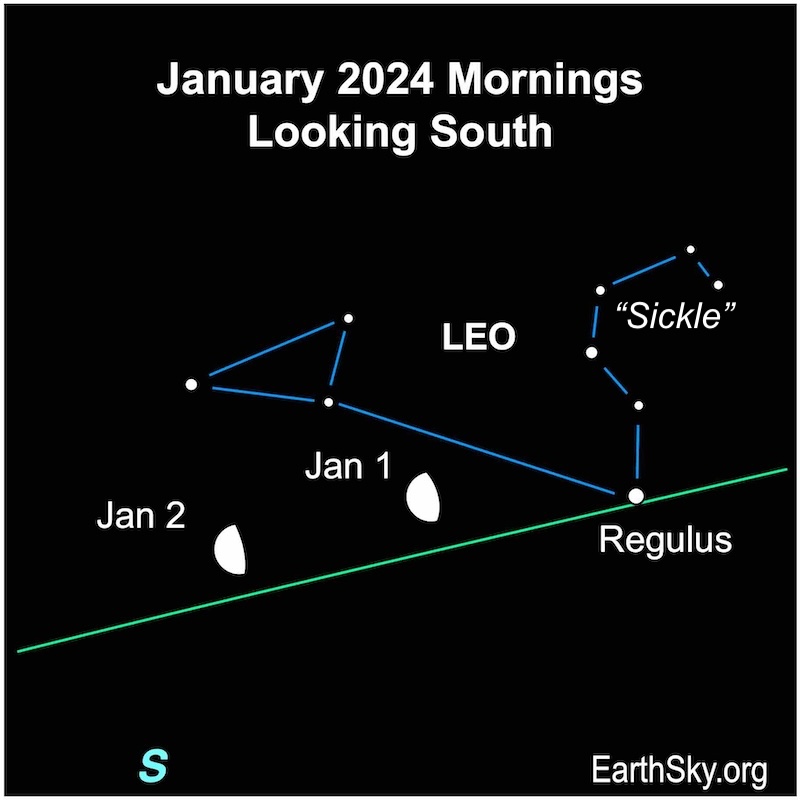
EarthSky Minute: January 1-4
Join EarthSky’s Marcy Curran for a 1-minute video preview of the best sky events for January 1-4.
Moon at apogee January 1
The moon will reach apogee – its farthest distance from Earth in its elliptical orbitaround Earth – at 15 UTC (10 a.m. CST) on January 1, 2024, when it’s 251,598 miles (404,909 kilometers) away.
January 2-3: Earth closest to the sun
For 2024, the Earth’s closest point to the sun is called perihelion. It comes at 1 UTCon January 3 (8 p.m. CST on January 2).
EarthSky Minute: January moon phases
Join EarthSky’s Marcy Curran for a 1-minute video preview preview of the moon phases – and dates when the moon visits planets – for the month of January.
January 3-4: Last quarter moon
The instant of last quarter moon will fall at 3:30 UTC on January 4, 2024 (10:30 p.m. CST January 3). It’ll rise around midnight your local time and will set around noon.
January 4 morning: Quadrantid meteor shower
The predicted peak of the Quadrantid meteor shower is on the early morning of January 4, 2024. A bright last quarter moon will rise around midnight and shine the rest of the night. Try observing late night January 3 to dawn January 4, in moonlight.
January 4 and 5 mornings: Moon near Spica
On the morning of January 4 and 5, 2024, the waning crescent moon will hang near the bright star Spica. Spica is the brightest star of Virgo the Maiden.

Our charts are mostly set for the northern half of Earth. To see a precise view – and time – from your location, try Stellarium Online.
January 6 and 7 mornings: Moon near Zubenelgenubi
On the mornings of January 6 and 7, 2024, the waning crescent moon slides past a star with a strange sounding name: Zubenelgenubi. Zubenelgenubi means “Southern Claw” in Arabic. Many people used to consider this star as part of Scorpius the Scorpion. But today it’s part of Libra the Scales. Nearby are the planets Venus and Mercury and the bright star Antares.
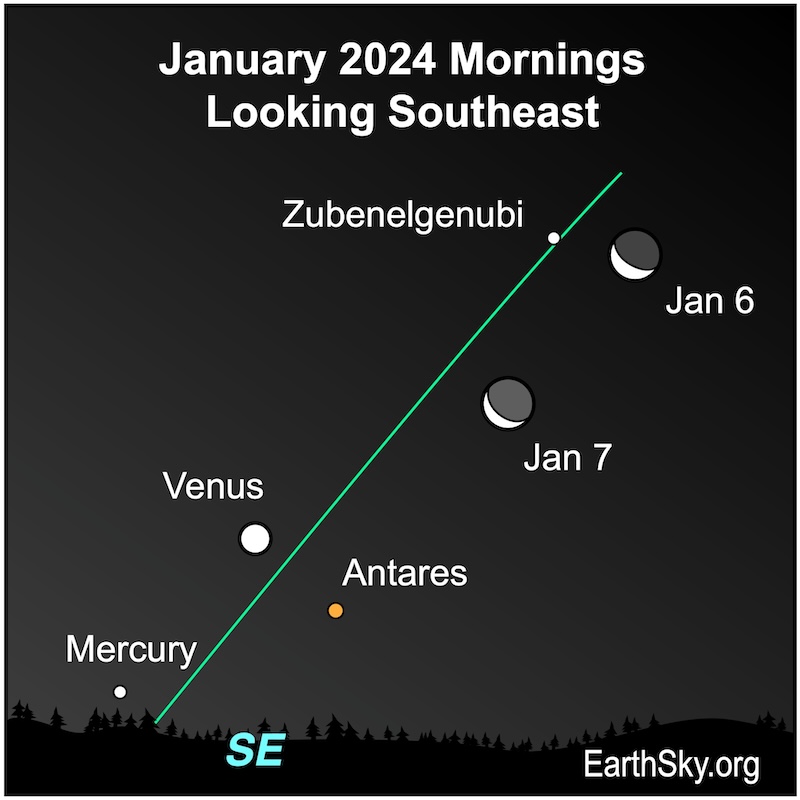
January 8 and 9 mornings: Moon near Venus, Mercury and Antares
On the morning of January 8, the thin waning crescent moon will lie next to the bright star Antares in Scorpius the Scorpion. Skywatchers in most of North America and part of South America will see the moon pass in front of – or occult – Antares. However, this event will occur in daylight. That morning, bright Venus will shine nearby. On the following morning, January 9, a thinner crescent moon will lie close to the horizon with Mercury nearby. Can you see a delicate glow on the unlit portion of the crescent moon? That’s earthshine! It’s reflected light from the Earth.
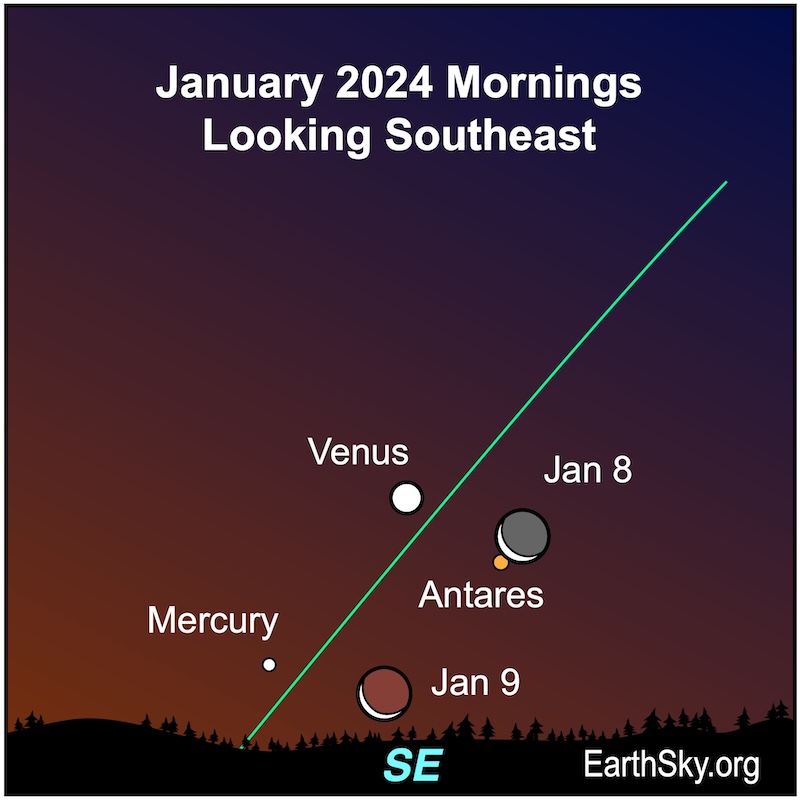
January 11: New moon
The instant of new moon will fall at 11:57 UTC (6:57 a.m. CST) on January 11, 2024. It’s a perfect time for stargazing under dark skies. The new moon rises and sets with the sun.
January 12: Mercury at greatest elongation
Mercury reaches greatest elongation – distance from the sun – in the morning sky at 15 UTC January 12, 2023.
Our charts are mostly set for the northern half of Earth. To see a precise view – and time – from your location, try Stellarium Online.
January 12 evening: Slender crescent moon near Saturn
Viewers with a low southwestern horizon and clear skies will spot the very thin waxing crescent moon in bright twilight shortly after sunset on January 12, 2024. Saturn will be the steady golden light higher in the sky. Check out the unlit portion of the moon. That lovely glow you see is earthshine, which is light reflected from Earth.

January 13: Moon reaches perigee
The moon will reach perigee – its closest point in its elliptical orbit around Earth – at 11 UTC (6 a.m. CST) on January 13, 2024, when it’s 225,102 miles (362,267 kilometers) away.
January 13 and 14 evenings: Moon near Saturn
Early on the evenings of January 13 and 14, 2024, the thin waxing crescent moon will pass Saturn. Also, look for earthshine, a glow on the unlit side of the moon. It’s reflected light from the Earth.

Our charts are mostly set for the northern half of Earth. To see a precise view – and time – from your location, try Stellarium Online.
January 15 and 16 evenings: Moon near the Circlet
The growing waxing crescent moon will pass the faint but distinct Circlet asterism in Pisces the Fish on the evenings of January 15 and 16, 2024. The moon and the Circlet will be visible after darkness falls and will set before midnight.
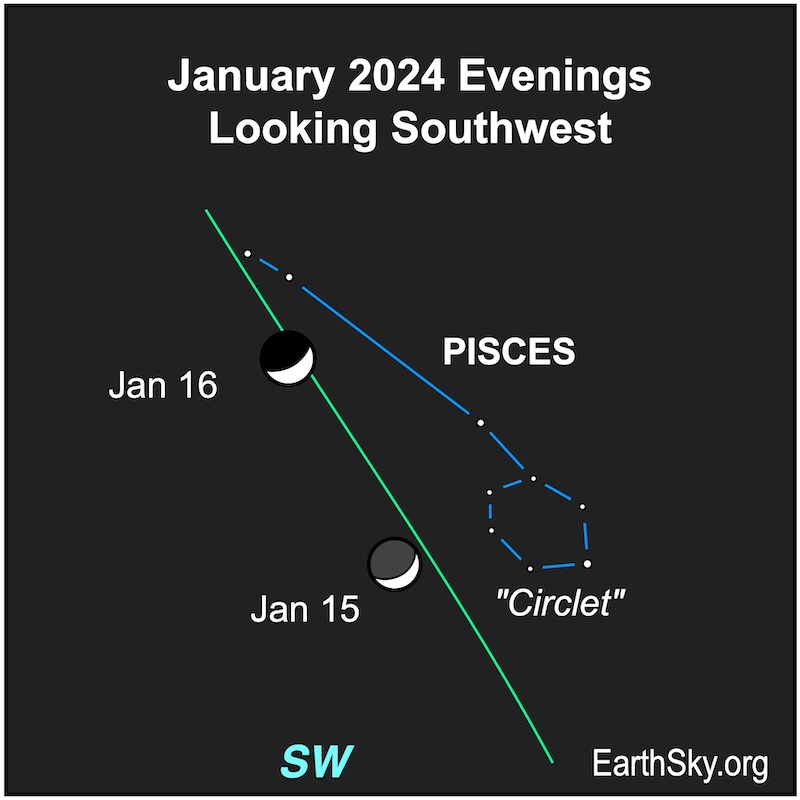
January 18: 1st quarter moon
The instant of 1st quarter moon will fall at 3:53 UTC (10:53 p.m. CST on January 17), on January 18, 2024. The 1st quarter moon rises around noon your local time and sets around midnight.
January 17 and 18 evenings: Moon near Jupiter
On the evenings of January 17 and 18, 2024, the 1st quarter moon will glow near the bright planet Jupiter. The moon and Jupiter will set around midnight.
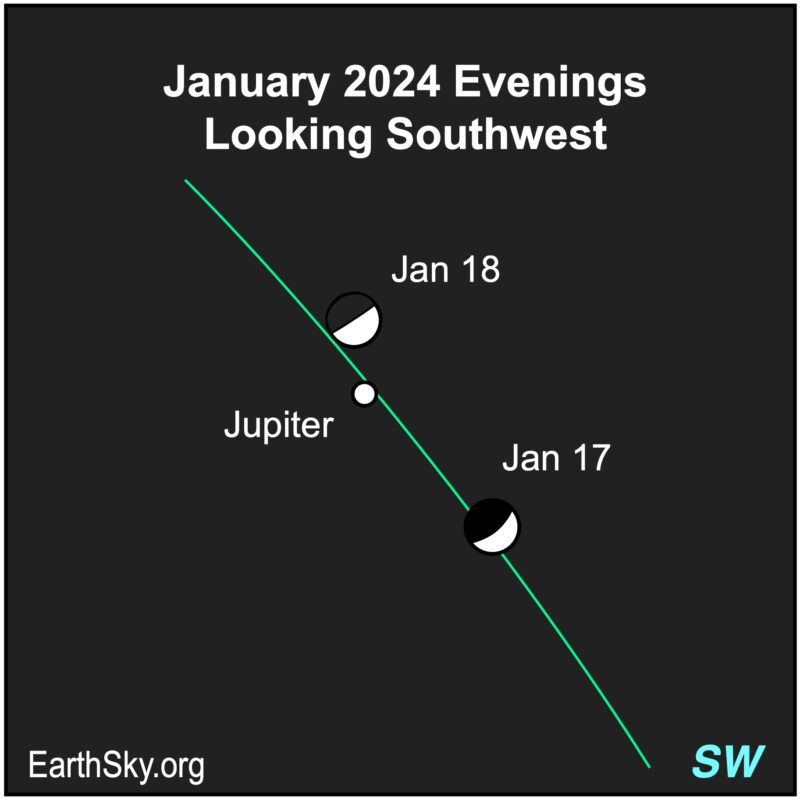
January 19 and 20 evenings: Moon near Aldebaran and the Pleiades
The bright waxing gibbous moon will pass the Pleiades star cluster on the evenings of January 19 and 20, 2024. The Pleiades is also known as the Seven Sisters or Messier 45 and appears as a glittering, bluish cluster of stars in the constellation Taurus the Bull. It’ll also be near the fiery orange star Aldebaran. The moon and Pleiades will cross the sky together and set after midnight.
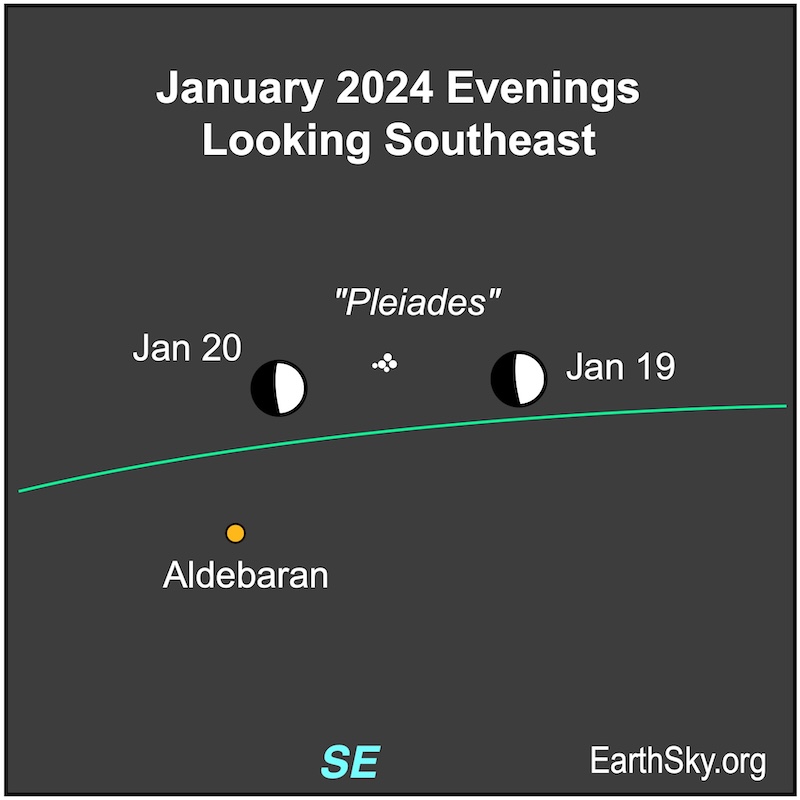
Our charts are mostly set for the northern half of Earth. To see a precise view – and time – from your location, try Stellarium Online.
January 21 evening: Moon near Capella, Aldebaran and Betelgeuse
On January 21, 2024, the bright waxing gibbous moon will lie within a triangle formed by three bright stars. It’ll be near the fiery orange star Aldebaran of Taurusthe Bull and Orion’s mighty red supergiant star Betelgeuse. The bright, golden star is Capella of the constellation Auriga the Charioteer. If you catch Capella low on the horizon, it may be flashing like a small disco ball. You can follow them all night until about an hour before dawn.
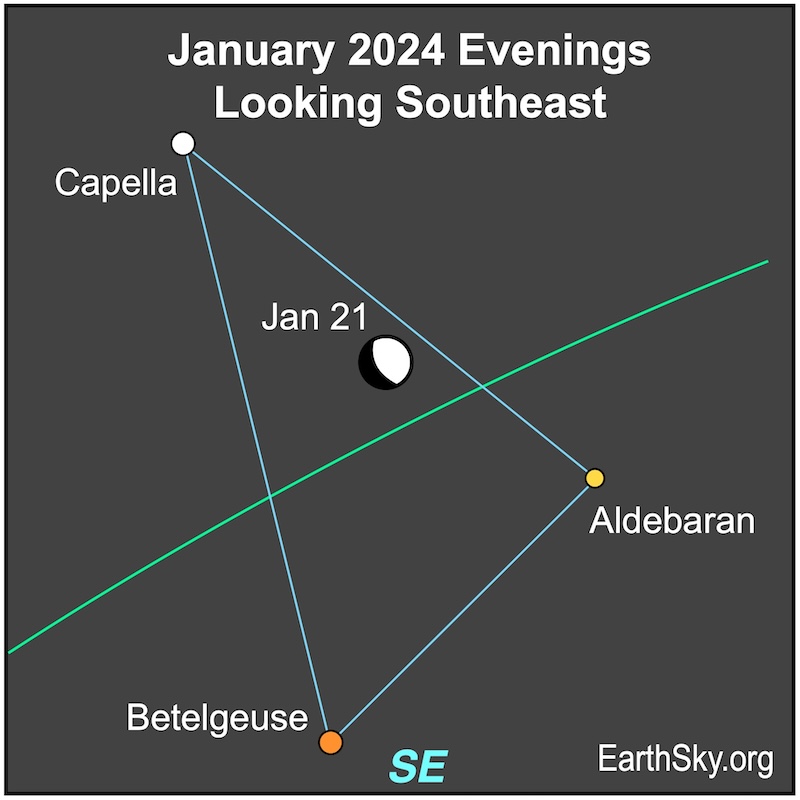
January 22, 23, and 24 evenings: Moon near Castor and Pollux
On the evenings of January 22, 23, and 24, 2024, the bright waxing gibbous moon will pass Castor and Pollux, the twin stars of Gemini. They’ll rise a few hours after sunset and travel across the sky’s dome until a little before sunrise.
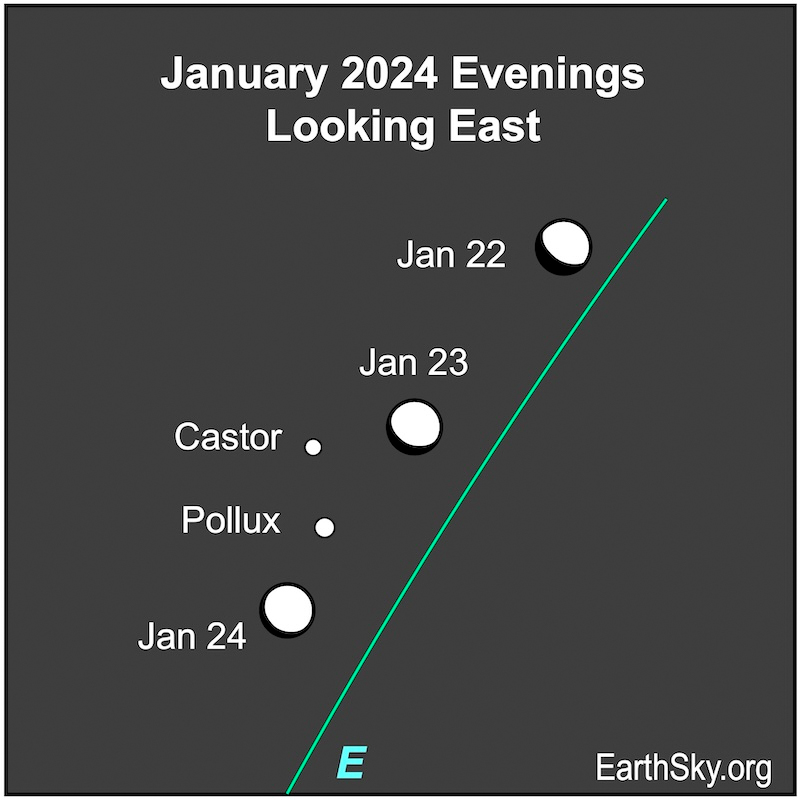
January 25, all night: Full Wolf Moon
The instant of full moon – the Wolf Moon – will fall at 17:54 UTC on January 25, 2024 (12:54 p.m. CST). It will be near the twin stars Castor and Pollux, of Gemini the Twins.
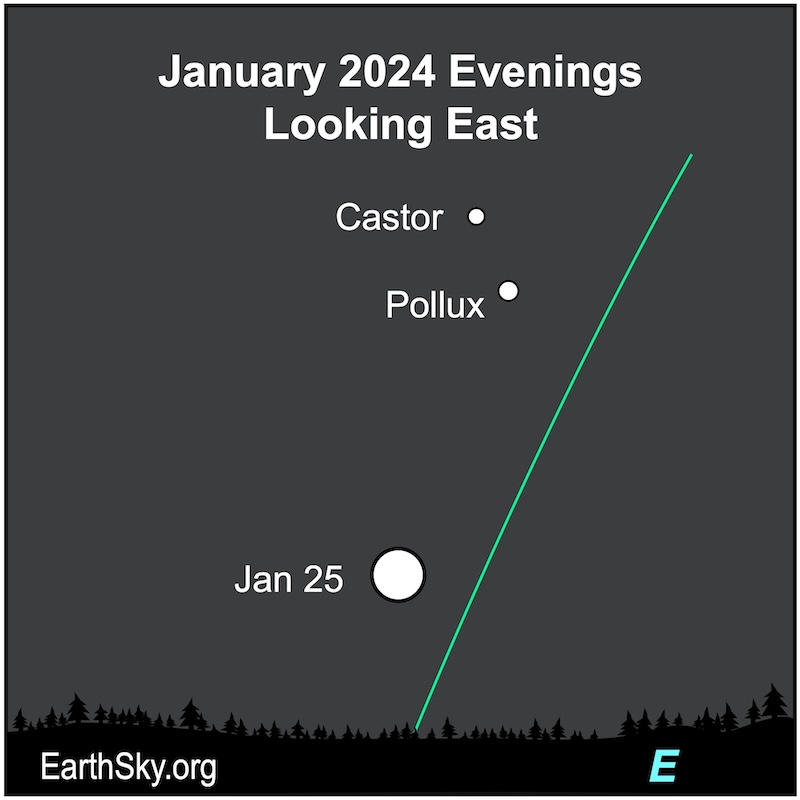
Our charts are mostly set for the northern half of Earth. To see a precise view – and time – from your location, try Stellarium Online.
January 26 and 27 evenings: Moon near the Sickle
On the evenings of January 26 and 27, 2024, the waning gibbous moon will float near Regulus, marking the bottom of the backward question mark asterism called the Sickle. Regulus is the brightest star in Leo the Lion. They’ll be visible most of the night.
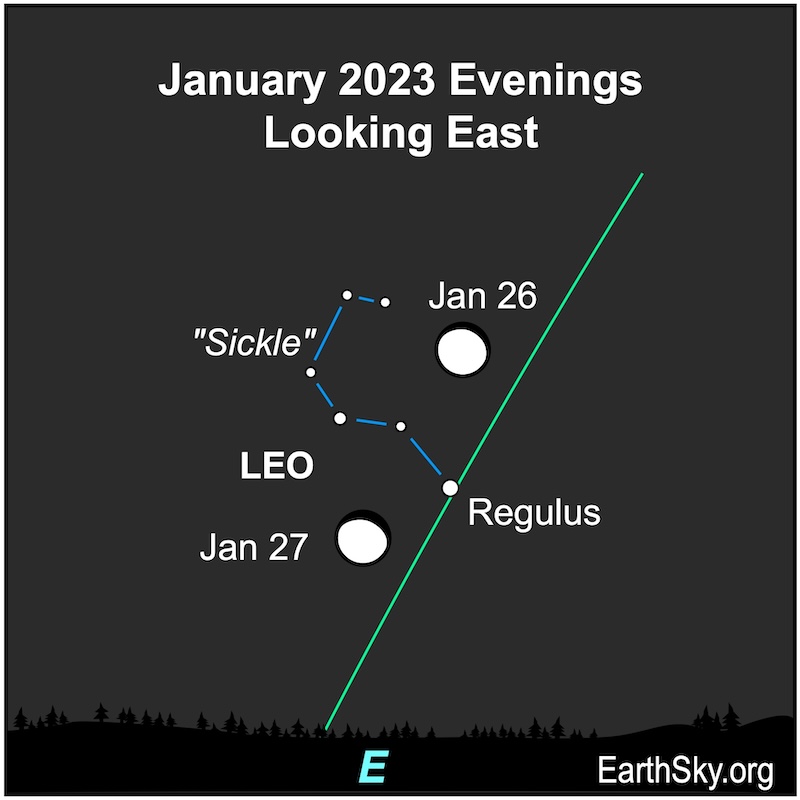
Moon at apogee January 29
The moon will reach apogee – its farthest distance from Earth in its elliptical orbitaround the Earth – at 8 UTC (3 a.m. CST) on January 29, 2024, when it’s 252,138 miles (405,777 kilometers) away.
January 31 morning: Moon near Spica
On the final morning of January, the waning gibbous moon will hang near the bright star Spica in Virgo the Maiden.
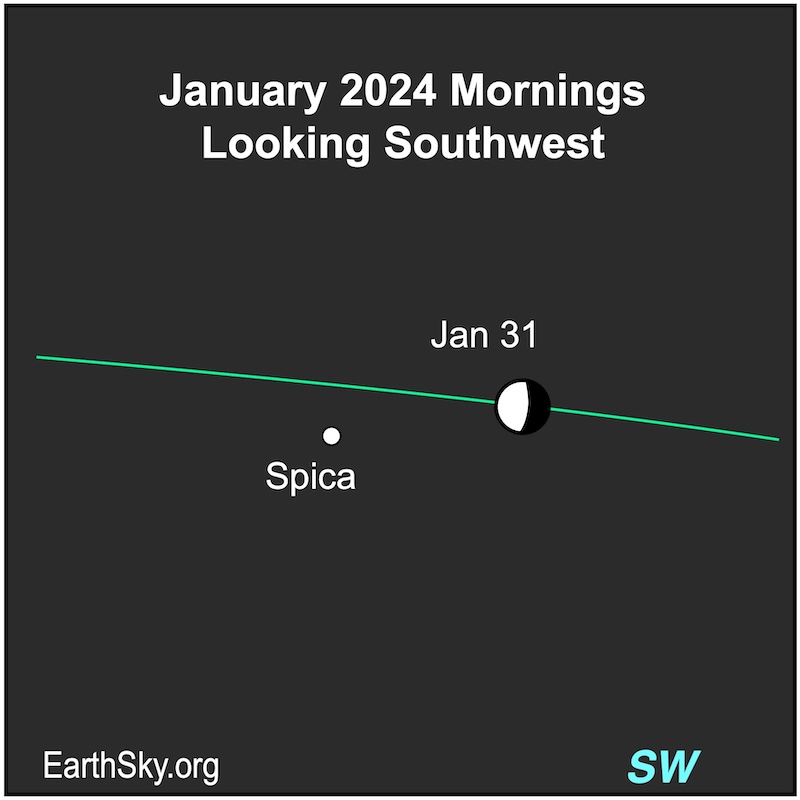
Our charts are mostly set for the northern half of Earth. To see a precise view – and time – from your location, try Stellarium Online.
Planets in January 2024
January mornings: Venus
In January, the blazing light of Venus will continue to draw your attention in the morning sky. In fact, it will remain in the morning sky through March. However, it sinks lower each morning after it reached its greatest elongation – farthest distance from the sun in our morning sky – from the sun in October. Venus will shine all month at -4.0 magnitude. A lovely waning crescent moon will join Venus on the morning of January 8, 2024. The bright reddish star Antares will be nearby. Venus begins the month in the constellation Scorpius the Scorpion and will move into Ophiuchus the Serpent Bearer by mid-month. Then by month’s end, it will be in the constellation Sagittarius the Archer.
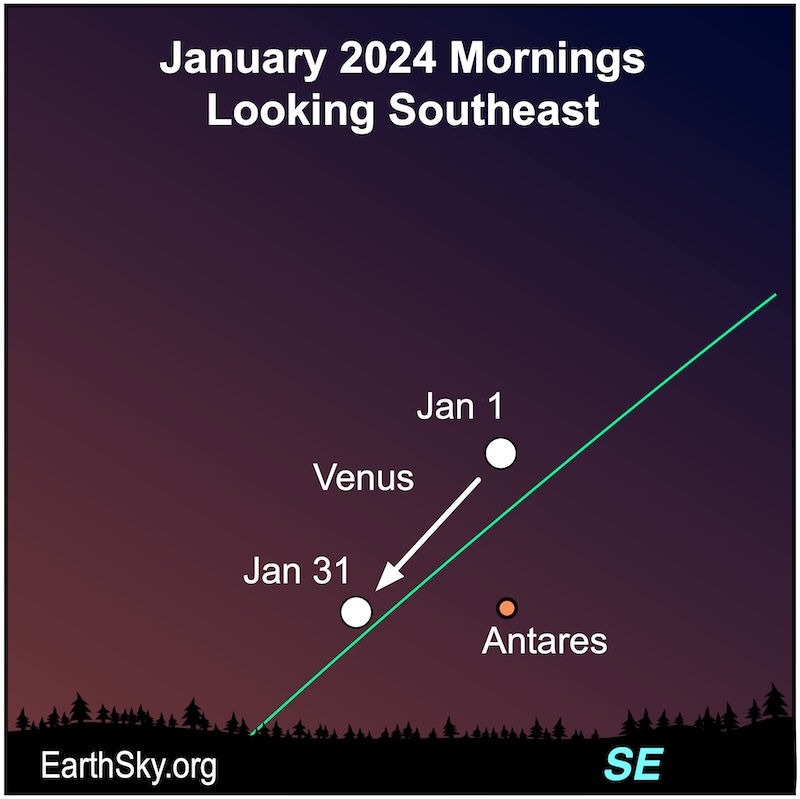
January mornings: Mercury
For viewers in the Northern Hemisphere, Mercury lies just above the horizon in the bright twilight shortly before sunrise in January. It’ll reach its greatest western elongation – farthest distance from the sun in our morning sky – on January 12, 2024. At best, Mercury reaches 24 degrees from the sun on that day. It will continue to brighten after greatest elongation and then disappear from the morning sky in February. The Southern Hemisphere will have the better view. The moon will lie near Mercury on the morning of January 9, 2024. Also, higher in the morning sky will be the brilliant light of the planet Venus.
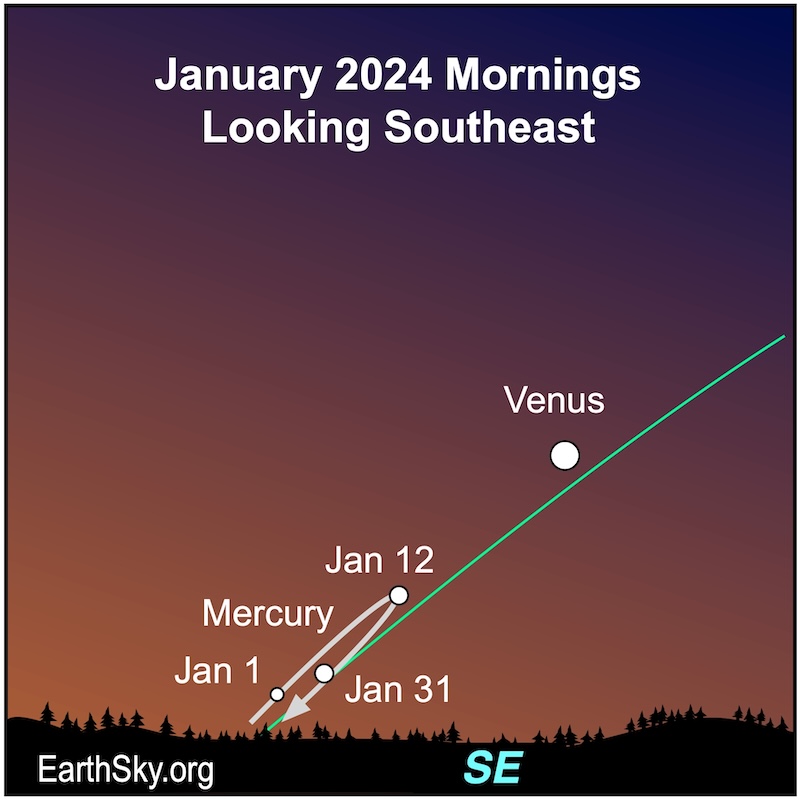
January evenings: Jupiter
Bright Jupiter will draw your attention until after midnight in January 2024. It will be very obvious high in the southern sky at sunset and will be visible until a few hours after midnight. It will shine near the pretty Pleiades star cluster in the constellation Taurus the Bull. Jupiter reached perihelion – or closest point to the Earth – in early November. And it reached opposition overnight on November 2-3, 2023, when we flew between it and the sun. So, as Jupiter recedes from Earth, it’ll fade a bit in our sky. It will lie in the dim constellation Aries the Ram. It will shine at -2.2 magnitudeby month’s end. The 1st quarter moon will float by Jupiter on January 18, 2024.
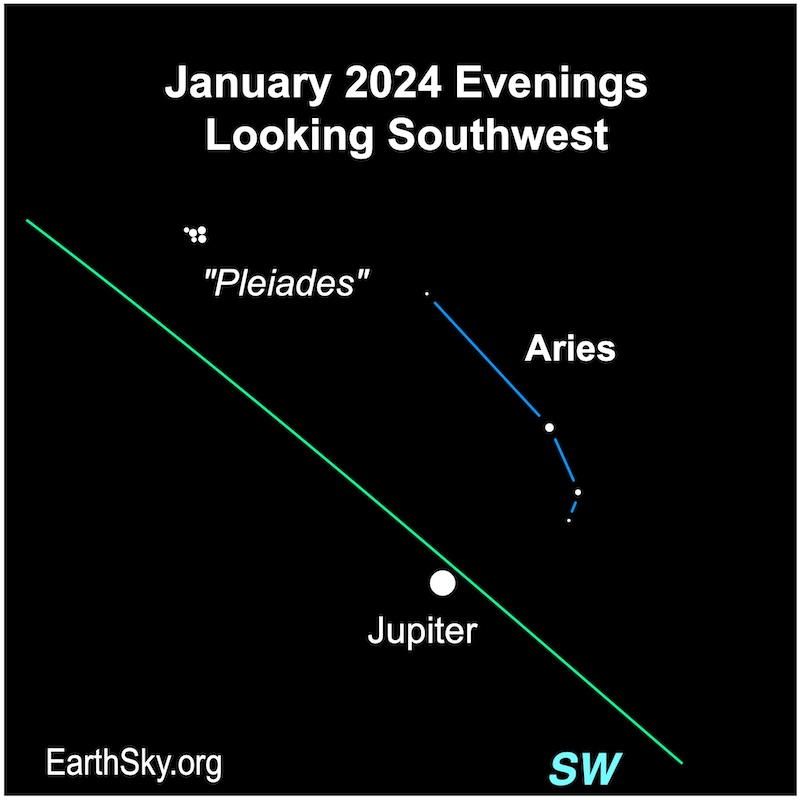
January evenings: Saturn
Golden Saturn will shine low in the southwest after sunset during January. It will be in the dim constellation Aquarius the Water Bearer. Our solar system’s beautiful ringed planet will be fading a bit this month as it recedes from Earth and will shine at +0.9 magnitude for most of the month. It shines near a star of similar brightness, Fomalhaut. Saturn will descend closer to the horizon each day, slipping out of the evening sky by February. The waxing crescent moon will visit Saturn on the evening of January 14, 2024. Saturn will set a few hours after the sun this month.
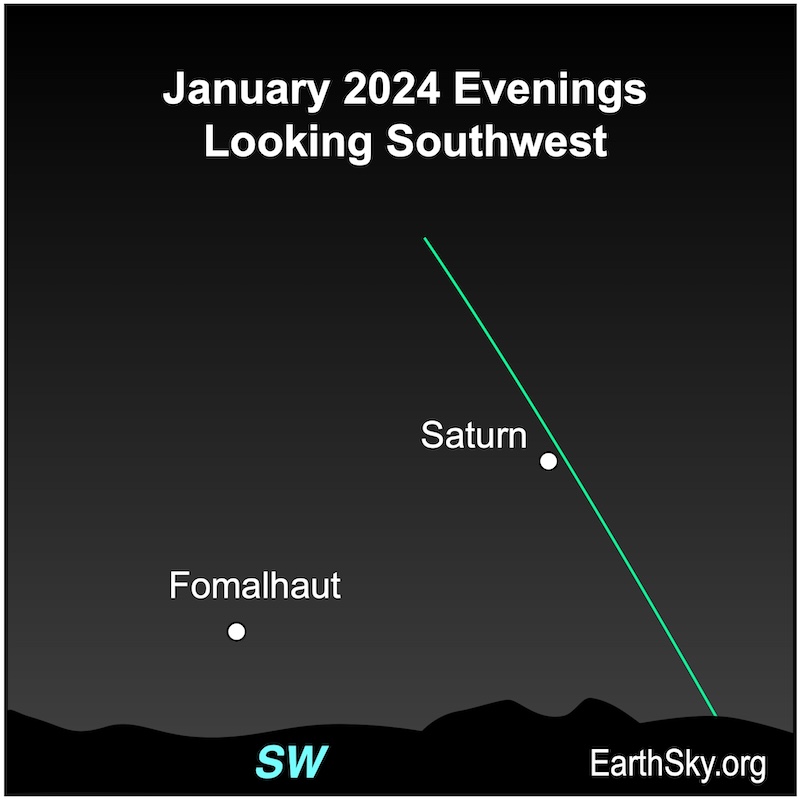
Where’s Mars?
Mars will be emerging low in the morning sky toward the end of the month. It’ll be a morning object for all of 2024. On the morning of January 27, 2024, it’ll be 0.2 degrees from Mercury. Mars will be within 0.6 degrees – as seen from Earth – of each of the other planets over a 7-month period. By the way, Mars will not reach opposition until January 2025. Opposition is when Earth flies between the sun and an outer planet and marks the the best time to see an outer planet. Mars reaches opposition about every two years, and some oppositions are better than others.
Thank you to all who submit images to EarthSky Community Photos! View community photos here. We love you all. Submit your photo here.
Looking for a dark sky? Check out EarthSky’s Best Places to Stargaze.
Sky dome maps for visible planets and night sky
The sky dome maps come from master astronomy chart-maker Guy Ottewell. You’ll find charts like these for every month of 2023 in his Astronomical Calendar.
Guy Ottewell explains sky dome maps
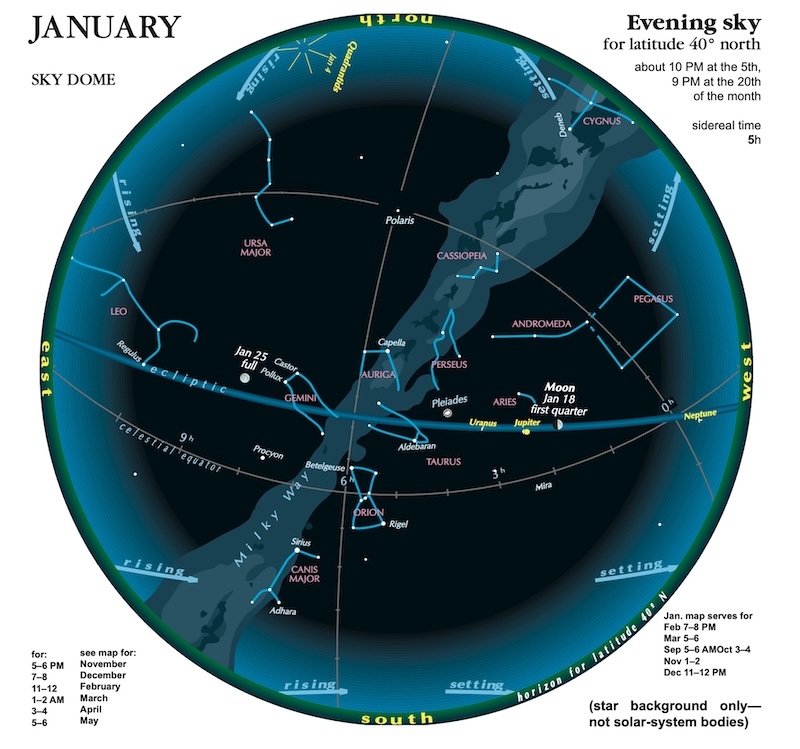
Heliocentric solar system planets
The sun-centered charts come from Guy Ottewell. You’ll find charts like these for every month of 2023 in his Astronomical Calendar.
Guy Ottewell explains heliocentric charts.
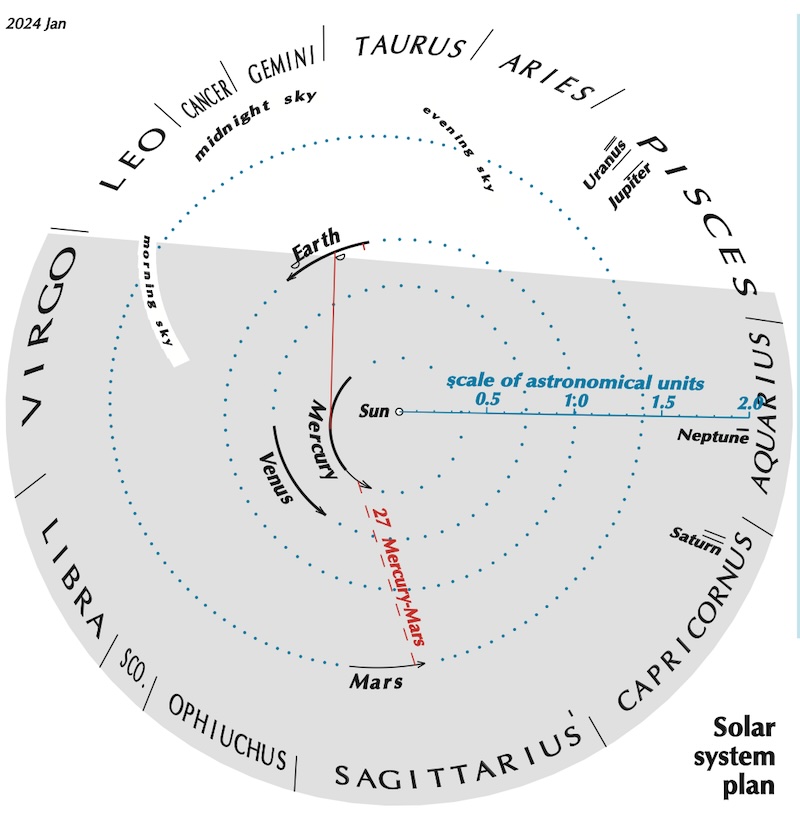
Some resources to enjoy
For more videos of great night sky events, visit EarthSky’s YouTube page.
Watch EarthSky’s video about Two Great Solar Eclipses Coming Up
Don’t miss anything. Subscribe to daily emails from EarthSky. It’s free!
Visit EarthSky’s Best Places to Stargaze to find a dark-sky location near you.
Post your own night sky photos at EarthSky Community Photos.
Translate Universal Time (UTC) to your time.
See the indispensable Observer’s Handbook, from the Royal Astronomical Society of Canada.
Visit Stellarium-Web.org for precise views from your location.
Almanac: Bright Planets (rise and set times for your location).
Visit TheSkyLive for precise views from your location.
2) Planet Highlights:
The new year finds orange Mars at its brightest of the entire year! Both Mars and Jupiter dominate the evening sky. Look about 45 minutes after sunset towards the southwest. First, spot Jupiter as it’s brighter than all the stars. Then look to Jupiter’s left (about 60 degrees) and a little higher in the sky to find the planet Mars.
Now look below and slightly right of Jupiter (a little less than 40 degrees) to see Saturn just above the southwest horizon. As the days pass, Saturn may be difficult to see so near the horizon; you’ll need a clear view.
Meanwhile, Venus is at its dimmest of 2023. However, Venus is on an upward trajectory, appearing higher and brighter each evening, climbing out of the sunset twilight by mid-month.
See Planet Rise and Set times for your location.
Visible Planets: Highlights
January 3: Don’t miss this super-close meeting of the Moon and orange Mars, still very brilliant since its opposition and closest-approach happened only a few weeks ago in early December. City lights can’t spoil this one. A backyard telescope can boost the fun by revealing the northern Martian polar cap and some dark surface markings.
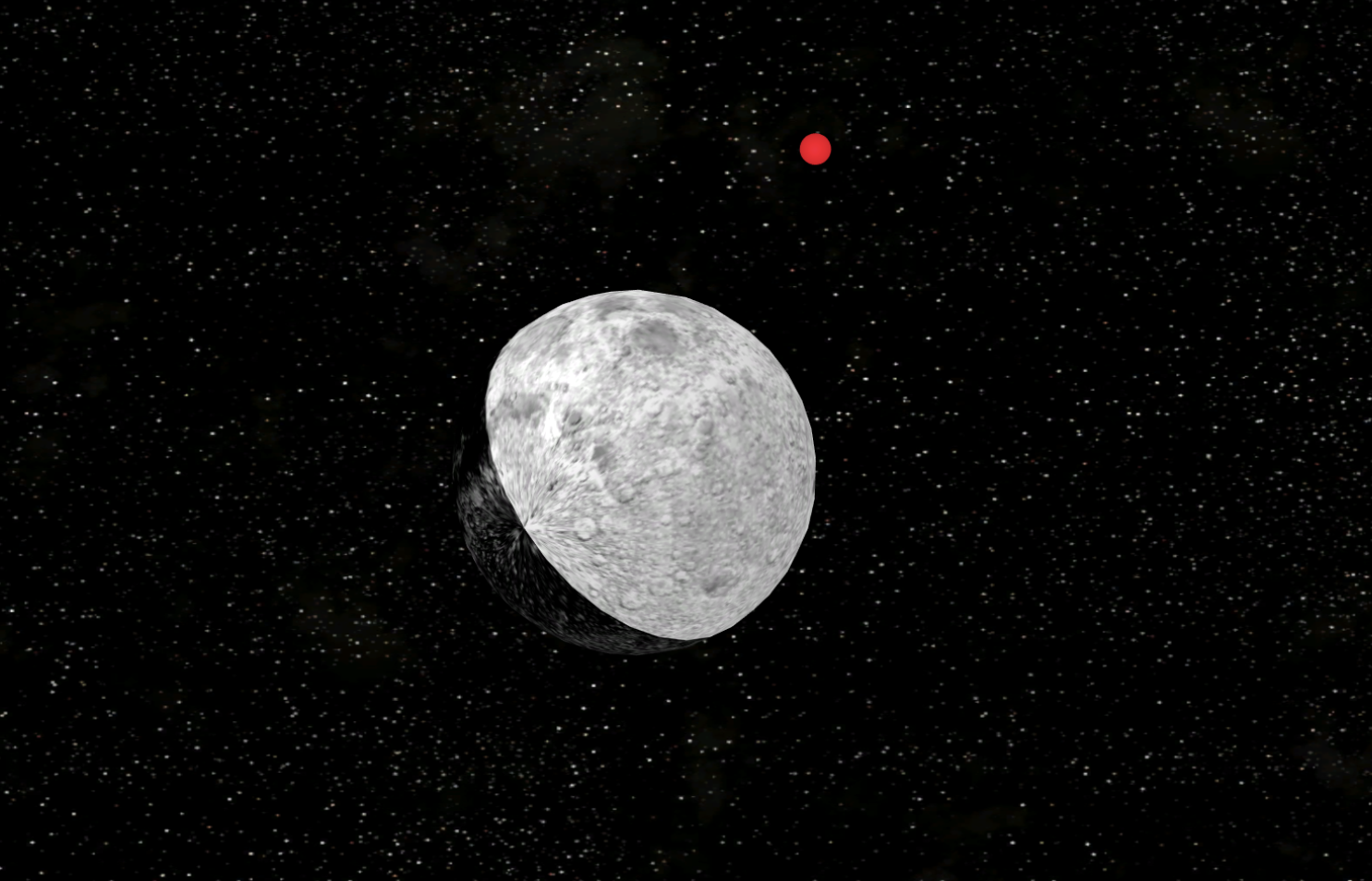
January 4: It’s the year’s closest approach to our great star, aka the perihelion. This is the point in Earth’s orbit when it’s closest to the Sun, though it’s still about 91.4 million miles away!
January 21–22: Observers will enjoy watching Venus and Saturn draw closer every night. On the 21st, Venus is only a degree below Saturn. Then on the 22nd, the two planets meet—less than a quarter degree apart. Look low in the southwest at around 4:45 PM. Though just 10° high, which necessitates an ocean-flat horizon (don’t bother if hills, trees, or houses block the horizon in this direction), the extreme super-brilliance of Venus makes that Evening Star a don’t-miss target, especially with that little “star” (the planet Saturn) hovering next to it in the fading dusk.
January 23: Venus appears about a degree above Saturn. While not as close together tonight, the scene is more than compensated by the thin crescent Moon now to their upper left. A Three-For-One special! But quite low at 4:45 PM so once again you need a flat horizon.
January 24–25: On the 24th, the crescent Moon appears between Venus and Jupiter, and on the 25th, Jupiter is that brilliant “star” just above the Moon tonight. High up, easily seen from cities, and never mind watching the clock. Anytime after 5 PM will work.
January 30: The Moon closely meets Mars for the second time this month. Still in the constellation Taurus, look at how much that orange “star” has faded since its January 3 conjunction, as Earth keeps racing away from it at 66,000 mph.
Other features of this month’s sky:
JANUARY 1: BRIGHT SIRIUS
Begin January by finding bright Sirius, the Dog Star, in the night sky! Sirius is the brightest star above, so it’s easy to find. If you’re not sure, find the belt of the constellation Orion and follow it downward. Orion’s Belt always points to Sirius. Learn more about Sirius.
JANUARY: THE QUADRANTID METEORS
(courtesy of almanac.com and https://www.adlerplanetarium.org/blog/what-to-see-stargazing-tips-january-2022/)
The Quadrantids are the first major meteor shower of the year, peaking the night of Monday, January 3 into the morning of the 4th. Unfortunately, in 2023, the Moon will be 92% full, obscuring the fainter meteors. Your best bet is to view after the Moon sets on the 4th of January, just before dawn.
Full Moon (The “Wolf Moon”: Friday, January 6, at 6:09 P.M. EST)
Seasons of 2023 |
Astronomical Start |
Meteorological Start |
|---|---|---|
| SPRING | Saturday, March 20, 2:24 P.M. PDT | Monday, March 1 |
| SUMMER | Sunday, June 21, 7:58 A.M. PDT | Tuesday, June 1 |
| FALL | Wednesday, September 22, 11:50 P.M. PDT | Wednesday, September 1 |
| WINTER | Tuesday, December 21, 7:27 P.M. PST | Wednesday, December 1 |

2023 Eclipses
(courtesy of timeanddate.com)
Please go to the following link to learn where you can enjoy 2023 eclipses:
https://www.timeanddate.com/eclipse/2023
January 2023 Phenology:
Gray Whale Migration: Frequent Flyer Journeys
Giant mammals are now gliding past our coast on their journey south from feeding grounds in the Bering Sea to calving grounds near Baja California. Gray whales (Eschrichtius robustus) migrate more than 12,000 miles each year. Given they migrate close to shore, you may be able to see them from land along the Sonoma coast, at Pt. Reyes, and in Big Sur. Watch for the low, puffy (some call them heart-shaped) spouts produced when the whales exhale — with Point Reyes National Seashore’s lighthouse one of the best venues to view this phenomenon.
By Sea & Shore: Elephant Seals Are Currently “Must See” Viewing
Northern Elephant Seals (Mirounga angustirostris) spend most of their life in the open ocean, diving up to 5,000 feet to feed on pelagic fish and squid. They come ashore only to mate, give birth, and molt their old skin and hair. By January, female Northern Elephant Seals have returned to breeding beaches to give birth. The one 75-pound pup she produces each year gains 10 pounds a day as it nurses on her extra-rich (50% fat!) milk. Pups typically nurse for 28 days. After the pups are weaned, females mate with one or more of the dominant males before leaving the beaches. By mid-March all the adults are gone, leaving the pups to fend for themselves. In the ultimate Survivor test, the pups (now called weaners) must learn to swim and catch fish on their own. Once they’ve mastered these basic skills, the pups take to the sea, heading north to feed off the coast of Washington and British Columbia. They won’t return to land until the fall. In the Bay Area, you can see elephant seals pups at Chimney Rock in Pt. Reyes, or on a naturalist-led tour (reservations required) at Año Nuevo State Reserve.
Stinky Blooms Delight Senses
While its name sounds like an unpleasant affliction, Fetid Adder’s Tongue (Scoliopus bigelovii) is actually a lovely wildflower. January is a good time to start searching for this diminutive lily relative along trails in redwood forests. Three small, cream and maroon-striped sepals surround three delicate upturned petals and three stamens. The odorous blooms fade quickly but the dramatic mottled leaves persist for several months.
After tiny fungus gnats pollinate the flowers, the seed capsules’ weight pulls the stems to the ground, giving the plant its other common name, “Slink Pod.” Slugs and ants may help spread seeds. In Marin County, look for Fetid Adder’s Tongue in Muir Woods National Monument, Mount Tamalpais (Blithedale Canyon, Cataract Gulch, Fish Grade), Bolinas Ridge, San Geronimo Ridge, and San Rafael Hills. On the Peninsula, it may be found in early January along Crystal Springs Trail in Huddart County Park (Woodside) and later in the month along the Hazelnut Trail in San Pedro County Park (Pacifica).
Early Wildflower Bloom: 2023 Forbs/Ephemerals
Given our ample rainfall in 2022 and in early January, 2023, it will soon be time to enjoy blooming wildflowers. Where are excellent spots to enjoy their beauty and dozens of other colorful wildflowers? Check out:
Annadel State Park, Santa Rosa, CA, Sonoma County
Chimney Rock (near the Lighthouse, Outer Point, Point Reyes National Seashore), Inverness, CA, Marin Co.
Edgewood County Park (south of SF), off I-280 and adjacent to it, San Mateo County
Black Diamond Mines Regional Park (ebparks.org), near Antioch and, especially, on Somersville Road (that exits off of Highway 4), East Bay of SF Bay
Are Herring Here Yet?
Please note…..For herring infusion updates into the SF Bay, see: https://cdfwherring.wordpress.com/
Watch for frenetic collections of gulls, scoters, cormorants, and sea lions within shallow spots of the Bay. Their presence is an indication that Pacific Herring have made their annual arrival. As early as November, yet sometimes waiting until this time of year, adult males and females seek spawning (i.e., egg laying) locations in shallow intertidal and subtidal waters. A single female may lay as many as 20,000 eggs in one spawn following ventral contact with submerged substrates such as eel grass. Why spawning begins is not understood, but some researchers believe the male initiates the process by release of milt (the seminal fluid of herring) that contains a pheromone that stimulates a female to begin egg laying. Egg laying appears to be collective so that an entire school may spawn in the period of a few hours, producing an egg density of up to 6,000,000 eggs per square meter.
Pop Quiz:
Which bird species is probably the earliest breeder in Marin County?
Answer: Early nesting Anna’s hummingbirds may lay eggs this month or, in some cases, last month. More information about hummingbirds in California appears in the next account.
Note that some Anna’s Hummingbirds exhibit nesting/courtship behavior by October. I noticed this phenomenon in my backyard’s forested/open woods area this past autumn. The loud “pop” of diving males was heard regularly in our autumn landscape.
Of course, a second (and third brood) of Anna’s may result from the most prolific breeders of this species. Not that any male Anna’s would know about their brethren. That’s because the male Anna’s never bonds with his female partners. All males merely provide the “seed” by which newcomers develop in females, but they are left to fend for themselves on the nest. Males opt for quickly exiting Stage Left after impregnating their suitors. For this reason, you might say Anna’s males take “Speed Dating” to a new avian level and meaning.
Hummingbirds In California: Early Breeders
Anna’s Hummingbirds, year-round residents in northern California (and throughout much of the state), may already be laying eggs — perhaps initiating courtship and/or nesting as early as December (!). Some early-nesting females will play hostess to two broods during the breeding season, with second clutches hatching as late as mid-August. Peak breeding and greatest nest abundance occurs in May. Amazing but true, this year’s initial breeding cycle began in October in Marin County where I live. That’s when I began seeing courtship dances by male Anna’s on my land. Whether the females were receptive then is another question that remains unproven.
Research studies have indicated this hummer species memorizes and learns a song in its first year of life, similar to the behavior of most songbirds. Allen’s Hummingbirds, which breeds from s. California to s. Oregon, begin to arrive annually in the SF Bay Area early as mid-January after spending the winter in Baja California and Chihuahua in Mexico. Some of the arrivals may remain to breed in the area.
Other populations of this species are year-round residents in southern California.
Their preferred habitat is canyon woodlands, brush and highland meadows. This species breeds in the Bay Area, but by the end of July many have dispersed and/or left the Bay Area, and in mid- to late-August most of the species’ population has migrated south.
Rufous Hummingbirds are seen only during migration in California, except for the extreme northern part of the state where their breeding area begins (and stretches north throughout much of Oregon, all of Washington, and into parts of Idaho, Montana and Wyoming, as well as into British Columbia, Alberta and southeast Alaska). In Marin County, expect to begin seeing this transient species as early as mid-February, with a peak presence from mid-March through mid-April. By the end of May, Rufous are typically absent in Marin Co. The autumn migration spectrum is from mid-June through September in Marin Co., especially outside the County amid the Inner Coast Ranges, but sometimes along the coast, too.
Other hummingbirds occur in California, of course, but the aforementioned three species are usually the most common ones to see in the Bay Area/Marin County. Calliope, and Costa’s Hummingbird, and Black-Chinned Hummingbird are sometimes observed in the Bay Area, though the initial two of these three species is considered a “casual visitor” to Marin County (and Black-Chinned the most rare, yet still considered a “casual visitor”) — with all three occasional to common casual visitors in more eastward Bay Area counties.
See above for more information about the breeding dynamics of Anna’s Hummingbird in N. CA/the Bay Area.
Swallows During Winter In Northern California?
They are never a common sight, but it’s possible to see the following swallow species in Marin County (and the Bay Area) during the winter in the following order, from most common to rare: Tree (now annual during the non-breeding season in Marin County), Barn (not always annual, but typically seen during most “winters” in the Bay Area), and Violet-green (likewise, not always annual during the non-breeding season, yet often reported from November-February before migrants return to breed in the Bay Area). Our other northern California summer residents — Northern Rough-Winged, Cliff, and Bank — are considered rare to absent in January, though they may return on migration by no later than the end February during some to most years.
Purple Martin are also typically absent from our area in January and February. As for swift species, White-Throated are by far the most typical one to see, if any, from January-March, and they are considered year-round residents in the SF Bay Area. Vaux’s return on migration in April, while the more uncommon to “casual visitor” swift species — Chimney and Black — are usually spotted (if at all) from May through mid-October in northern California.
Checklists specific to a Bay Area region sometimes miss indicating the aforementioned swallows are potential winter sightings. I’ve noticed, for example, more reports by excellent birders in recent years of over-wintering Tree and Barn in the Bay Area. To wit, in the past, many of the same birders in the Bay Area used to believe that Tree Swallow completely left the Bay Area as an autumn migrant. Now, that dynamic has changed. Instead, Tree Swallow (and, increasingly, Barn Swallow) are considered a regular non-breeding season inhabitant (in small numbers) throughout the Bay Area (e.g., Las Gallinas Wildlife Ponds, San Rafael, Marin Co.).
Hibernating Birds in Our Area?
Not exactly. But our Common Poorwill (Phalaenoptilus nuttallii californicus) (also called the Dusky Common Poorwill as the nominate race among five subspecies in the species) does exhibit winter torpor. According to Wikipedia, the Common Poorwill is the only bird known to go into torpor for extended periods (weeks to months). Such an extended period of torpor is close to a state of hibernation, a condition not known among most other birds. It was described definitively by Dr. Edmund Jaeger in 1948 based on a Poorwill he discovered hibernating in the Chuckwalla Mountains of California in 1946.
By the way, don’t let this bird’s name fool you. It’s never “common” where we live in northern California. In Marin County, one of the best spots to see Common Poorwill is along open areas, hillsides and talus slopes on Mount Tamalpais. More typical, I hear this bird’s vocalizations only and, if I’m lucky, then find it. Tilden Park in Berkeley periodically hosts this species, too. My BEST success for finding this species is in Lake County’s higher altitude spots as they flee from perches on the road at dawn while I’m riding on backroads.
February, 2024
Sky Watch:
1) Moon & Planet Rise & Set Times
Go to: https://www.timeanddate.com/astronomy/night/
Then type in your location to see planet highlights for each day of the month.
For my area in February, 2024, here’s planet viewing information:
| Planetrise/Planetset, Tue, Feb 1, 2022 | ||||
|---|---|---|---|---|
| Planet | Rise | Set | Meridian | Comment |
| Mercury | Wed 6:00 am | Wed 4:03 pm | Wed 11:01 am | Difficult to see |
| Venus | Wed 4:56 am | Wed 3:15 pm | Wed 10:06 am | Great visibility |
| Mars | Wed 5:05 am | Wed 2:30 pm | Wed 9:47 am | Average visibility |
| Jupiter | Tue 8:28 am | Tue 7:31 pm | Tue 1:59 pm | Average visibility |
| Saturn | Tue 7:28 am | Tue 5:42 pm | Tue 12:35 pm | Extremely difficult to see |
| Uranus | Tue 11:06 am | Wed 12:45 am | Tue 5:55 pm | Difficult to see |
| Neptune | Tue 9:04 am | Tue 8:40 pm | Tue 2:52 pm | Very difficult to see |
All times are Pacific Standard Time at sea level.
Tonight’s Sky in Novato, Feb 1 – Feb 2, 2022 (7 planets visible)
Mercury rise and set in Novato
Fairly close to the Sun. Visible around sunrise and sunset only.
Wed, Feb 2↑6:00 am
Venus rise and set in Novato
View before sunrise.
Wed, Feb 2↑4:56 am
Mars rise and set in Novato
View before sunrise.
Wed, Feb 2↑5:05 am
Jupiter rise and set in Novato
View just after sunset.
Tue, Feb 1↓7:31 pm
Saturn rise and set in Novato
Very close to Sun, hard or impossible to see.
Tue, Feb 1↓5:42 pm
Uranus rise and set in Novato
View after sunset. Bring binoculars.
Wed, Feb 2↓12:45 am
Neptune rise and set in Novato
View after sunset. Use binoculars.
Tue, Feb 1↓8:40 pm
2) Planet Highlights (courtesy http://www.almanac.com):
- Early this month, Saturn materializes as a low morning star just before sunrise, joining higher-up Jupiter and Mars, all in Sagittarius. These three superior planets bunch closer together as the month progresses. It’s probably easiest to spot bright Jupiter; then look for Mars above and Saturn below.
- Venus: After sunset, Venus pops out at you as the brightest thing in the western sky. This shining beacon will continue to dazzle through the entire month as dusk falls. In the second half of the month, Venus is really the only bright object that appears in the west after sunset. It’s impossible to miss.
- Mercury: Look far to the lower right of Venus. Any “star” you see down there is Mercury! Look near the sunset point on the horizon shortly after sunset. During this month’s first 12 days, Mercury has its best showing of 2020 at a very bright magnitude 0, far below the more dazzling Venus, which stands 10 degrees high 40 minutes after local sunset. You no longer need telescope or binocoluars to find Mercury (though binoculars will help).
February Moon and Planet Pairings
- On February 18, the waning crescent Moon offers a strikingly close conjunction with Mars before dawn. Then on the 19th, the Moon passes to the right of Jupiter to be just below Saturn on the 20th, providing easy identification of these two gas giants that will astonish the world in December.
- On February 27 and 28, the waxing crescent moon pairs with bright Venus.
February 16-18, 2024:
Backyard Birdwatchers Unite As Citizen Scientists — The Annual Great Backyard Birds Count
Each February, backyard birdwatchers help scientists and bird enthusiasts learn more about bird populations across the United States by participating in The Great Backyard Bird Count, a joint project of the Cornell Lab or Ornithology and the Audubon Society. So, if you want to count your backyard birds and report your observations online, go learn more at: birdcount.org
Bird Classification Changes For 2024?
We’ll know as birders by this June or July, 2024 whether one or more of the following proposals are approved, per this link, if you wish to review them:
2024 Proposals
Insects Awakening:
Ladybird Beetles Becoming Active After Winter Slumber (Dormancy)
(Source: http://lancaster.unl.edu/hort/articles/2002/winterbugs.shtml)
Did you know that insects migrate? In May and June, one of our most familiar six-legged residents, the Convergent Ladybird Beetle (Hippodamia convergens), moves from the hot, dry valleys to the cooler climes of the High Sierra and Coast Ranges. Once in the mountains, the adult beetles bulk up in preparation for hibernation by eating pollen and nectar. When temperatures dip in the fall, the beetles follow river valleys to lower elevations (2,000-5,000 ft.), where they gather in huge numbers and take shelter for the winter under leaf litter, inside tree hollows, and in any other protected location. When the weather begins to warm up in late February and early March, tens of thousands of ladybird beetles emerge from hibernation and head back to the valleys.
Why so much movement? Aphids are the answer. Larval ladybirds are voracious carnivores, gobbling up to 50 aphids a day. Before home gardeners and farmers started artificially introducing water to the landscape, aphids were only present during the rainy season. So ladybird beetles evolved to exploit this seasonal abundance, timing their arrival in the valley and subsequent egg-laying to coincide with the early spring’s aphid population explosion.
Each ladybird beetle lives for only one year. After mating and laying eggs (usually by May), the adults die, making way for the next generation.
Heads Down: Looking for Newts On The Loose
(Source: http://amphibiaweb.org/cgi-bin/amphib_query?where-genus=Taricha&where-species=torosa)
In the San Francisco Bay Area, mature California Newt (Taricha torosa) individuals begin their annual migration to breeding ponds and streams in December and continue migrating until the end of this month. Look for these intrepid amphibians on land during wet weather near deep, slow pools. The East Bay’s Tilden Park and Sunol Regional Wilderness are two local Hot Spots.
In fact, Tilden’s South Park Drive is such a superhighway of amphibian traffic (as they cross the road while oblivious to the approaching death march of vehicle tires) that park officials close it from November-March in order to protect newts.
The California newt embraces its amphibian activity in a fast-forward lifestyle. Seeing them amble about the landscape now is rare because for the vast majority of the year, they’re underground or in burrows/logs/leaf litter, etc. Peak viewing times correspond to rainy nights, as they seek mates and lay their eggs in ponds or streams (such as Tilden’s habitats).
Mission accomplished above ground, adults retreat from the water quickly after breeding, and spend the dry summer months hunkered down while aestivating (“hibernating”) away from our view. Likewise, young (larval) newts develop in water. As water supplies dwindle, larvae begin to change into adults (metamorphosis). Young newts leave the water in later summer or fall, spend the next few years on land, and return to the water to breed after reaching maturity.,
When do young mature and become adults? We don’ know. Researchers who study newts in the field have not identified the age of sexual maturity: datasets vary from three to eight years.
California Newts can live for more than 20 years. This longevity is no doubt aided by their extreme toxicity. Adults, embryos and eggs contain tetrodotoxin (TTX), a strong and potentially deadly neurotoxin. Larvae, however, do not posses TTX, making them an important food source for animals such as garter snakes. To be on the safe side, say hello to these colorful newts if you find them crossing the road, but don’t give them a kiss for good luck.
Wildflowers Rising To The Occasion
Watch now for more than a dozen early wildflowers opening their blossoms in a variety of habitats. Within coast live oak/California bay forests, you’re likely to see ground iris, Douglas iris, milkmaids, hounds tongue, mission bells, and California buttercup.
An excellent Web site to track the bloom of spring wildflowers is compiled and maintained by writer/photographer Carol Leigh. To see reports of the latest sightings or to announce your own discoveries, visit:
http://calphoto.com/wflower.htm or see the Marin Native Plant Society’s home page where wildflower enthusiasts post their “first of season” sightings.
Loud Waterfalls Announce The Season
Prime time viewing of the Bay Area’s and northern California’s ample waterfalls are a delight to the senses. What could be more invigorating and awe-inspiring than to feel the powerful force of liquid Earth bombarding the placid landscape? Looking up at the roaring display of frenetic molecules in motion within a waterfall, it’s easy to lose track of time. You’re simply “there,” and life is good. Your hypnotized gaze is proof that the best things in life are free. Some of the best locations for viewing waterfalls in our area appear in a Web site: http://www.norcalhostels.org//news/springtime-hikes-waterfalls-marin-county
A different angle is to think how loud, rushing water along your trail walk may challenge your ability to successfully converse with a trailside partner. After a few switchbacks of dialogue that include “what” and “sorry,” you decide there’s a better solution than yelling and screaming. You decide to surrender. A hike with the mute button “on” is not all bad. You let the anarchic accompaniment of water be your solace, a step-by-step meditation.
Loud Waterfalls, Cacophonous Creeks, And Bird Song
As an extension from the previous entry above, consider the following ecologic mystery while you’re walking beside a creek that emits an incessant refrain of rushing water: Does the loud sound affect singing birds and their ability to hear each other while establishing territories and attempting to attract mates along bottomland areas? The answer is only partially understood. In early winter, the question is invalid when no singing bird species in our area have yet begun to use their voices to attract mates or defend territories.
But conditions soon change when February arrives. In particular, now’s the time to ponder whether Orange-Crowned Warbler males (that may begin arriving in late February in our area) are negatively impacted by the cacophonous presence of water? Does the noisy environs affect their ability to successfully complete their appointed season’s life cycle? And what about Oak Titmouse, Bewick’s Wren, and Hutton’s Vireo — all of which are often singing in February and beyond within or nearby in upland areas within earshot of noisy bottomlands? Do all of these bird species have to wait until March and April and beyond to attract a mate that can finally better hear them? Or do they simply abandon a percussive bottomland area for more quiet nesting areas elsewhere that offer similar habitat conditions? The answer is a qualified “yes.” At least one streamside study has shown birds upland and more removed from loud streams have an easier time hearing the companion birds with which they share the same habitat. The article suggests upland birds more successfully find mates and complete their breeding cycle with newborns fledgling from nests.
Sea Urchins: Low Tide Lookout
This month and next, watch for red sea urchins (a four-inch echinoderm) during low tides along rocky stretches of the northern California coast. Spawning occurs now through March, and their populations appear to be flourishing due in part to the increasing absence of predators (such as sea otters) in parts of the ranges where both these critters live.
Returning Migrants: Premiering Now
Early returning birds that you may now begin seeing include several swallow species (beyond populations that did not leave the Marin County area/Bay Area for the winter and are periodically spotted during the non-breeding season), such as Tree Swallow, followed by Violet-Green (mid-February), Cliff (mid-February), and Barn and Northern Rough-Winged (late February). Purple Martin will also arrive by April and nest in the area. Bank Swallow is rare to locally extinct in much of the Bay Area.
Ruby-crowned Kinglets: Small Is Beautiful
One of the most common birds you can see in the winter landscape now is the diminutive and frenetic Ruby-Crowned Kinglet. Enjoy them while they’re here. They’ll soon be gone. By the end of April, most have left for breeding grounds in the foothills/Sierras and latitudes farther north, and all vacate the Bay Area during the breeding season.
Meanwhile, populations of the look-alike Golden-Crowned Kinglet are also present in the Bay Area during this time, but it only breeds in the western portion of Marin County. One major telltale field mark clue is the absence of feather coloring in the crown of most Ruby-Crowneds, while all Golden-Crowned, both male and female, exhibit yellow in the crown (with the male also wearing a golden central median stripe on the crown).
Their feeding behavior is also often an easy way to tell them apart from a distance. One study suggests Ruby-Crowneds forage within the upper thirds of trees more frequently and that individuals typically hover while they feed in a tree’s interior portions. On the other hand, Golden-Crowned populations often use a gleaning behavior to find food resources at the tips of branches (Kathleen E. Franzreb, Foraging Habits of Ruby-Crowned and Golden-Crowned Kinglets in an Arizona Montane Forest,
Kathleen E. Franzreb. 139-145, 1984; A. Keast and S. Saunders, Ecomorphology of the North American Ruby-crowned (Regulus calendula) and Golden-crowned (R. satrapa) Kinglets. Auk 108: 880–888, 1991)
Owl All Around
Seeing an owl during the day in open country? If so, you may be observing the Short-Eared Owl, which wears a dark facial disk that emphasizes its yellow eyes. Short-eard Owl is rarely seen in Marin County, but individuals are sometimes spotted in isolated portions along Tomales Bay or in distant trails and raised embankments accessible from the Las Gallinas Ponds in San Rafael.
Other day-flying, or diurnal, owl species to look for include the Burrowing, Long-Eared and Barn Owl. Which is the most common owl species in our area? The answer is the Great Horned Owl, a species that is more common in urban-suburban areas than people realize. Even the slightest sliver of natural surroundings may attract this species that has evidently adapted well to living within and near developed areas.
The Burrowing Owl is rare and usually only seen in open areas during the non-breeding season. Long-Eared are also rare and perhaps best found in dense growths of vegetation such as riparian corridors. Barn Owl nests throughout the area, both in human structures or in trees such as oaks. More common, though heard more often than seen, is the diminutive Western Screech-owl, a forest dweller. Nest boxes often attract them, including one in both my front and backyard woodland.
Mammal Watch
Winter-active mammals you can spot at higher altitudes this time of year include pikas, deer mice, pocket gophers and tree squirrels. Other active foraging mammals to search for are meadow mice, mountain beaver (or Aplodontia), shrew, and porcupine.
March, 2024
Sky Watch*:
Go to: https://www.timeanddate.com/astronomy/night/
Then type in your location to view the March night sky scenario for your area.
(* = Enchanting views of my night sky in Novato, CA location enhanced thanks to optic devices from Out of This World Optics, a Mendocino, CA binocular and spotting scope storefront and mail order company you may enjoying discovering at OutofThisWorldOptics.com)
1) Moon & Planet Rise & Set Times
For The 1st of This Month (at Latitude: 38:03:38 N, Longitude: 122:32:27 W, which is Novato, CA, 20 miles north of San Francisco, CA in Marin County):
(Courtesy of almanac.com)
Planetrise/Planetset, Mon, Mar 4, 2024 |
||||
|---|---|---|---|---|
| Planet | Rise | Set | Meridian | Comment |
| Mercury | Sun 6:54 am | Sun 6:23 pm | Sun 12:38 pm | Very difficult to see |
| Venus | Mon 5:38 am | Mon 4:07 pm | Mon 10:52 am | Slightly difficult to see |
| Mars | Mon 5:24 am | Mon 3:39 pm | Mon 10:32 am | Slightly difficult to see |
| Jupiter | Sun 9:11 am | Sun 10:47 pm | Sun 3:59 pm | Fairly good visibility |
| Saturn | Mon 6:34 am | Mon 5:40 pm | Mon 12:07 pm | Extremely difficult to see |
| Uranus | Sun 9:31 am | Sun 11:27 pm | Sun 4:29 pm | Difficult to see |
| Neptune | Sun 7:16 am | Sun 7:06 pm | Sun 1:11 pm | Extremely difficult to see |
2) Planet Highlights: (courtesy of earthsky.com)
Visible planets in March 2024
Early March mornings: Venus and Mars
The brightest planet is Venus, and at the beginning of March it will be low in the morning twilight descending more each day. At the same time, Mars climbs slowly higher each day but will remain challenging to spot in the morning twilight. It’ll be fun to watch them grow apart. Venus will disappear before mid-month. When is the last day you catch Venus in the sky? Once Venus slips away, it won’t be visible again until it pops up in the evening sky in August. Also, a thin waning crescent moon will visit Venus and Mars on the mornings of March 7 and 8, 2024. The pair will be easiest to spot in binoculars.
Here’s a binocular view of Venus and Mars as they move away from each other at the beginning of March.
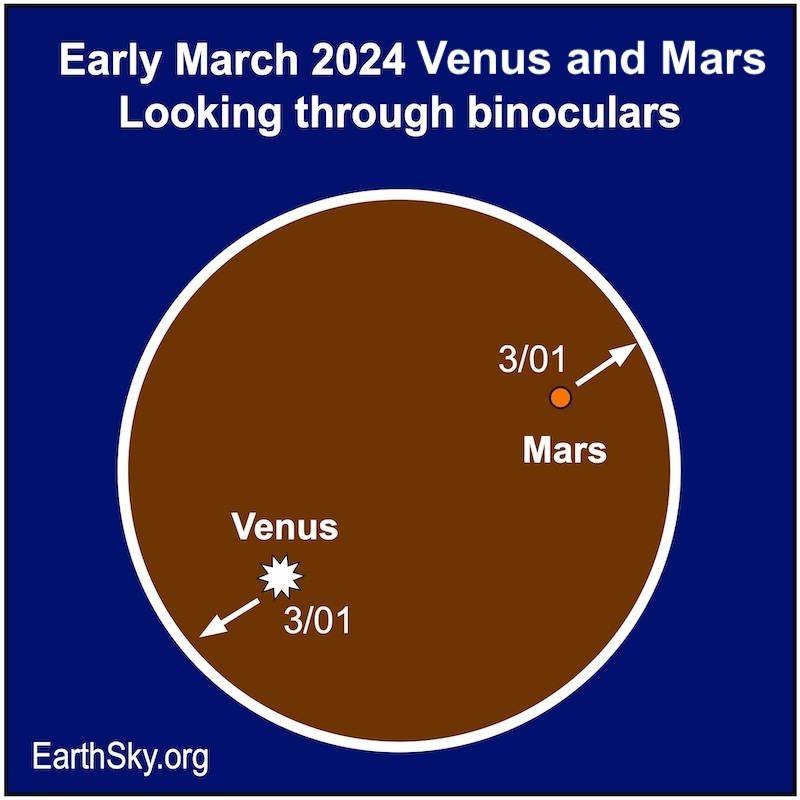
Mid-March mornings: Mars
Mars will become easier to identify in the morning twilight, rising about an hour before sunrise. Although you probably won’t see them in the morning twilight, Mars will lie in front of the constellation of Capricornus the Sea-goat and will move into Aquarius the Water Bearer near the end of the month. Mars remains a morning object through all of 2024.
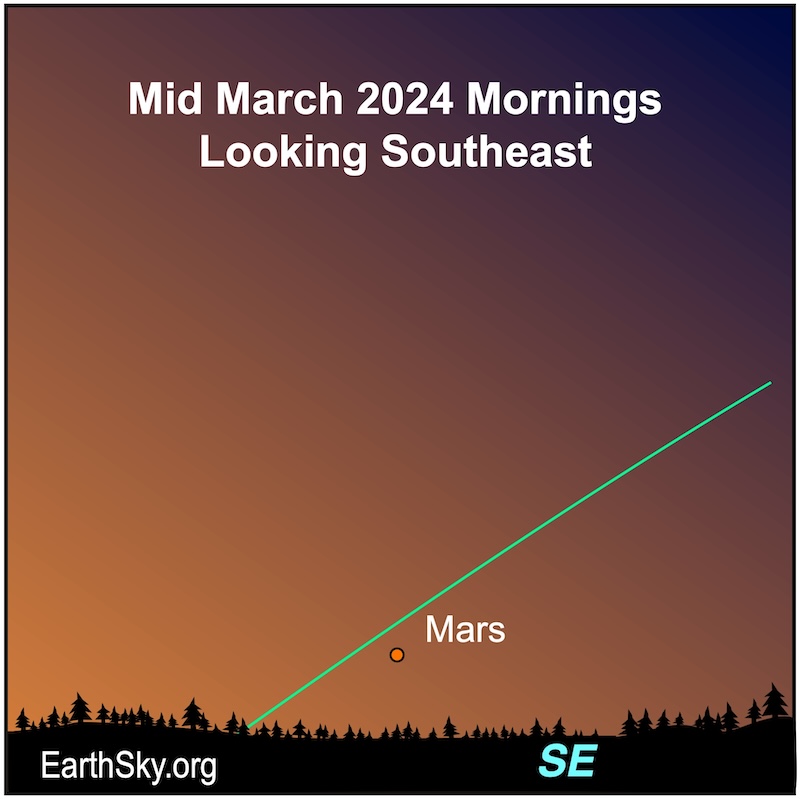
March evenings: Jupiter
Bright Jupiter is easy to spot in the March 2024 evening sky. However, it is losing altitude and brightness as it descends closer to the sun. It will set about five hours after the sun at the beginning of the month, and about three hours after sunset by month’s end. It will shine near the pretty Pleiades star cluster in the constellation Taurus the Bull. Jupiter reached opposition overnight on November 2-3, 2023, when we flew between it and the sun. So, as Jupiter recedes from Earth, it’ll fade a bit in our sky. It will reach opposition again on December 7, 2024, so it’ll be at its brightest for the year around then. It will lie in the dim constellation Aries the Ram, and it’ll shine at -2.1 magnitude by month’s end. The waxing crescent moon will float by Jupiter on March 13, 2024.
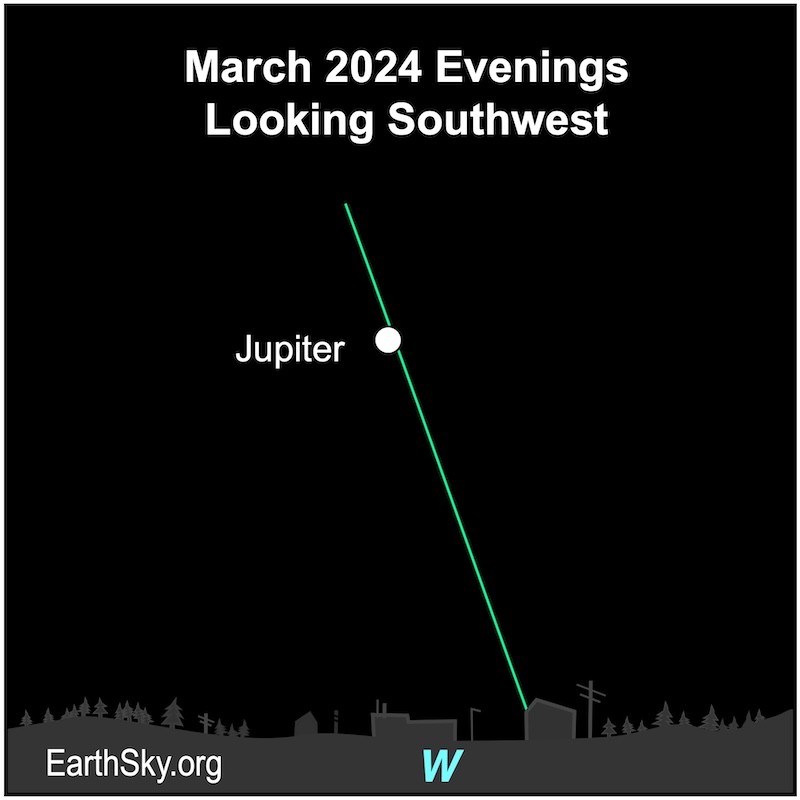
March evenings: Mercury
The bright but elusive planet Mercury emerges during the second week of the month and quickly rises to prominence after sunset. This will be Mercury’s best evening apparition for the Northern Hemisphere in 2024. It’ll reach its greatest distance from the sun on the evening of March 24. And then, it’ll fade quickly and be gone by the end of the month. Bright Jupiter will be higher in the sky.
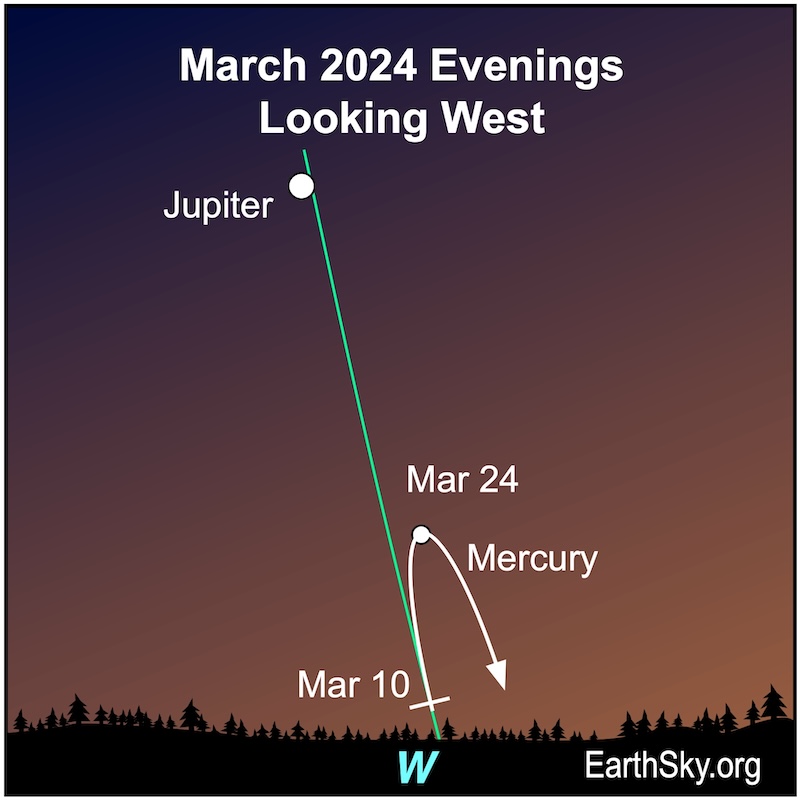
Where’s Saturn?
You probably won’t see Saturn this month.
Thank you to all who submit images to EarthSky Community Photos! View community photos here. We love you all. Submit your photo here.
Looking for a dark sky? Check out EarthSky’s Best Places to Stargaze.
Sky dome maps for visible planets and night sky
The sky dome maps come from master astronomy chart-maker Guy Ottewell. You’ll find charts like these for every month of 2024 in his Astronomical Calendar.
Guy Ottewell explains sky dome maps

Morning of March 4: Moon near Antares
On the morning of March 4, 2024, the waning crescent moon – barely past last quarter – appears lower in the sky than Antares, the Scorpion’s Heart. The moon rises in the wee hours of the morning and sets about noon.
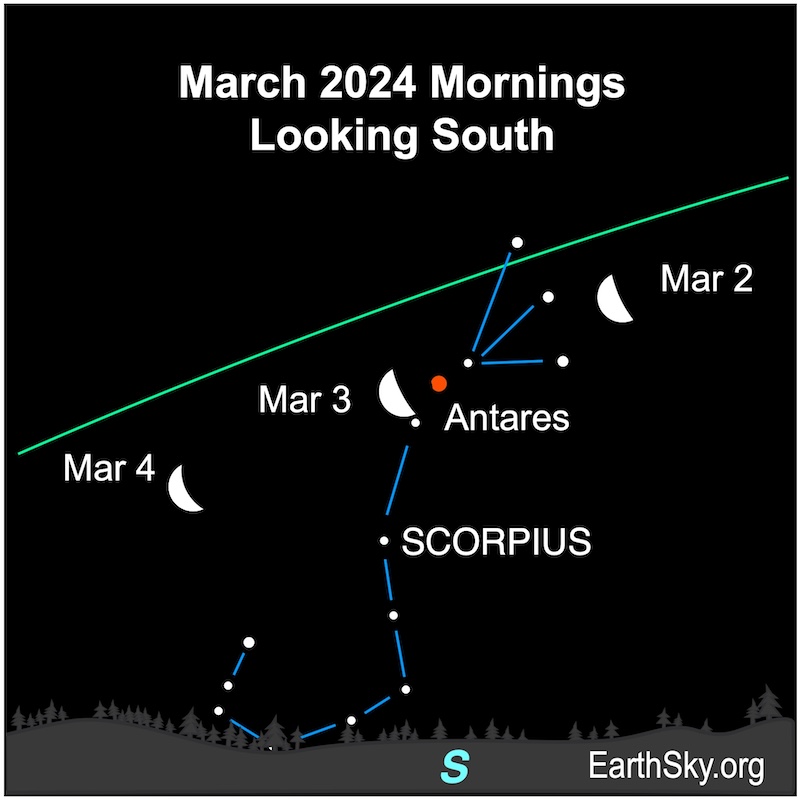
Our charts are mostly set for the northern half of Earth. To see a precise view – and time – from your location, try Stellarium Online.
March evenings: Watch for the zodiacal light
The zodiacal light – a hazy pyramid of light, really sunlight reflecting off dusk grains that move in the plane of our solar system – is now visible after evening twilight for Northern Hemisphere observers with dark skies. Southern Hemisphere observers? Look for it before morning twilight begins. Read about the zodiacal light.
Moon phases for the month
Join EarthSky’s Marcy Curran for a 1-minute video preview of the moon phases – and dates when the moon visits some planets – for the month of March 2024.
35 days from eclipse day: Good sun? Or bad sun?
Today we’re 35 days out from the April 8 total solar eclipse! For much of human history, total solar eclipses were seen as bad omens. But some traditional cultures see solar eclipses in an entirely different light. Join Cristina Ortiz as she explores “good” suns – and “bad” suns – in stories from around the world.
Visit the Countdown to Eclipse video series
Read about the April 8 total solar eclipse.
March evenings: Look for Auriga the Charioteer
The bright star Capella is almost overhead this month. It’s the brightest light in the constellation Auriga the Charioteer. To be sure you’ve found Capella, look for a little triangle of stars nearby. Capella is sometimes called the Goat Star, and the little triangle of stars is an asterism called The Kids. After finding Capella, you can trace out the rest of this pentagon-shaped group of stars. Read more about Capella and Auriga.
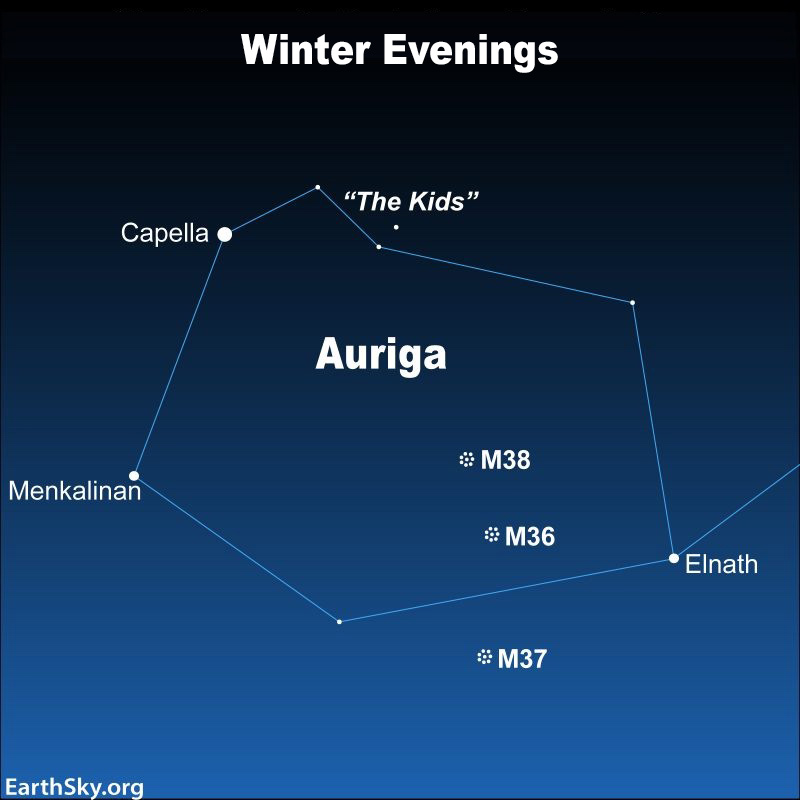
March 7 and 8 mornings: Moon near Venus and Mars
In the morning twilight of March 7 and 8, 2024, the slender waning crescent moon will float near bright Venus and a much dimmer Mars. On March 7, the lit portion of the moon will point toward the two planets. On the morning of March 8, the trio forms a triangle low on the horizon. Binoculars might help locate them about 30 to 40 minutes before sunrise.
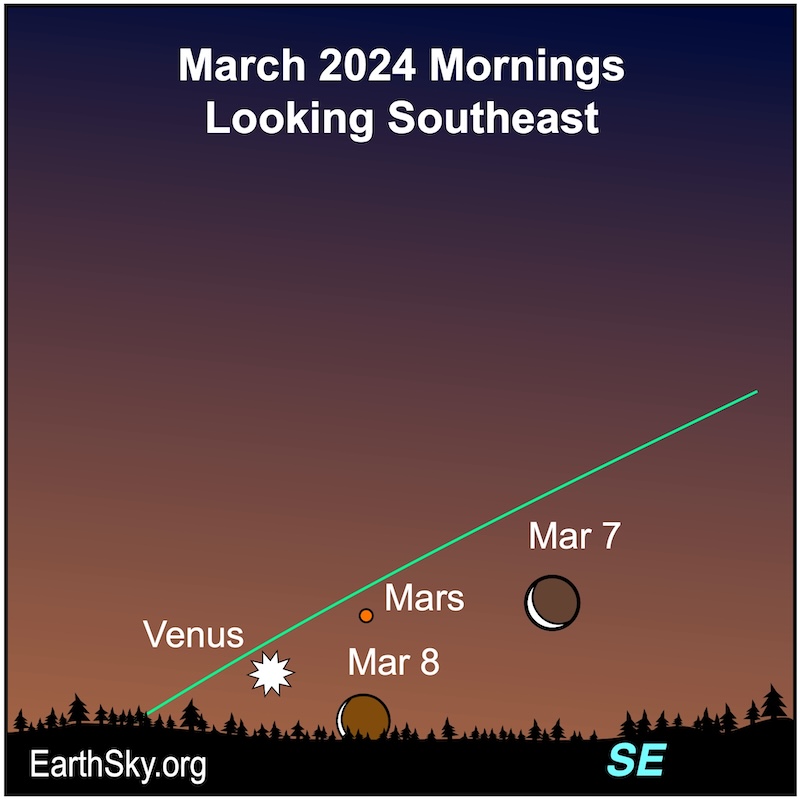
Daylight saving time begins March 10
For those observing daylight saving time, set your clocks forward 1 hour.
March 10: New moon
The instant of new moon will fall at 9 UTC (4 a.m. CDT) on March 10, 2024. It’s a perfect time for stargazing under dark skies. The new moon rises and sets with the sun. This is the 3rd new supermoon of 2024 and the 3rd of five new supermoons in a row. It’s 221,767 miles (356,900 km) away from Earth.
March 10: Moon reaches perigee
The moon will reach perigee – its closest point in its elliptical orbit around Earth – at 7 UTC (1 a.m. CDT) on March 10, 2024, when it’s 221,763 miles (356,893 km) away. High tides are possible.
Our charts are mostly set for the northern half of Earth. To see a precise view – and time – from your location, try Stellarium Online.
March evenings: Look for Gemini the Twins
On March evenings, the constellation Gemini the Twins is high overhead on the sky’s dome. Look for the bright – and obvious – “twin” stars, Castor and Pollux. These two stars aren’t really twins. Pollux is brighter and more golden. Castor is slightly fainter and white. But both stars are bright, and they’re noticeable for being close together on the sky’s dome. You may need dark skies to locate the rest of the constellation. In March, the constellation is highest around 9 p.m. That’s your local time, no matter where you are on the globe. You can use binoculars to see a nice open star cluster listed on the chart below, M35.
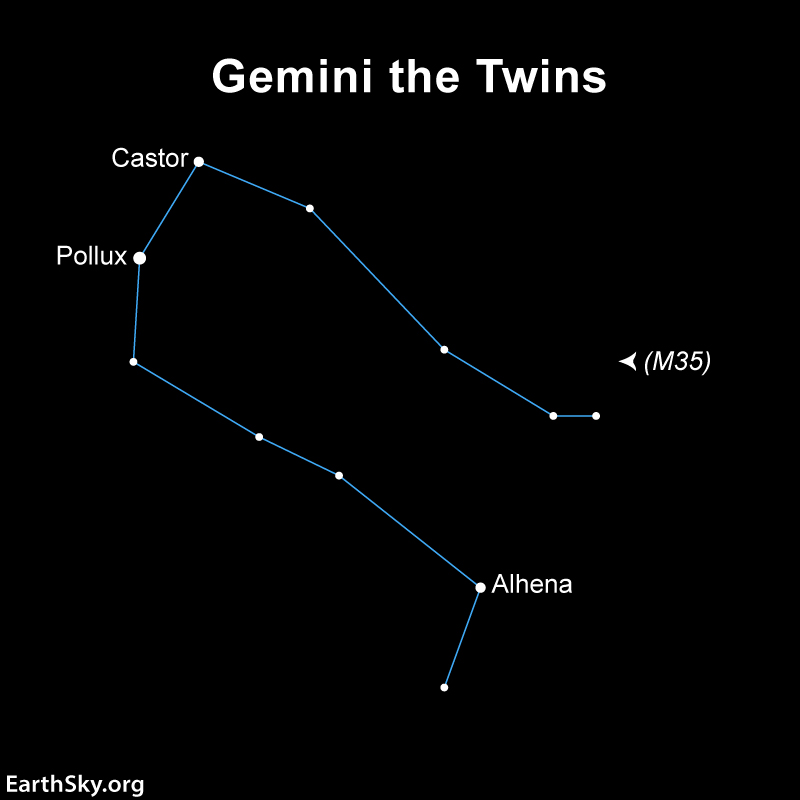
March 11 and 12 evenings: Thin crescent moon
The thin waxing crescent moon will hang in the western twilight on the evenings of March 11 and 12, 2024. Do you notice a lovely glow on the unlit side of the moon? That’s earthshine! It’s reflected light from the Earth.
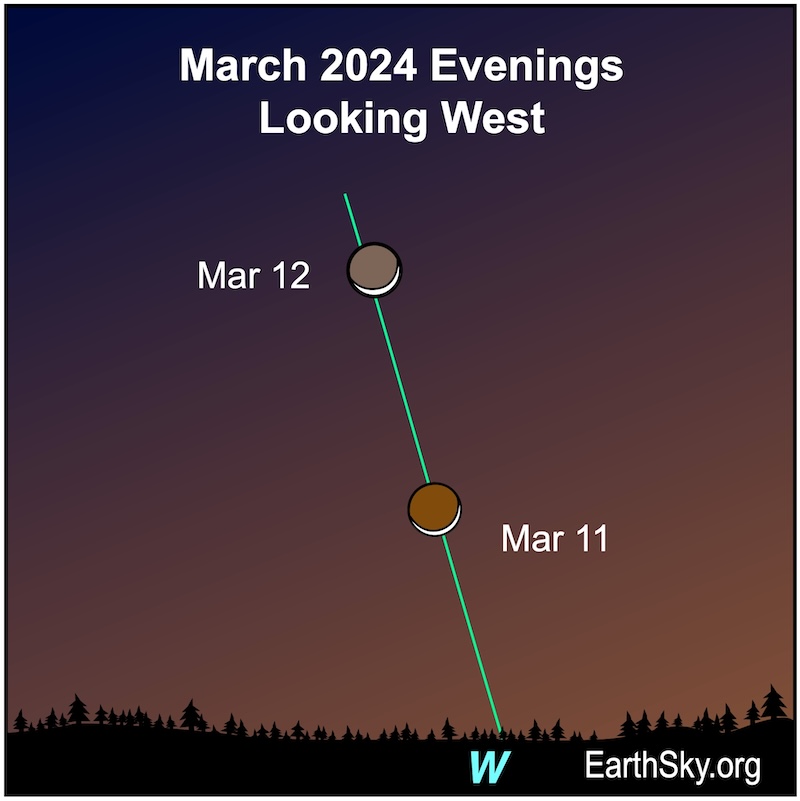
March 13 and 14 evenings: Moon near Jupiter and the Pleiades
On the evenings of March 13 and 14, 2024, the waxing crescent moon will glow near the bright planet Jupiter. The moon and Jupiter will set around midnight. You will also see the tiny dipper-shaped Pleiades star cluster, or Seven Sisters, nearby. The moon will lie especially close to the Pleiades on March 14. They’ll set around midnight.
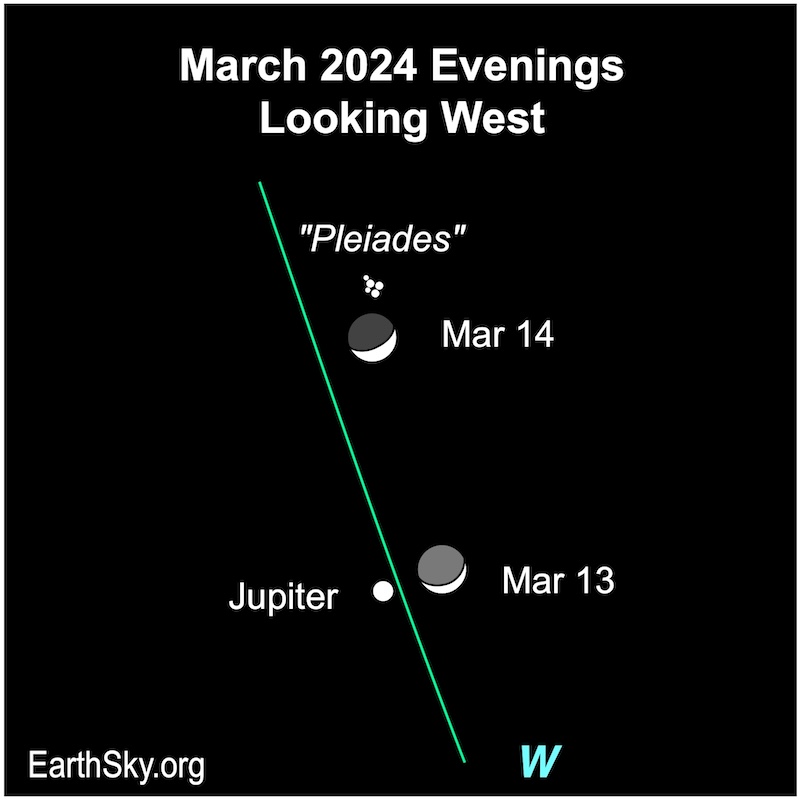
Our charts are mostly set for the northern half of Earth. To see a precise view – and time – from your location, try Stellarium Online.
March 15 and 16 evenings: Moon near Aldebaran and Pleiades
The thick waxing crescent moon will lie near the Pleiades star cluster on the evenings of March 15 and 16, 2024. The Pleiades is also known as the Seven Sisters, or Messier 45. It appears as a glittering, bluish cluster of stars in the constellation Taurus the Bull. Meanwhile, what is that fiery orange star nearby? It’s Aldebaran, Eye of the Bull in Taurus. The moon, Pleiades and Aldebaran will cross the sky together and set after midnight.
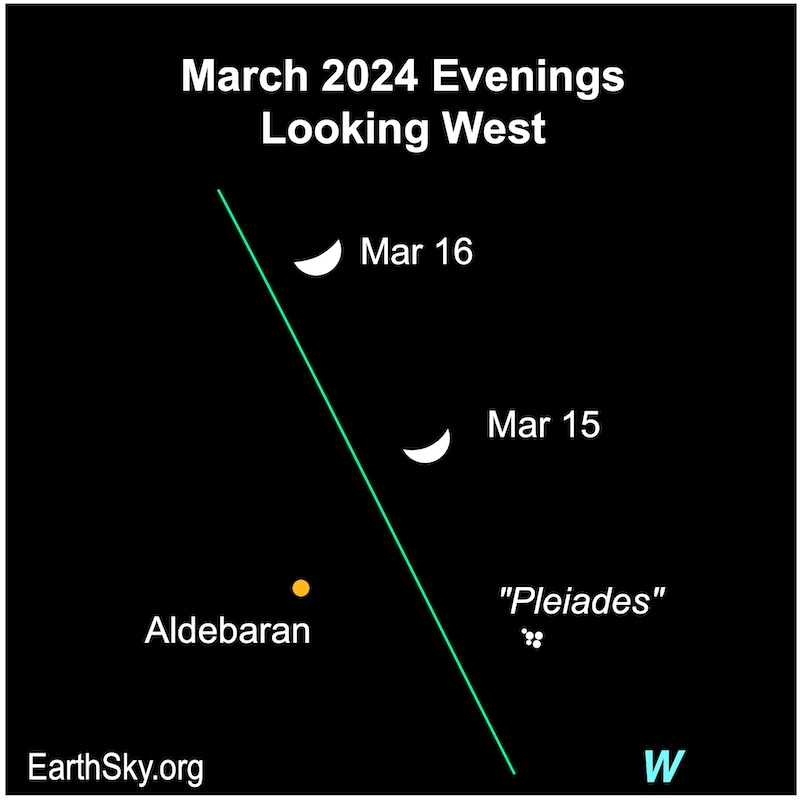
March 17: 1st quarter moon
The instant of 1st quarter moon will fall at 4:11 UTC on March 17, 2024 (10:11 p.m. CDT on March 16). A 1st quarter moon rises around noon your local time and sets around midnight. Watch for it high in the sky at sundown.
Our charts are mostly set for the northern half of Earth. To see a precise view – and time – from your location, try Stellarium Online.
March 17 and 18 evenings: Moon near Pollux and Castor
On the evenings of March 17 and 18, 2024, the bright waxing gibbous moon will pass Pollux and Castor, the “twin” stars of Gemini. They’re named for twin brothers born from different fathers. So, they don’t really look alike. Pollux is a bit brighter and golden in color. And Castor appears white. They’ll rise before sunset and travel across the sky’s dome until a little before sunrise.
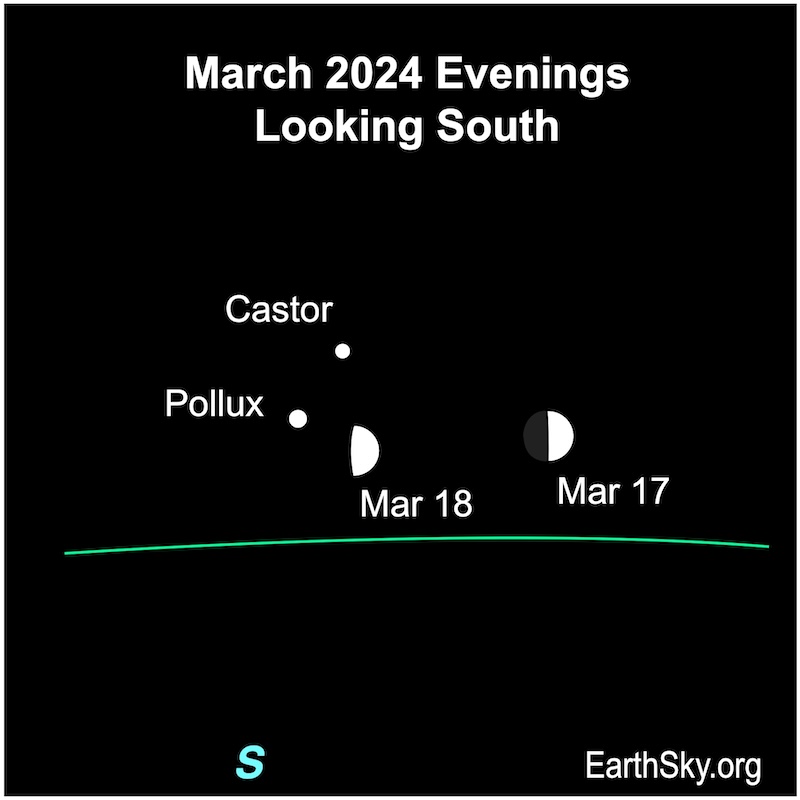
March 20: March Equinox
The March equinox marks the sun’s crossing above the Earth’s equator, moving from south to north. It’ll happen at 3:06 UTC on March 20, 2024 (9:06 p.m. CDT on March 19). It marks the beginning of spring in the Northern Hemisphere and autumn in the Southern Hemisphere.
Our charts are mostly set for the northern half of Earth. To see a precise view – and time – from your location, try Stellarium Online.
March 20 and 21 evenings: Moon near Regulus
On the evenings of March 22 and 23, 2024, the fat waxing gibbous moon will float near the bright star Regulus, the brightest star in Leo the Lion. They’ll be visible through dawn.
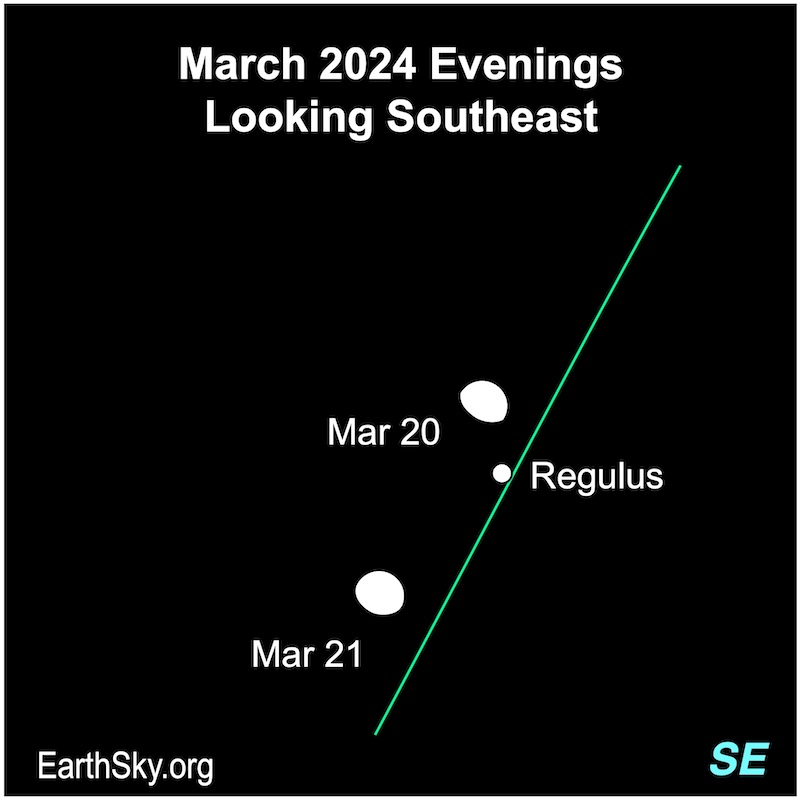
Moon at apogee March 23
The moon will reach apogee – its farthest distance from Earth in its elliptical orbit around Earth – at 16 UTC (10 a.m. CDT) on March 23, 2024, when it’s 252,459 miles (406,293 km) away.
March 24 and 25: Full Worm Moon and penumbral lunar eclipse
The instant of full moon – the Worm Moon – will fall at 7 UTC (1 a.m. CDT) on March 25, 2024. It’ll be the second smallest – most distant – full moon in 2024 at 251,900 miles (405,394 km) away. Also, if the moon is above the horizon, you can see a penumbral lunar eclipse. People in parts of Antarctica, the western half of Africa, western Europe, the Atlantic Ocean, the Americas, the Pacific Ocean, Japan and the eastern half of Australia will see a deep penumbral lunar eclipse. The penumbral eclipse begins at 4:53 UTC on March 25, 2024 (10:53 p.m. CDT on March 24).
March 24 evening: Mercury at greatest evening elongation
Mercury is farthest from the sun on our sky’s dome – at greatest elongation – at 23 UTC on March 24, 2024 (5 p.m. CDT). At that time, Mercury is 19 degrees from the sun in our sky. This will be its best evening apparition of 2024 for the Northern Hemisphere.
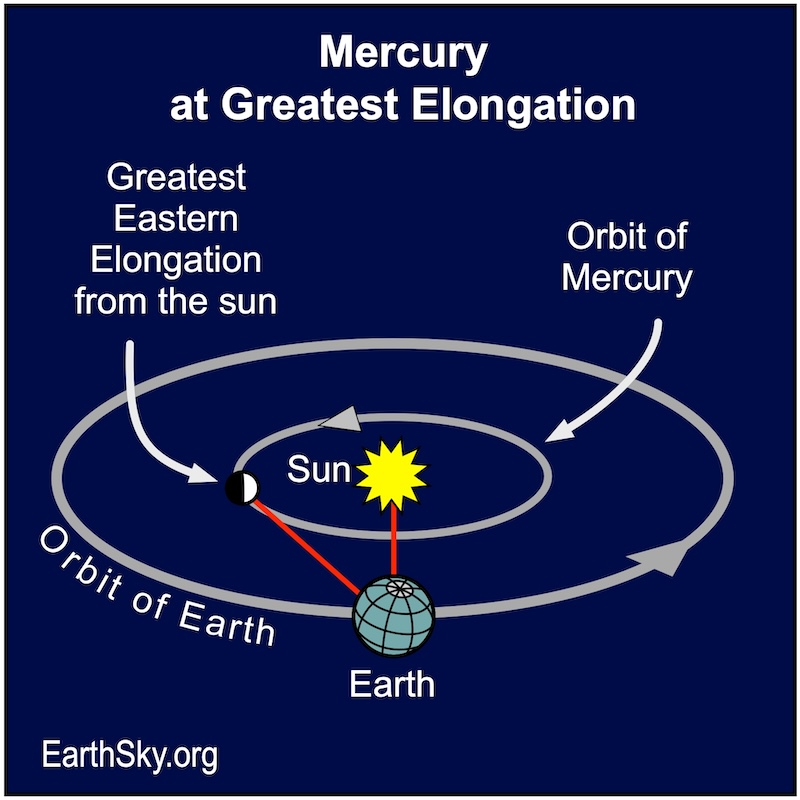
Our charts are mostly set for the northern half of Earth. To see a precise view – and time – from your location, try Stellarium Online.
March 25 and 26 evenings: Moon near Spica
On the evenings of March 25 and 26, 2024, the waning gibbous moon will hang near the bright star Spica in Virgo the Maiden. They’ll rise soon after sunset and be visible until sunrise.
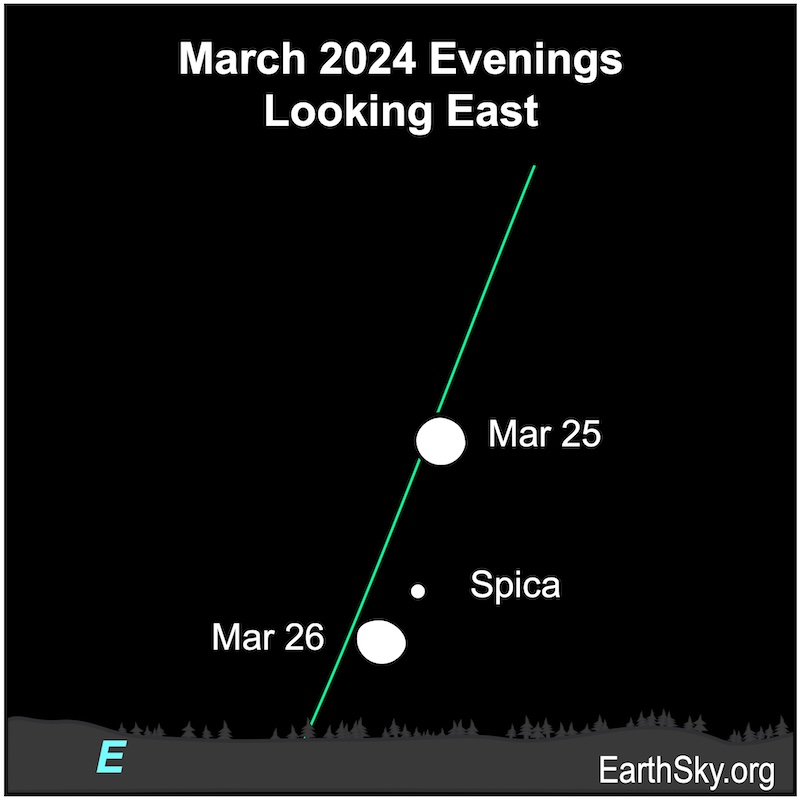
March 27 to April 10: Zodiacal light
The zodiacal light may be visible after evening twilight for Northern Hemisphere observers for the next two weeks. Southern Hemisphere observers? Look for it before morning twilight begins.
March evenings: Look for the Winter Triangle
The Winter Triangle isn’t a constellation. It’s an asterism, made of three bright stars in the Northern Hemisphere’s winter sky (or the Southern Hemisphere’s summer sky). Procyon, Sirius and Betelgeuse are easy to find on winter and spring evenings. It’s also part of a larger asterism, the Winter Circle. And locating bright stars can help you find constellations. Sirius is in Canis Major, Procyon is in Canis Minor and Betelgeuse is in Orion the Hunter.
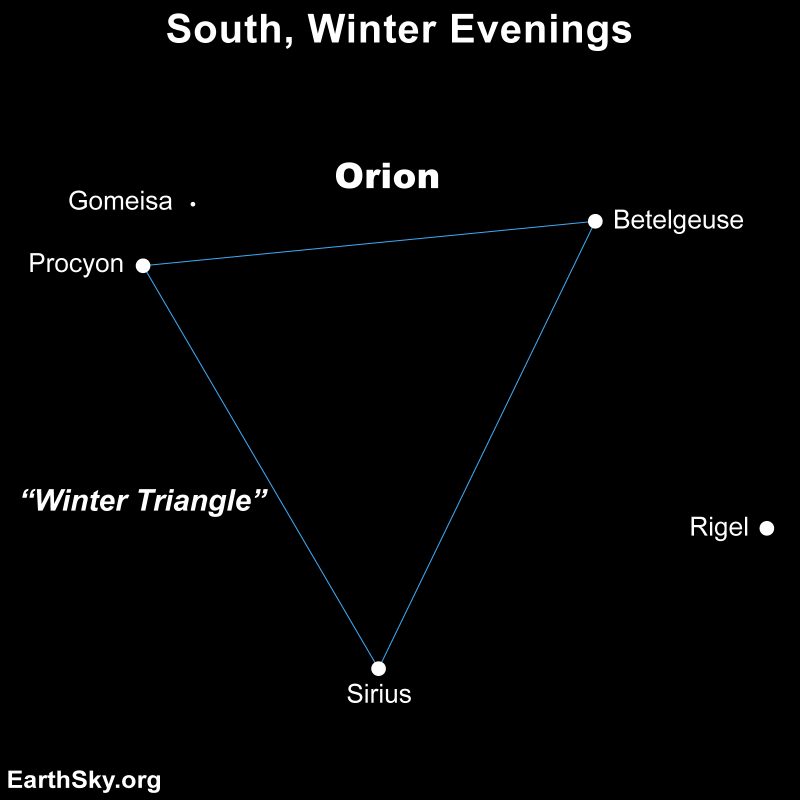
Our charts are mostly set for the northern half of Earth. To see a precise view – and time – from your location, try Stellarium Online.
March 30 and 31 mornings: Moon near Antares
On the mornings of March 30 and 31, 2024, the waning gibbous moon will lie close to the bright star Antares in Scorpius the Scorpion. In fact, at 15 UTC on March 30, 2024, skywatchers in parts of northeast Melanesia, Micronesia and most of Polynesia will see the moon pass in front of – or occult – Antares.
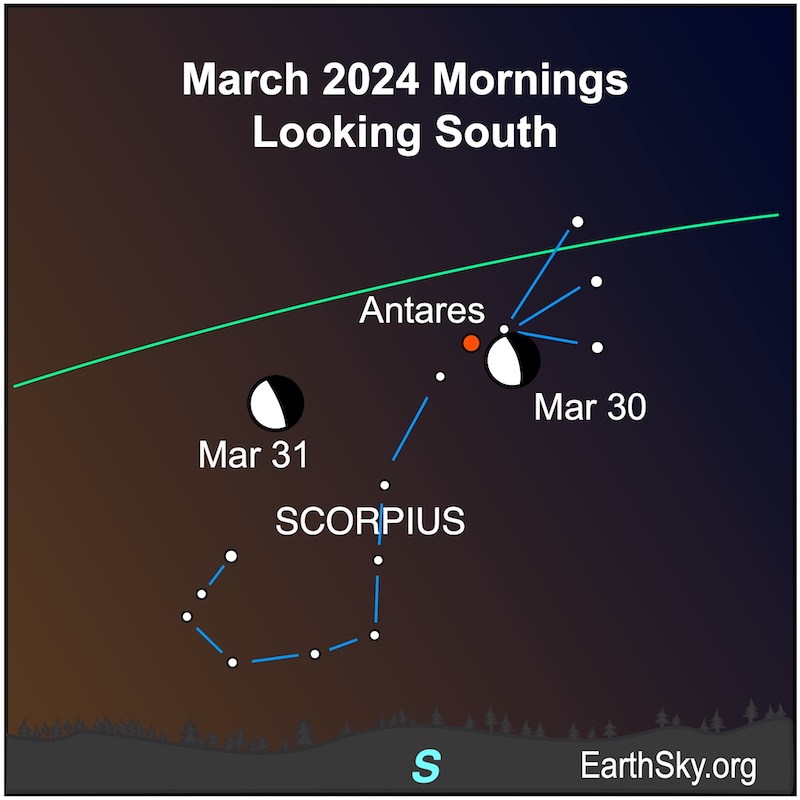
Visible planets in March 2024
Early March mornings: Venus and Mars
The brightest planet is Venus, and at the beginning of March it will be low in the morning twilight descending more each day. At the same time, Mars climbs slowly higher each day but will remain challenging to spot in the morning twilight. It’ll be fun to watch them grow apart. Venus will disappear before mid-month. When is the last day you catch Venus in the sky? Once Venus slips away, it won’t be visible again until it pops up in the evening sky in August. Also, a thin waning crescent moon will visit Venus and Mars on the mornings of March 7 and 8, 2024. The pair will be easiest to spot in binoculars.
Here’s a binocular view of Venus and Mars as they move away from each other at the beginning of March.

Mid-March mornings: Mars
Mars will become easier to identify in the morning twilight, rising about an hour before sunrise. Although you probably won’t see them in the morning twilight, Mars will lie in front of the constellation of Capricornus the Sea-goat and will move into Aquarius the Water Bearer near the end of the month. Mars remains a morning object through all of 2024.

March evenings: Jupiter
Bright Jupiter is easy to spot in the March 2024 evening sky. However, it is losing altitude and brightness as it descends closer to the sun. It will set about five hours after the sun at the beginning of the month, and about three hours after sunset by month’s end. It will shine near the pretty Pleiades star cluster in the constellation Taurus the Bull. Jupiter reached opposition overnight on November 2-3, 2023, when we flew between it and the sun. So, as Jupiter recedes from Earth, it’ll fade a bit in our sky. It will reach opposition again on December 7, 2024, so it’ll be at its brightest for the year around then. It will lie in the dim constellation Aries the Ram, and it’ll shine at -2.1 magnitude by month’s end. The waxing crescent moon will float by Jupiter on March 13, 2024.

March evenings: Mercury
The bright but elusive planet Mercury emerges during the second week of the month and quickly rises to prominence after sunset. This will be Mercury’s best evening apparition for the Northern Hemisphere in 2024. It’ll reach its greatest distance from the sun on the evening of March 24. And then, it’ll fade quickly and be gone by the end of the month. Bright Jupiter will be higher in the sky.

Where’s Saturn?
You probably won’t see Saturn this month.
Thank you to all who submit images to EarthSky Community Photos! View community photos here. We love you all. Submit your photo here.
Looking for a dark sky? Check out EarthSky’s Best Places to Stargaze.
Sky dome maps for visible planets and night sky
The sky dome maps come from master astronomy chart-maker Guy Ottewell. You’ll find charts like these for every month of 2024 in his Astronomical Calendar.
Guy Ottewell explains sky dome maps

Premiere Showing: Harbor Seal Pups Spotted On Shore
In California, March marks the beginning of pupping season for Harbor Seals (Phoca vitulina). Females gather on shore in rookeries and give birth to a single 30-pound pup, which can swim shortly after birth.
Mothers may leave their pups alone on the rocks for briefly while they hunt for fish, squid and other seafood. Each year, well-intentioned, but misinformed people pick up or otherwise interfere with an “orphaned” seal. In turn, the pup (that waits patiently while its mother forages for their food before she returns) gets separated, then unknowingly absconded by an oblivious person.
Look for Harbor Seal rookeries in Bolinas Lagoon (Marin Co.) and Fitzgerald Marine Reserve (San Mateo Co.). Don’t approach too closely to the seals (especially if you are walking a dog) as you may disrupt their nursing or resting schedules.
Native Bees Prowling for Pollen (And Nectar)
Quick: what do you picture when you hear the word “Bee”? You probably think of Apis mellifera, the European Honeybee. But California has more than 1,500 species of its own native bees. Their sizes and colors are as varied as the plants on which they feed.
Native bees have evolved to hatch or come out of hibernation when their preferred food source is available. In spring, metallic green or blue bees in the genus Osmia and black bees of the genus Adrena appear in time to exploit early blooming flowers such as the California Poppy. Native bumblebees (genus Bombus) also make their debut early in the season — and you see them now as the largest bumblebees hovering close to the ground.
As the seasons change, so do the bee species and their preferred pollen and nectar plants. Wish to help native bees thrive? One way is to plant a variety of their favored flowering plants in your garden.
Professor Gordon Frankie and his students at the University of California –Berkeley have created a wonderful website filled with information about urban bee gardens: nature.berkeley.edu/urbanbeegardens/index.html
Seasonal Vernal Pools Shelter Vulnerable Species
Weeks and weeks of rain. Then months and months of dry, sunny weather. That’s California’s Mediterranean climate.
More exact, during the rainy season (typically November through March), where rain collects in grassland depressions (where impermeable layers of hardpan, claypan, or volcanic basalt occur) vernal pools form (i.e., temporary ponds). They may dry up and refill several times each rainy season.
Turns out the borders of these vernal pools host impressive colorful expressions of diverse wildflowers. In so doing, you’ll see rainbow-like concentric circles of vernal pool endemic wildflowers grow on the outer edges of pools. In turn, as water slowly evaporates as spring progresses, other flower species bloom as spring proceeds in relation to slowly-waning soil moisture.
Vernal pool wildflowers have descriptive names — Meadow Foam. Wooly Marbles, Button Celery, Butter and Eggs, to name just five. Joining them, invertebrates in impressive numbers occur in vernal pools. They provide food for birds, lizards, and other animals. These fragile habitats provide home to vulnerable, threatened, and endangered animals including the California Tiger Salamander, the Western Spadefoot Toad, and several species of fairy shrimp.
Habitat loss is one of the biggest threats to native species, and vernal pools are themselves threatened by development. Today, only 13% of California’s vernal pools remain. Most of the best-preserved pools are privately owned by conservation organizations or land trusts.
In Northern California, both Jepson Prairie Preserve in Solano County and Mather Field in Sacramento County offer guided tours of their vernal pools in spring. For more information, visit http://www.vernalpools.org
Baby Time
Which animals give birth this month? A large variety. Watch for baby Western Tree Squirrels, Opossum, and Raccoons. We don’t usually get lucky enough to see newborn mammals because the mother or both parents typically hide their young from any potential predators. But you can sometimes see Western Tree Squirrel mothers transferring their babies from one tree “nest” to another or spot a family of Raccoons at night in your backyard (perhaps easiest accomplished while using an infrared light bulb to cast a glow that Raccoons ignore, but is bright enough for your own viewing pleasure).
For another notable exception, see the entry above about Harbor Seals.
Western Tree Squirrel: Newborns All Around
Even urban areas with sparse tree growth may host Western Tree Squirrel populations. Now’s an ideal time to see males competing for the attention of females. Two to five young are born this month where females have retreated to tree cavities. By June, the newborns are active (though not yet full grown, so you can tell them apart from adults).
They’re Back: Returning Migrants
During most breeding seasons, you can expect this month to feature a variety of migrating birds returning to coastal northern California in good numbers, including the House Wren, Warbling Vireo, Wilson’s Warbler, Pacific-Slope Flycatcher and Cliff Swallow.
Rare Bird Alert Hotline
Do you wish to see rare, accidental or early bird migrants in northern California? Call the “Bird Box” to find out at 415/681-7422. You may also record your own bird sighting reports at the same phone number.
Fluttering By: Butterflies and Moths
Now’s the time to watch for the appearance of various butterflies and moths. One of the most appealing is the Silkmoth (Saturnia mendocino), which wears a striking black-rimmed eyespot on each wing. Look for them most commonly in coastal and mountain chaparral.
Mountain Lookout: Birds Up High
Going to the California mountains this time of year? Be on the lookout for several species of birds: Williamson’s Sapsucker (a woodpecker that feeds on the sap of lodgepole pine during the summer but eats more insects in the winter), Black-backed Woodpecker, Mountain Chickadee (that eats larvae of the lodgepole needleminer during the winter), Pine Grosbeak (less common in winter up high), Red-breasted Nuthatch, and Red Crossbill (also less common). The latter two species are year-round residents in Marin County, but they are never common to see, and are often detected initially by a birder’s ear tuned to the landscape.
Bon Voyage: Winter Resident Migration
Some winter resident birds in the Bay Area and northern California begin to leave now for breeding areas elsewhere, including species such as American Pipit and Cedar Waxwing.
Wake Up Call: Awakening From Hibernation
Which true hibernating mammals are getting closer to “waking up” from their long winter’s sleep? In foothill and mountainous areas of northern California, yellowbelly marmot, least chipmunk, California ground squirrel, and western jumping mice all hibernate. Some of these species may spend seven to eight months in a torpid state, though not all ground squirrel populations hibernate and many individuals in our area remain above ground or are active by January.
The Numbers Are In: Returning Bird Migrants
Migrating birds whose return to northern California typically occurs in higher numbers now (and into the first two weeks of April) include MacGillivray’s Warbler, Black-headed Grosbeak, Yellow Warbler, Olive-sided Flycatcher, Lazuli Bunting, and Swainson’s Thrush. Excellent guides to birding in our area include “Birder’s Guide to Northern California” (Lolo and Jim Westrich, Gulf Publishing Co., 1991) and “Birding Northern Calfornia,” John Kemper, A Falcon Guide, Globe Pequot Press, 2001). You may also wish to find guided birding walks that are pre-scheduled on local Audubon chapter web sites that are accessed through http://www.audubon.org
(Click on the home page’s button titled “states and chapters” to access any local California Audubon chapter among the dozens listed.)
April, 2023
Sky Watch*:
This Week’s Sky at a Glance, April 14 – 23, 2023
Venus shines with Aldebaran and the Pleiades in late twilight. After sunset on the 20th, try to spot your record-breaking thinnest young Moon. And Leo walks west with a mouse-galaxy dangling from his chin.
(* = Enchanting views of my night sky in Novato, CA location are enhanced thanks to optic devices from Out of This World Optics, a Mendocino, CA binocular and spotting scope storefront and mail order company you may enjoying visiting at OutofThisWorldOptics.com)
Planets To See In April: (Courtesy of skyandtelescope.com)
Mercury is fading fast in the western twilight: from a modest magnitude +0.6 on Friday April 14th to an invisible (in the low twilight) +2.3 a week later. Early this week, use binoculars to help hunt for Mercury about two fists at arm’s length to the lower right of Venus.
Venus (magnitude –4.1, in Taurus) is the brilliant “Evening Star” in the west during and after dusk. It doesn’t set until two hours after full darkness. In a telescope Venus is a dazzling little gibbous globe (72% sunlit) 15 or 16 arcseconds in diameter. It’s gradually enlarging and waning in phase. It’ll be 50% lit by late May and a dramatic crescent from mid-June through mid-July.
Mars is crossing Gemini. Look for it high in the west in early evening, lower in the west later. It’s upper left of Venus by three or four fists at arm’s length, and below Pollux and Castor.
Mars has faded to magnitude +1.2, the same brightness as modest Pollux above it. But Mars shows a deeper orange tint.
Mars is nearly on the far side of its orbit from us, so in a telescope it’s just a tiny blob 5½ arcseconds wide.
Moon & Planet Rise & Set Times*
* = Courtesy of timeanddate.com/astronomy/night/
Note: To see your area’s rise and set planet times, visit https://www.almanac.com/astronomy/planets-rise-and-set. Then, type in your city, state and zip code to see the results like mine below for 4/15/23 (at Latitude: 38:03:38 N, Longitude: 122:32:27 W, which is Novato, CA, 20 miles north of San Francisco, CA in Marin County):
| Planetrise/Planetset, Fri, Apr 15, 2023 |
|---|
| Body | Rises | Crosses Meridian |
Illum. | Sets |
|---|---|---|---|---|
| Mercury | 7:13 A.M. NE |
2:18 P.M. 70° |
28% | 9:23 P.M. NW |
| Venus | 8:27 A.M. NE |
3:48 P.M. 74° |
72% | 11:09 P.M. NW |
| Mars | 10:55 A.M. NE |
6:23 P.M. 76° |
91% | 1:53 A.M. NW |
| Jupiter | 6:34 A.M. E |
1:01 P.M. 59° |
100% | 7:28 P.M. W |
| Saturn | 4:36 A.M. E |
10:02 A.M. 40° |
100% | 3:28 P.M. W |
| Uranus | 7:39 A.M. E |
2:36 P.M. 68° |
100% | 9:32 P.M. W |
| Neptune | 5:30 A.M. E |
11:24 A.M. 49° |
100% | 5:18 P.M. W |
| Pluto | 3:02 A.M. SE |
7:48 A.M. 29° |
100% | 12:35 P.M. SW |
| Planet | Rise | Set | Meridian | Comment |
|---|---|---|---|---|
| Mercury | Thu 7:01 am | Thu 8:05 pm | Thu 1:32 pm | Difficult to see |
| Venus | Fri 4:52 am | Fri 3:54 pm | Fri 10:23 am | Good visibility |
| Mars | Fri 4:37 am | Fri 3:10 pm | Fri 9:54 am | Average visibility |
| Jupiter | Fri 5:48 am | Fri 5:29 pm | Fri 11:38 am | Slightly difficult to see |
| Saturn | Fri 4:29 am | Fri 2:58 pm | Fri 9:44 am | Average visibility |
| Uranus | Thu 7:57 am | Thu 9:41 pm | Thu 2:49 pm | Extremely difficult to see |
| Neptune | Fri 5:50 am | Fri 5:32 pm | Fri 11:41 am | Extremely difficult to see |
April 22-23, 2023: The Lyrids Meteor Shower
The Lyrid meteor shower – April’s shooting stars – lasts from about April 16 to 25. Lyrid meteors tend to be bright and often leave trails. About 10-20 meteors per hour can be expected at their peak. Plus, the Lyrids are known for uncommon surges that can sometimes bring the rate up to 100 per hour. Those rare outbursts are not easy to predict, but they’re one of the reasons the tantalizing Lyrids are worth checking out around their peak morning. The radiant for this shower is near the bright star Vega in the constellation Lyra (chart here), which rises in the northeast at about 10 p.m. on April evenings. In 2023, the peak morning is April 22, but you might also see meteors before and after that date.
See the following web link for more information:
https://www.timeanddate.com/astronomy/meteor-shower/lyrids.html
Bay Area Bunny (and Hare) Trails
How do you tell a brush rabbit from a Califonia hare (also called California jackrabbit)? Easy. Our common Bay Area rabbit has a powderpuff-like white bunny tail. The hare is much larger and has large, long ears.
You tend to see brush rabbits in dense undergrowth.
Their brown pelage and small size provide camouflage as they rest
under brush and scrub during the day. At dawn and dusk they emerge to
feed on green plants. When threatened, brush rabbits thump their hind
legs against the ground to produce a warning sound. If pursued by a
predator, a rabbit will race away in a zig-zag pattern.
Unlike a brush rabbit, hares can jump up to 20 feet in a single bound, and it can run up to 35 mph when eluding a predator. Baby hares, called
leverets, are born with their eyes open and are ready to run shortly
after birth. In the Bay Area, look for brush rabbits at Sunol Regional Wilderness or in many other spots. Hares are commonly spotted along the Albany waterfront and at Mission Peak, among many other Bay Area locations.
The Sniffling Season
Green hills, golden poppies, and sneezing neighbors are three sure
signs that Spring has arrived in Northern California. While blooming
flowers are obvious visual harbingers that violate our noses, your allergies may be the result of other, more hidden enemies. Before poppies bloom, trees such as alder, ash, oak and juniper initially produce pollen.
On a windy day you can see clouds of golden dust billowing
from these mature trees. Just as trees wind down, a potpourri of grasses and flowers cast their sniffle-inducing spell. Fortunately, for seasonal allergy sufferers, April showers bring temporary relief from suffering, as rain washes pollen out of the air.
Lizards Arising: Western Whiptails
Throughout the state this month, watch for the emergence of reptiles, including Western Whiptails that become active after winter dormancy. At first sighting, don’t mistake the whiptail for a snake, despite their long, 13-inch body that slithers more like a miniature alligator.
As the only common whiptail in the state, you won’t find them easily along the Coast and instead need to explore inland, arid habitats. Here, the juveniles are the initial populations to become active, followed by adult males. The latter compete for females by establishing mating dominance among males that congregate together. Unlike many reptiles that become more difficult to spot as temperatures rise throughout the spring, whiptails remain active throughout much of the day.
Does a whiptail drop its tail as an escape strategy from a predator? Yes, but only in rare cases, and only if it cannot evade the grasp of its pursuer. Growing its tail again takes lots of energy and time, so a whiptail will typically instead bolt from a predator in the blink of an eye to prevent capture.
Butterfly Sightings?
If you’ve recently seen a butterfly species and wish to know if other people have witnessed the same kind or others, then visit a Web site link that is devoted to tracking the appearance of butterfly species throughout North America: http://www.naba.org/sightings/sightings.html
Mountain Beavers: A Family Of One
Have you ever seen a Mountain Beaver? Not many people have been lucky enough to observe these solitary rodents that are in a different family than the more common American Beaver that lives throughout North America. To find a Mountain Beaver, you have to search in moist habitats along the Pacific coast from northern California through Washington and into southern British Columbia, Canada. Little is known about mountain beaver behavior during the breeding season. Breeding activity occurs mainly from January to March with gestation lasting about 30 days. Young are born blind and hairless, weighing about 3/4 ounce (20 g). They develop incisors at about 30 days and are weaned at about 8 weeks. Young animals are often active in May. Females apparently do not bear young until they are two years of age.
As the only member of its family (Aplodontidae) and genus (Aplodontia) in North America, a Mountain Beaver leaves evidence of its presence in the form of packed ground that forms a trail next to its burrow within a forest canopy and/or thick understory. Mountain Beavers are active year-round, but a rare sight, perhaps primarily because their habitat is usually inaccessible and off-trail from where most hikers prefer to explore.
Skinks Underfoot
Look under a flat board or log now for the Western Skink, a common, yet secretive reptile that lives throughout northern California from sea level to 7,000 feet. Males wear a distinctive blue belly and join females in a variety of habitats, most commonly in open areas or places undergoing early regrowth of vegetation after logging. Mating occurs in spring soon after emerging from winter slumber.
Big Time: CA Giant Salamanders
CA Giant Salamander individuals are entering their peak breeding time in northern California. At lengths ranging from six inches to, rarely, 10-12 inches, this salamander is the largest in our area. They are year-round residents of north-central California (from southern Santa Cruz County to extreme southern Mendocino and Lake counties) that live up to 6,500 feet, primarily in humid coastal forests, and especially in Douglas-fir, redwood, red fir, and montane and valley-foothill riparian habitats. Look for aquatic adults and larvae in cool, rocky streams and occasionally in lakes and ponds.
Where do I go in Marin County, CA where I live to see this majestic, air-craft carrier-sized salamander? Bear Valley Creek in Pt. Reyes National Seashore is a fine spot to peruse for California Giant Salamander presence. Cascade Canyon in Fairfax is another place for seeing California Giant Salamander.
Roadside Mammal Sightings
Roadside mammal sightings now may seem more common for a good reason: Mothers are giving birth to babies, including those born to opossums. As the only pouched mammal (marsupial) in the USA, opossums often give birth to 14 embryos that have large hands to quickly crawl and attach to their mother’s 13 teats. Of course, in a tongue-and-cheek kind of way, this means the oversupply of babies for available teats makes opossums players of “musical chairs,” a game they have been playing for millions of years prior to the first appearance of evolved primates such as humans.
Everywhere and Omnipresent: Western Fence Lizards
Probably the most common reptile in California, the Western Fence Lizard is now more easily seen. This abundant, plainly-marked species begins courtship as early as March (and more commonly April), with copulations also occurring in May and June. Egg-laying after copulation typically occurs in two to four weeks (May through mid-July is the peak of egg-laying), and the incubation period is around 60 days. Found throughout California except in deserts (where it is confined to riparian areas), Western Fence Lizards live from sea level to 10,000 feet. Of course, like any common animal, populations of Western Fence Lizard may be locally rare if suitable habitat is removed as a consequence of development.
Aerial Acrobats: Swifts in Northern California
Although you can now see two species of swifts (Vaux’s and White-throated) that nest in northern California (including Marin County), the White-throated is more common until it begins to disperse and migrate by the end of July and early August, after which they become a more rare sight throughout autumn and into winter. According to studies, all species of swifts obtain their food exclusively while aloft. Copulation also occurs in the air. Such aerial feats make sense, as seeing a swift perched is an uncommon sight, given their underdeveloped feet and leg muscles that are weak in comparison to those designed for perching birds such as songbirds.
Wakeup Call: Emerging Marmots
Detecting obvious signs of global warming’s presence is indicated by changing hibernation dynamics in some mammal species. Consider that yellowbelly marmots (close relatives of woodchucks), which usually hibernate for eight months during the long winter at high altitudes, are emerging from hibernation earlier (38 days earlier over the past 23 years) and may risk starvation as they wait longer for snow to melt before they can feed.
May, 2023
Sky Watch:
1. Moon and planet watching:
Type in your location to learn moon and planet rise & set times at:
https://www.timeanddate.com/astronomy/night/
2. Sky events:
Meteor Shower – May 4–5
While you’re observing the planets, look for shooting stars. The Eta Aquarids peak in the predawn hour of May 5. The comet responsible for the Eta Aquarids shower is Halley’s Comet! In the Northern Hemisphere, we expect 10 meteors per hour.
The best time to view is just before dawn on the mornings of May 4, 5 and 6 when Moon shine is not an issue. See more viewing tips for meteor showers.
Total Lunar Eclipse – May 15
A total lunar eclipse of May’s full Moon appears on Sunday night, May 15, with the entire eclipse visible from the eastern half of the U.S. and Canada and all of South America! West of the Mississippi, the Moon will rise already eclipsed, offering intriguing photography opportunities. Many folks in the media call this a “Blood Moon.”
The partial eclipse begins at 10:27 PM EDT on May 15, followed by totality beginning at 11:28 PM EDT. I’ll be writing more about this gorgeous total eclipse soon.
When to See the Planets This Month:
- Before dawn in the east on the 1st, Venus and Jupiter are still wonderfully close together.
- From the 3rd to the 20th, look for an easy planet lineup featuring, from left to right, Venus, Jupiter, Mars, and Saturn.
- The crescent Moon serves as an easy guide to all of the planets beginning on the 22nd, when it’s just below Saturn.
- The Moon will dangle below Jupiter and Mars on the 25th and below Venus on the 27th.
- From the 27th to the 30th, Jupiter will be very close to Mars.
Venus and Mercury are the two nighttime “stars” and meet for a conjunction, too!
Venus is a dazzlingly gorgeous evening star in the northwest on the 1st, but each night she steadily sinks lower into the dusk until she is gone by month’s end.
Mercury
Mercury, standing 12 degrees high in fading twilight 40 minutes after sunset in the second half of the month, offers a fine evening apparition
Venus and Mercury Conjunction
Look for Venus and Mercury to form a fine, close conjunction on May 21, only 10 degrees high in fading twilight, a very worthy target. First, locate Venus. As the evening darkens, spot Mercur next to Venus.
These inferior planets create a striking dinnertime triangle with the thin crescent Moon on the 23rd.
After their conjunction, Mercury will climb upward day by day while Venus will descend downward. As long as you can catch Venus after sunset, seek for Mercury above Venus.
MORNING PLANETS
The three morning planets this month are Jupiter, Saturn and Mars – which are easy to spot from the waning Moon from May 12 to 14, 2020.
On May 12, at about 4.00 a.m., look for the Moon in the sky, then find both Jupiter and Saturn just above the Moon. Jupiter is by far the brightest of the two. Nearby is the ringed planet Saturn.
Watch the Moon move towards Mars on the 13th, ending below and slightly to the right of steadily brightening Mars on the 14th.
May 6: The Eta Aquarids
This meteor shower has a relatively broad maximum – meaning you can watch it for several days around the predicted peak. However, in 2015, the bright waning gibbous moon is sure to diminish the numbers. The radiant is near the star Eta in the constellation Aquarius the Water Bearer (click here for chart). The radiant comes over the eastern horizon at about 4 a.m. local time; that is the time at all locations across the globe. For that reason, the hour or two before dawn tends to offer the most Eta Aquarid meteors, no matter where you are on Earth. At northerly latitudes – like those in the northern U.S. and Canada, or northern Europe, for example – the meteor numbers are typically lower for this shower. In the southern half of the U.S., 10 to 20 meteors per hour might be visible in a dark sky. Farther south – for example, at latitudes in the Southern Hemisphere – the meteor numbers may increase dramatically, with perhaps two to three times more Eta Aquarid meteors streaking the southern skies. For the most part, the Eta Aquarids is a predawn shower. In 2015, the bright wani
Communal Housing: Heron and Egret Nest Choices
Why do Great Blue Heron, Snowy Egret, and Great Egret nest so close to their neighbors? Predator evasion may be one reason: many eyes are more likely to spot marauding hawks, crows, and other threats. Another possibility is that herons and egrets prefer to next close to their food source and nearby sturdy, tall trees may be in short supply. After birds find a choice piece of real estate, they remain loyal owners, as some colonies have been in use for more than 70 years!
Large nesting colonies (called rookeries) are sure to be host newborns this month. Some late arriving pairs of egrets and herons may still be courting.Their elaborate displays include flashing long, plume-like feathers that once were harvested for women’s hats — a practice that is now banned. Other egrets in the same rookerie tree may be incubating eggs. By the end of the month, some will be caring for newly-hatched chicks. In Bolinas (Marin County), Audubon Canyon Ranch is a great place to see dozens of Great and Snowy Egrets nest together, with the occasional Great Blue Heron also sometimes present.
Newborn & Nearby Elk Calves
From most spots in the Bay Area, did you know that you’re only an hour or two from seeing Tule Elk newborns? A visit to Point Reyes National Seashore is a great place to seem them. Within the park, take Pierce Point Road (instead of remaining on Sir Francis Drake Road that goes to the lighthouse) to its end. At the parking lot, follow the main trail where dozens of Tule Elk are soon often present.
When you see the spotted, spindly-legged newborn calves this time of the year, they weigh only 20-25 pounds at birth. Growing quickly, they run within a few weeks of birth, but still nurse for four months. In the fall, adult males weighing up to 700 pounds shed their antlers. Females are about three-quarters that size.
The Point Reyes population is introduced after unting and habitat loss once pushed California’s native elk to the brink of extinction. The Point Reyes populations and a few others throughout the state remain stable, thanks to land management and the establishment of wildlife preserves.
Return of the Terns
How many species of terns nest in the Bay Area? Two. Forster’s nest in the South Bay. Least, North America’s smallest tern, nests on Alameda Island in the Bay Area and in a few other Bay Area locations.
Annually, they migrate from California to Southern Mexico and back. By late April, adults arrive at their nesting sites. They prefer open, vegetation-free areas, above the tide line where their eggs will remain dry. But predators, such as raccoons and foxes, find some of the eggs. Habitat loss of prime nesting beach sites is another problem that has resulted in large population drops statewide. In fact, only 25-30 nesting sites remain in California.
The Least Terns you see now may have traveled as far as 2,000 miles. Males and females bond during a 2-3 week courtship. In California, the first eggs appear around May 15 and are incubated for 19-25 days. Chicks leave the nest when they are only two days old, but they aren’t fully independent for several months. By mid-July, the Bay Area’s Least Terns begin to depart for Mexico.
Migrating Swainson’s Thrushes
Northern California’s greatest abundance of Swainson’s Thrush arrive this month on their breeding grounds, joining April’s initial vanguard that returns from non-breeding areas in Mexico, Central America, and, even, perhaps, from as far south as mid-South America. Northern California’s populations have been studied less rigorously than eastern populations that complete a 3,000 mile from Panama to Canada. In an amazing effort spanning 34 years of tracking migrating thrushes in spring, W.W. Cochran’s discoveries inspired Martin Wikelski, a biologist at Princeton University in 1999, to measure how much energy thrushes expended in migratory flight.
Wikelski’s results were counter-intuitive to what common sense would suggest: the thrushes traveling north in spring spent less energy in flight than they did while resting and foraging during daytime layover episodes. In total, Wikelski and his collaborators found a typical thrush completed its long migration journey over 42 nights while averaging 4.6 hours per night flight of approximately 158 miles. Losing 0.3 calories per mile on average, each thrush’s heart beat about 840 times per minute while flying — a hyper-aerobic workout that failed to be as caloric intensive as the seemingly more loitering, casual effort required when merely perched or foraging.
Watching Radar To Follow Migrating Birds
Anyone with an Internet connection to the World Wide Web can use radar images to see whether migrant birds are aloft and how large their flocks are in abundance while heading your way. Visit the fascinating and well-respected Clemson University Radar Ornithology Laboratory Web site at http://virtual.clemson.edu/groups/birdrad. These radar images are forecasts for East Coast viewers wishing to track spring migrants, but, nonetheless, it’s probably also fascinating for West Coast Web surfers to interpret how an evening’s weather pattern influences the movement of migrating birds.
An equally interesting source of migration information available through radar maps is operated by the College of DuPage in Illinois. The ideal time to look at its radar maps is two to four hours after sunset at http://weather.cod.edu/analysis/analysis.radar.html. At this time, you’ll be able to interpret the magnitude of migration and the direction and speed traveled by birds en masse by the different concentrations of colors appearing on each radar map.
Born Free: Northern Alligator Lizards
Northern Alligator Lizards are commonly seen now in a variety of forested habitats and montane chaparral from northwestern California, in the Coast Ranges south to San Luis Obispo Co. and in the Sierra Nevada Mountains south to the Kern River in southern California. Although mating probably occurs as early as mid-April, live alligator lizard young (in litters of 3-8) are typically born in August and September. As long as temperatures remain above freezing into November, these reptiles will roam free and usually disperse no more than five to seven miles from an original birthing area.
Rare Find: California Red-Legged Frogs
The federally threatened California Red-legged Frog breeds from March to July in northern parts of California and from January to July (peak in February) in the southern part of the state. It inhabits quiet pools of streams, marshes, and occasionally ponds where emergent vegetation provides hiding places. Look for this species west of the Sierra-Cascade crest and along the Coast Ranges the entire length of the state usually below 4,000 feet.
Wash First: Newborn Raccoons
Newborn raccoons born this time of year may number 2-7 in a litter. Do they and their parents truly wash their food? Sometimes, but dipping their meal is merely thought to be a tactic that helps them tell edible objects from non-edible items. There is no evidence from field observations to suggest raccoons attempt to clean off their prey by washing them with water before feasting. An excellent tactic to see raccoons closeup is to attract them to your backyard with a bowl of dogfood or graham crackers while shining the glare of an infrared bulb from above on the food attractant. Then, retreating to your residence and watching from a distance of at least 50 feet, wait patiently to see if raccoons arrive to take your bait.
Water Magnets: Attracting Birds To Your Yard
What’s one technique that may attract more birds to your yard? Try installing a backyard in-ground pond or above-ground water source. A perpetual spray or fountain that recycles water can attract birds drawn in by the sound of running water, especially passerines such as American Robin, Chestnut-backed Chickadee, Oak Titmouse, House Finch, American Goldfinch and many others.
Better Late Than Never: Western Wood-Pewees Arrive
Western Wood-Pewees, one of our latest returning neotropical migrants, are now settling into breeding habitats such as woodlands, pine-oak forests, and river groves.
Got Skunks?
What is the strange scent in the air along roadsides? Perhaps you’re smelling night-active skunks whose home range may extend beyond 10 acres, within which a portion is used more often, including sheltering areas such as abandoned burrows of other animals. Skunks sometimes also dig their own burrow or use protected cavities underneath buildings. Some naturalists suggest mothballs work to repel skunks from habitually entering a shelter under, for example, a house or patio.
Care Package: Feeding Thirsty Hummingbirds Correctly
Changing sweet mixtures regularly every 2-3 days in hummingbird feeders becomes important as days grow warmer. Washing the feeder in hot water is also an important preventive measure to care for the health of hummers. A four to five parts water to one part sugar combination usually works best, though you may experiment (fun!) to judge which mixture is most often visited by hummingbirds. Bee and ant guards are a good idea to prevent potential problems. If you’re hanging more than one feeder, the best strategy (if possible) is to space them apart by at least 30-40 feet. This action may help prevent the guarding of two feeders by an overaggressive male hummer that defends the territory in between both feeders.
June, 2023
1. Moon and planet watching in June, 2023:
Type in your location to learn moon and planet rise & set times at:
https://www.timeanddate.com/astronomy/night/
2) June Night Sky (courtesy of almanac.com)
Bird Quiz
Pop bird quiz: How many species of warblers nest in northern California along and near the coast (e.g., Marin County)? During most breeding seasons, at least eight species breed annually in suitable habitat (Orange-Crowned, Yellow, Yellow-Rumped, Black-throated-gray, Hermit, MacGillivray’s, Common Yellowthroat, and Wilson’s). Irregular to rare annual breeders in n. CA may include Northern Parula, American Redstart (annual in far n.w. CA along the coast) and Yellow-breasted Chat. All eight in the initial list, above, may be seen during the non-breeding season, with the Common Yellowthroat and Yellow-rumped considered resident in Marin County.
Note, however, that some Yellow-Rumped populations may arrive from the north during the non-breeding season to displace Marin County’s higher altitude breeding populations of the same species. These individuals likely migrate south and don’t remain during the non-breeding season.
In our area, Orange-crowned is uncommon, yet not rare to see during the non-breeding season, while Hermit is often also seen, especially during the County’s annual Christmas Bird Count surveys conducted by volunteers. The least common species to see during the non-breeding season (December through March) from the list above (in descending order of abundance) are Yellow, Black-throated gray, Wilson’s, and MacGillivray’s). Nashville Warbler is sometimes seen as a transient migrant through the Bay Area, including occasional sightings during the West Marin Christmas Bird Count (West Marin CBC).
Final Avian Arrivals
In northern California, it’s a good bet that Western Wood Peewee and Common Nighthawk are the latest arriving avian migrants among species that do not overwinter in the state. According to the Point Reyes Bird Observatory Biologist Dave Shuford’s chart (Marin County Breeding Bird Atlas, Dave Shuford, Bushtit Books, Bolinas, CA 1993) that highlights the arrival of avian migrants in northern California (see http://www.warblerwatch.com and click on the “Bird Arrival Times” button), Western Wood Peewee may arrive in May and as late as early June during some years. Common Nighthawk is usually a June arrival, probably because their primary food resource — aerial insects of various species — do not bloom in abundance until this time.
What’s That Sound? Could It Be A Chipmunk?
Unlike the Sierra mountains where many species of chipmunks may be seen, the Sonoma Chipmunks is the only species of chipmunk you’ll see in coastal areas of northern California, including the San Francisco Bay area. Breeding from February through July, one litter is born per year consisting of three to seven young. Gestation occurs for 30 days in a pregnant chipmunk and individuals mature at around one year. Not surprisingly, people often mistake the soft chirping of the Sonoma chipmunk for a bird.
Blinded By The Light
On warm nights now and the rest of the summer, it’s wonderful to linger outdoors and gaze at the stars. There’s only one problem. It’s increasingly more difficult to see the stars through the glare discarded by people and their surroundings. Do you care about the increasing problem of light pollution that makes it more difficult to clearly spot celestial objects? If so, you might consider joining the International Dark-Sky Association. Call 520/293-3198 for more information or look at its Web site: http://www.darksky.org
Spotting Spotted Deer?
Will you still see young deer this late in the spring? Yes, it seems the normal range of births for deer extends into late June and beyond. I’ve seen white-spotted fawns well into July and, even, occasionally as late as August and September in our area, the burgeoning population due in part to the plentiful forage and ideal habitat that continues to expand as more suburban landscapes and their associated gardens displace forests, forest borders, and meadows.
Gray Fox: Dog Family Member All Around Us
On trails near urban areas throughout the Bay Area, you can often find the scat or tracks of gray foxes. (Many people may automatically assume these signs are from domestic dogs. Telltale signs of gray fox include the presence of hair and a sharp, tapered point at least one end of the scat.) More common than ever in our region, these solitary mammals may be active both day and night. Unlike other dog family members, the gray fox is able to climb trees where they may hang out during the day.
Coastal Nester: Western Gull
Which gull in California is the only species nesting along the coast (e.g., Marin County)? The Western Gull, which nests from southern Baja to Washington. Distinguishing this species from other gull species is not too difficult. Three field marks often give away their identity: pink legs, large bill, extremely dark gray backside/mantle. Note the lower portion of the bill has a small crook or angle near its end, a field mark that is called the “gonydeal angle.”
Attracting Mammals
Do you want to attract mammals into view in your backyard? One fun technique for doing so is to place a Q-tip (that has been dipped into musk oil or other animal-attracting oil potion) into the ground. Place a small circle of sand under the Q-tip so that you can see the tracks of the animals you attract. (You can order a large variety of animal attractant oil and vocal call devices from M & M Fur Co., 1-800-658-5554.)
July, 2023
1) Night Sky For July, 2022
Night sky guide for July 2022 (courtesy of earthsky.org)
Planetary lineup: How long can you see it?
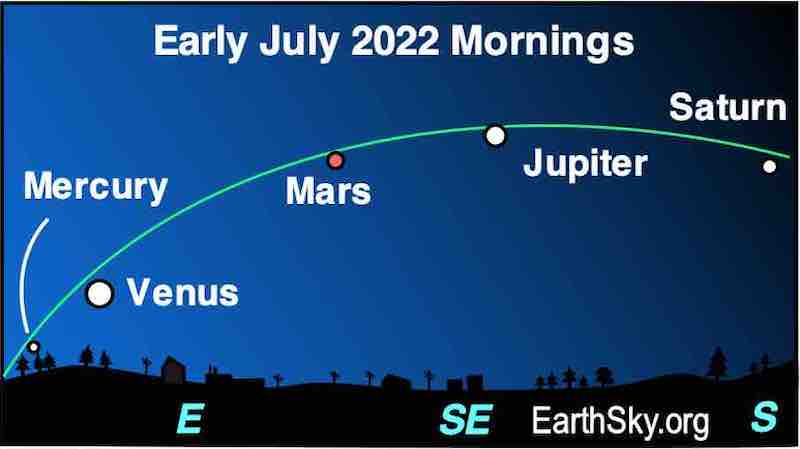
July 1-3 evenings: Moon near Regulus
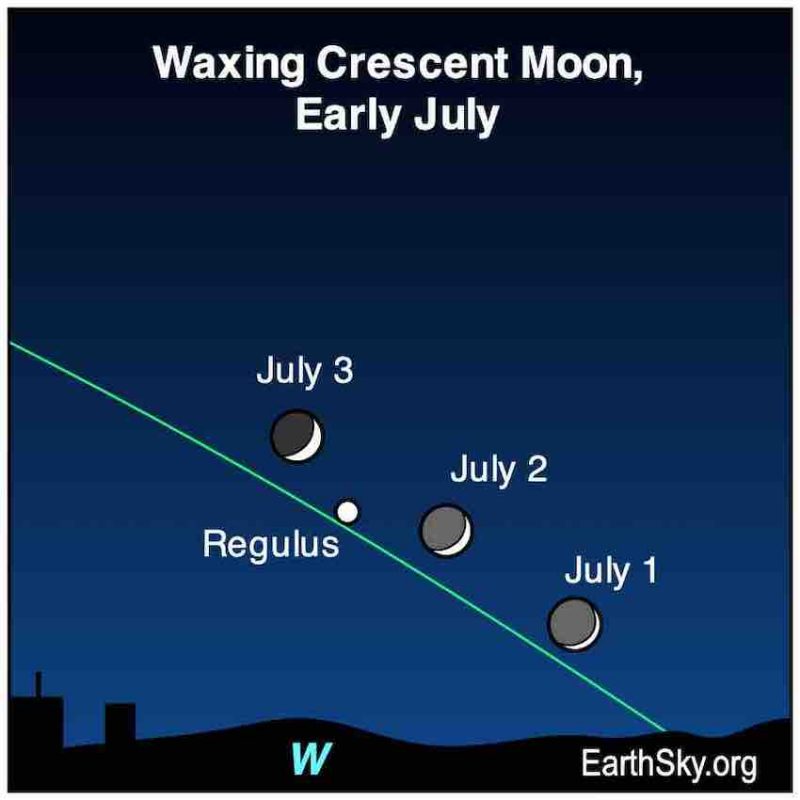
July 4: Earth at aphelion
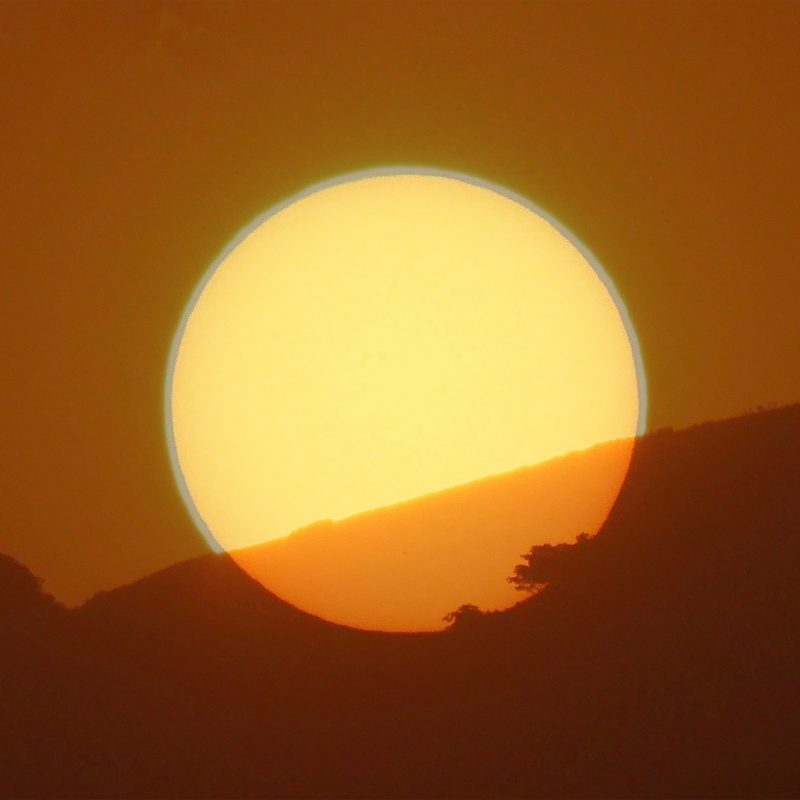
July mornings: Jupiter lies in Cetus
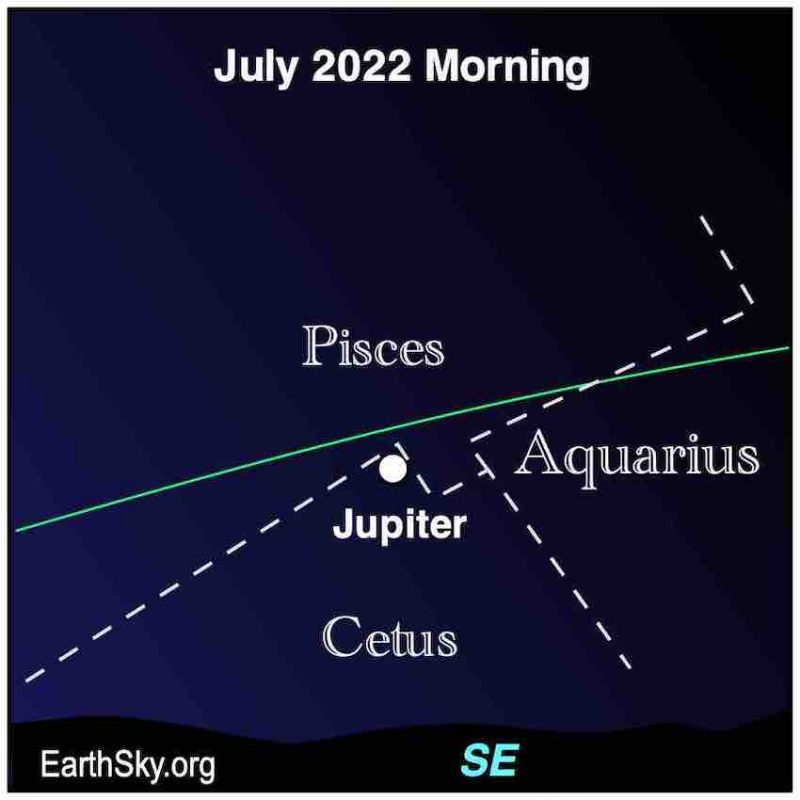
July 7 evening: Moon near Spica
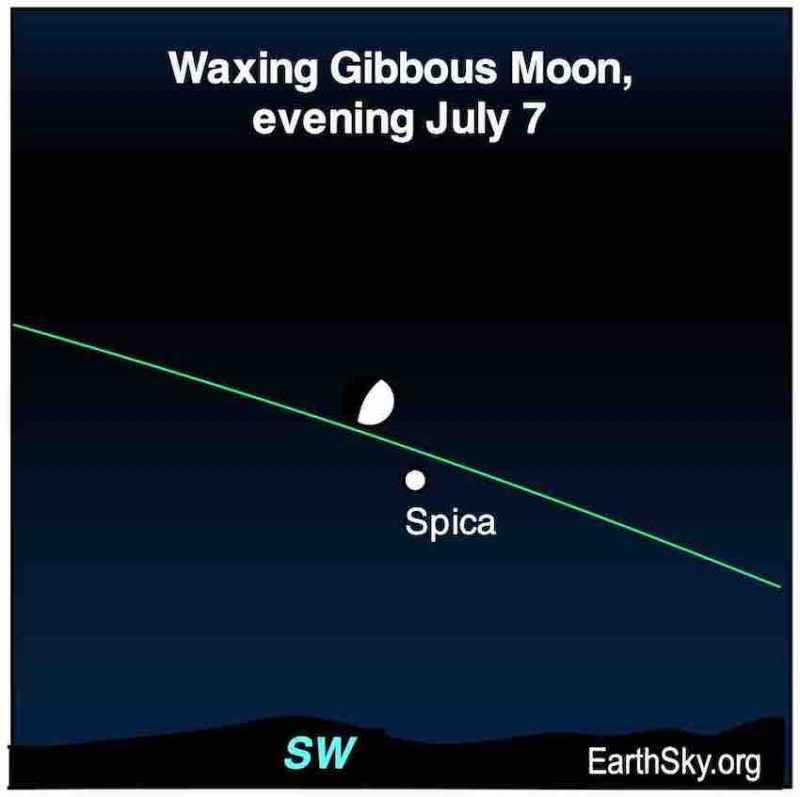
July 10 evening: Moon near Antares
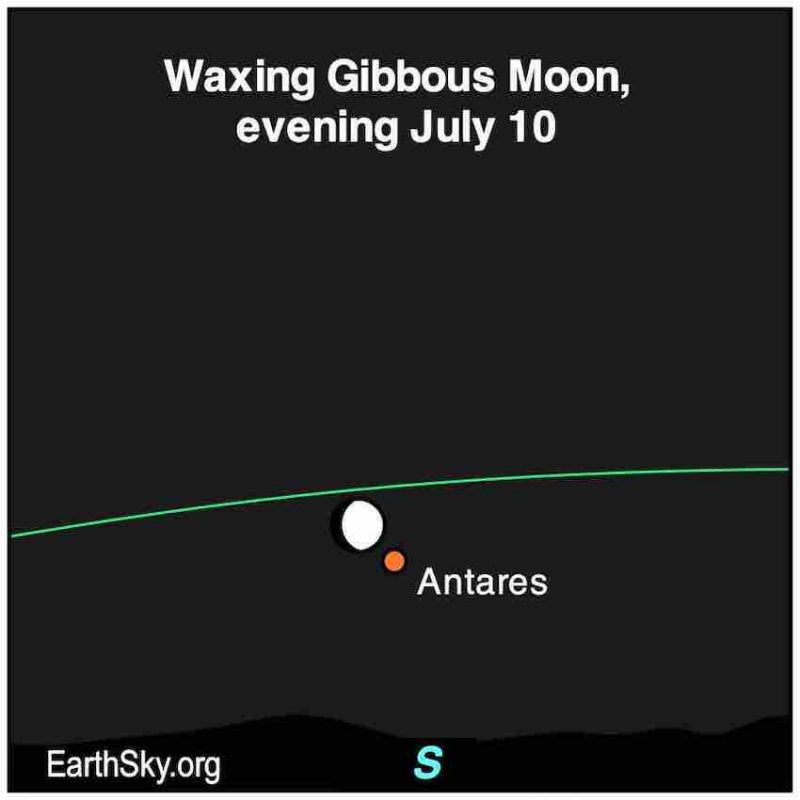
July 11 and 12 evenings: Manhattanhenge

July 13 overnight: No planets, but a Full Moon … it’s a supermoon!
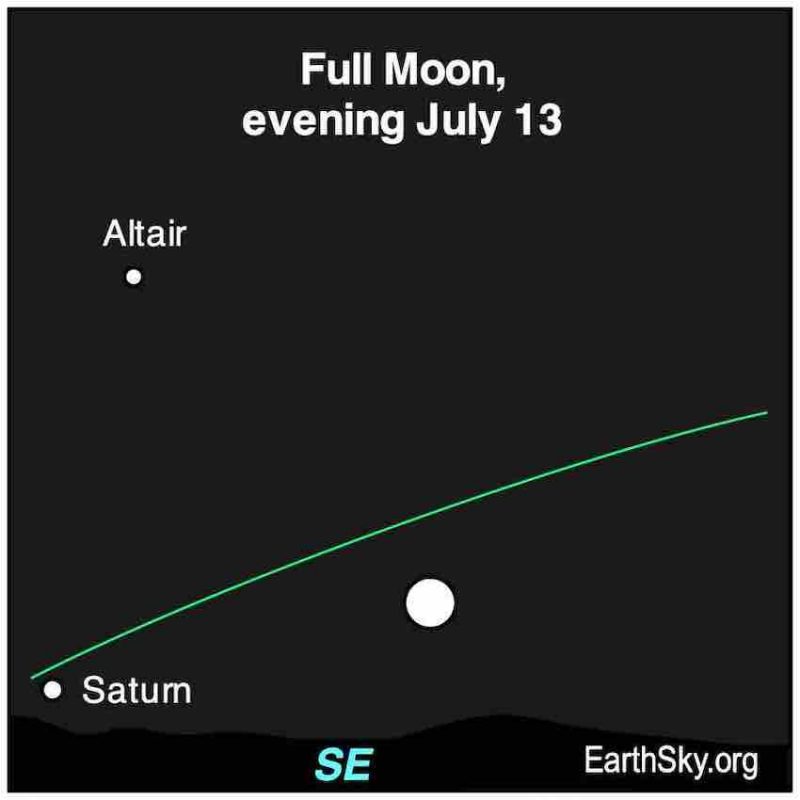
July 14 and 15 overnight: Saturn near moon

In mid-July, with binoculars: Saturn near 2 stars in Capricornus
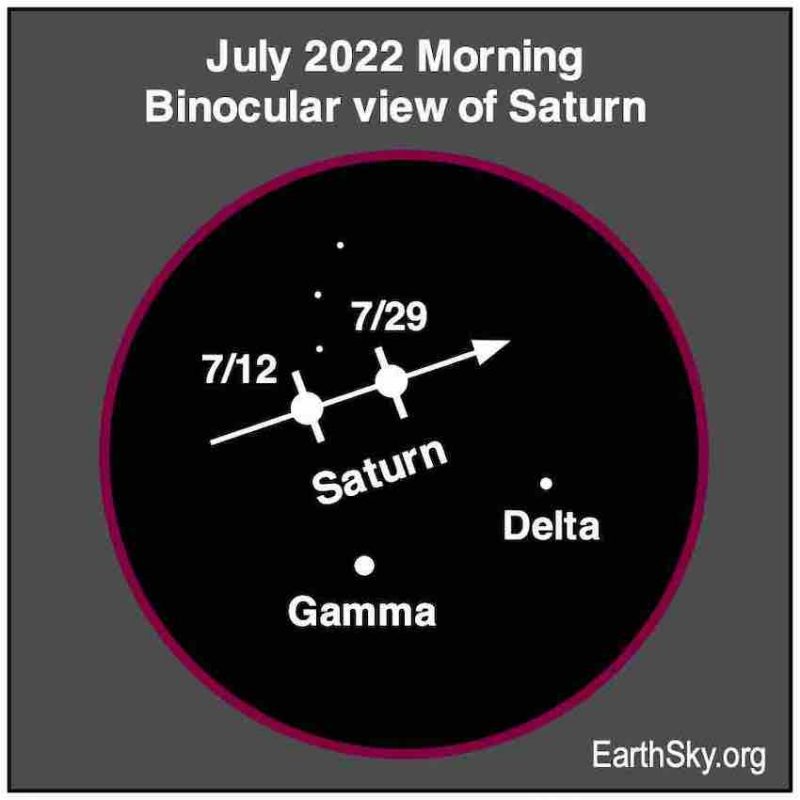
July 18 and 19 mornings: Jupiter near the moon

July 18-22 mornings, with binoculars: Venus near M35 cluster
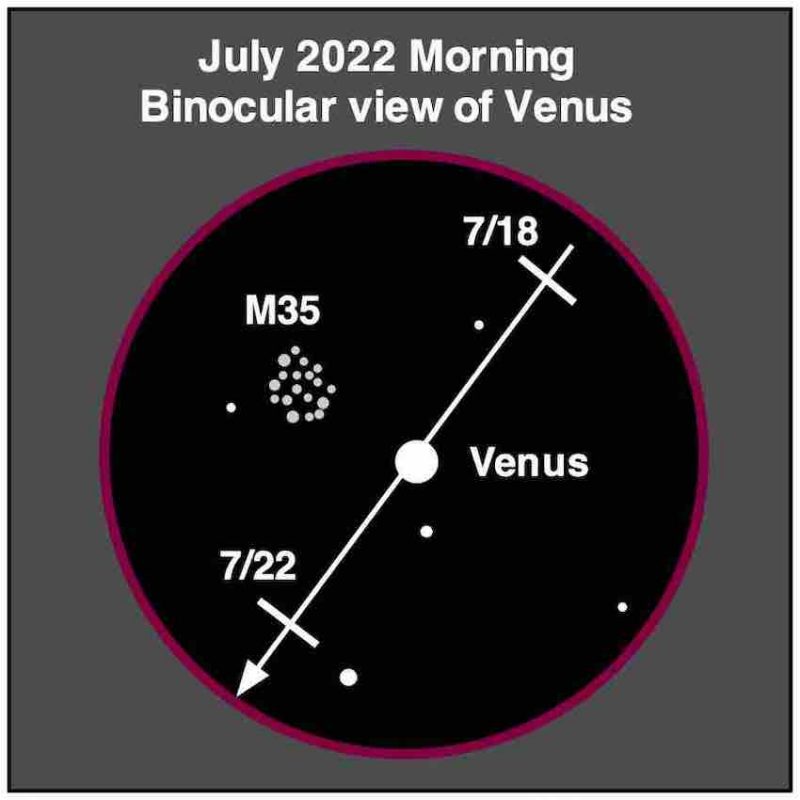
July 21 morning: Mars next to the moon
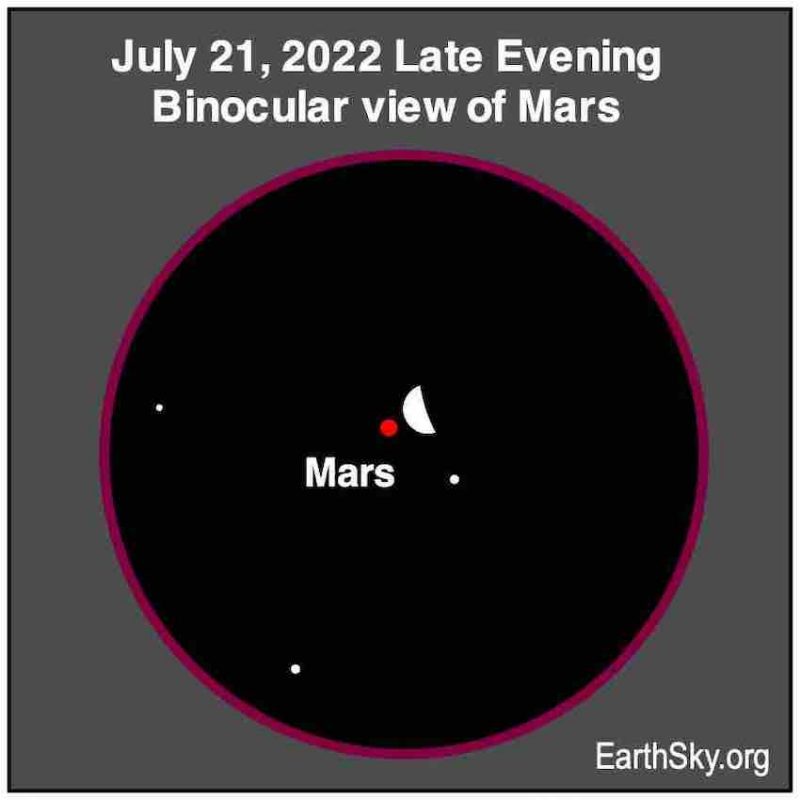
July 23 and 24 mornings: Moon near Aldebaran and Pleiades
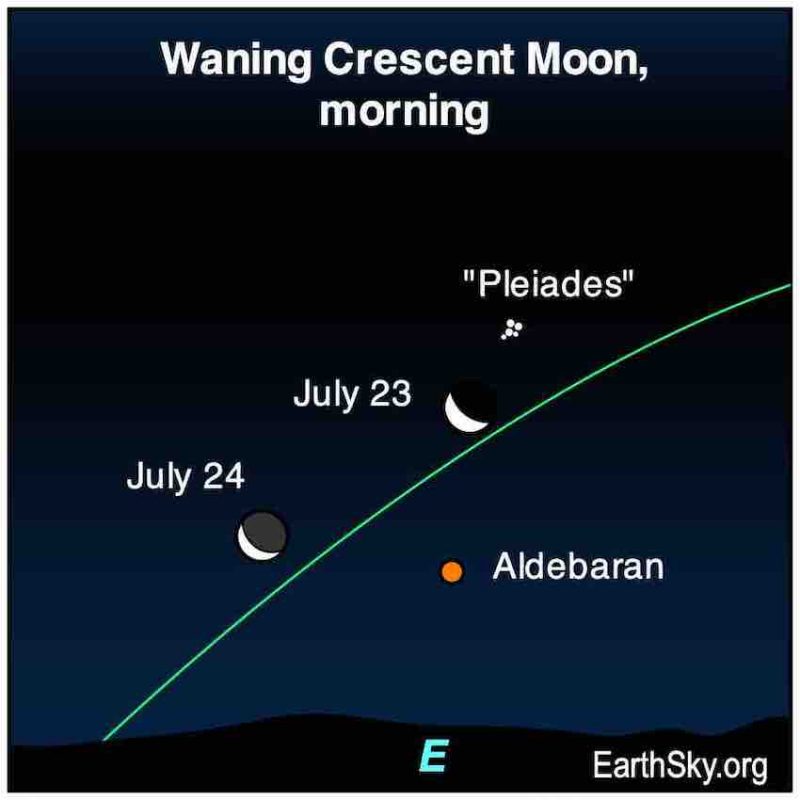
July 25 and 26 mornings: Moon near Venus
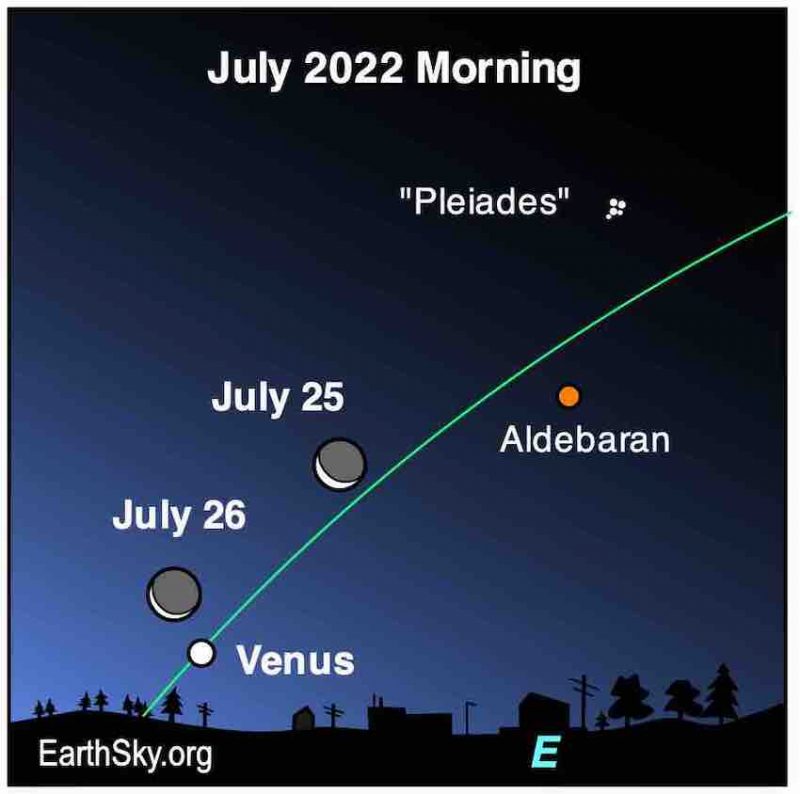
Late July and early August: Delta Aquariid meteor shower
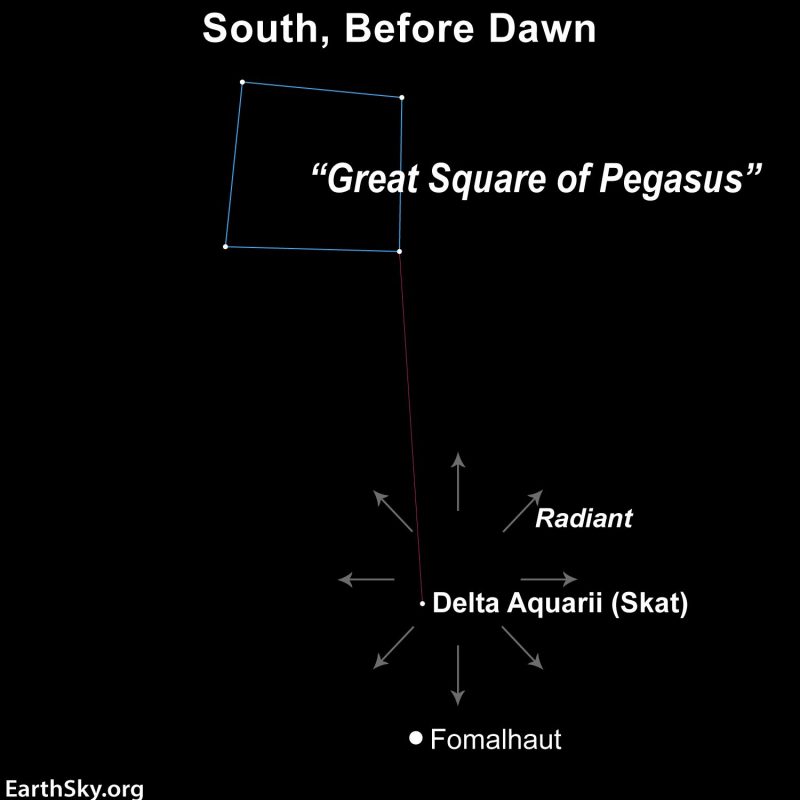
July 30 and 31 mornings, planets with binoculars: Mars next to Uranus
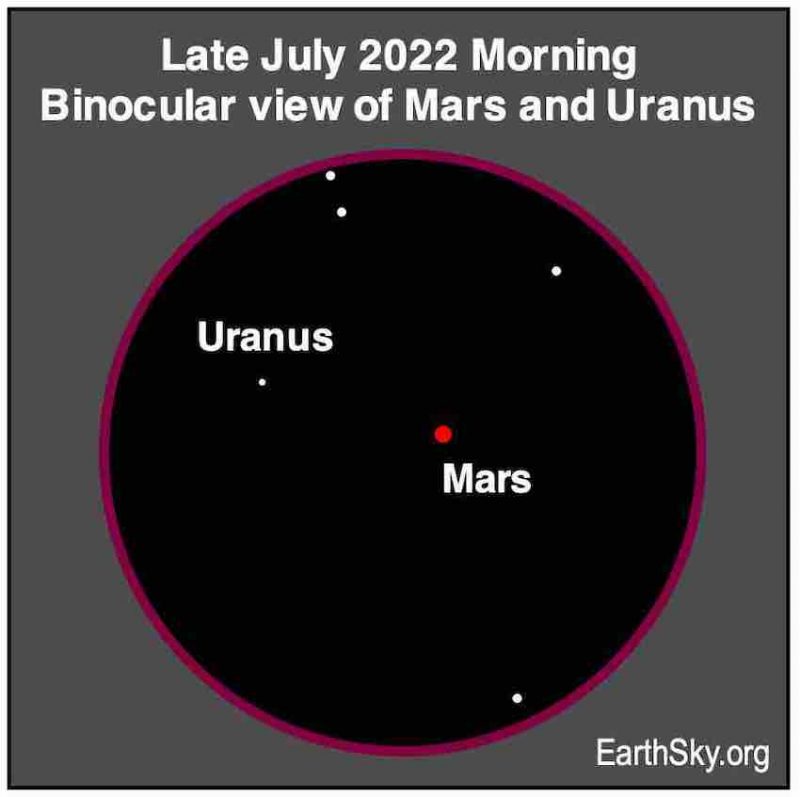
July 30 and 31 evenings: Mercury and the moon (Southern Hemisphere)
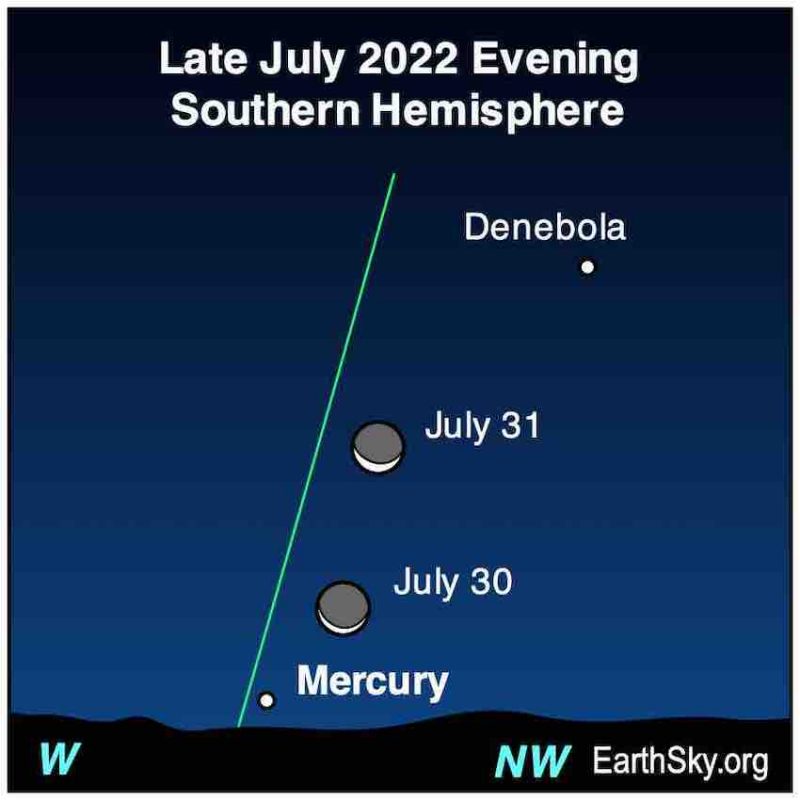
Photos of planets from EarthSky’s community
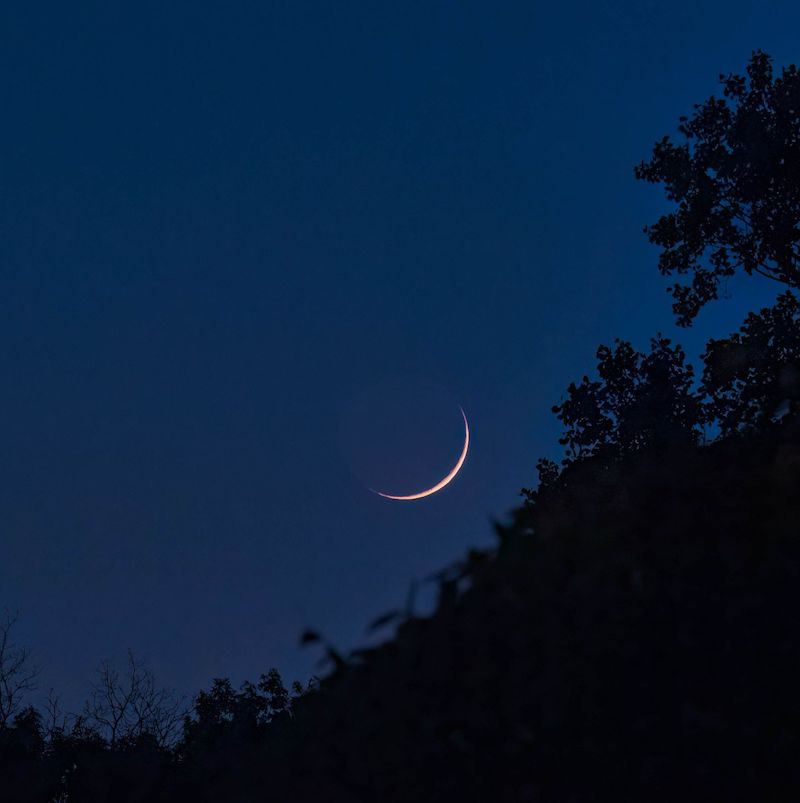
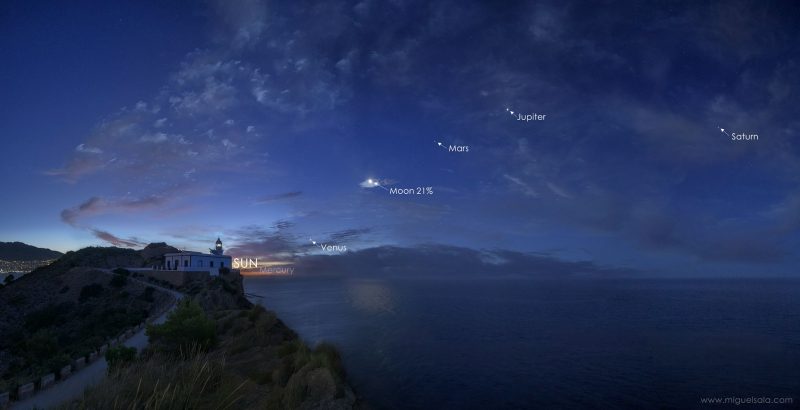

2) Initial Week of July, 2022 (courtesy of skyandtelescope.com)
FRIDAY, JULY 1
■ On the eastern side of the sky, the Summer Triangle holds sway after dark. Its top star is Vega, the brightest on that entire half of the sky. The brightest star to Vega’s lower left is Deneb. Farther to Vega’s lower right is Altair, with fainter Tarazed just above it. The Milky Way (if you have deep darkness) runs across the Triangle just inside its bottom edge.
As evening grows late and even Altair rises high, look left or lower left of Altair, by hardly more than a fist, for the compact little constellation Delphinus, the Dolphin.
Did you get it? Then try for even fainter, smaller Sagitta, the Arrow. It’s to Altair’s upper left, just a little closer. The Arrow points lower left, past the head of Delphinus.
SATURDAY, JULY 2
■ In twilight this evening, look west for the waxing crescent Moon. Left of the Moon is Regulus, and above the Moon is slightly fainter Algieba, Gamma Leonis, as shown below. Like last month, they form an isosceles (two-sides-equal) triangle.
Binoculars help reveal the color difference between the two stars. Also, Algieba is a wide optical double for binoculars and a much closer true binary (5 arcseconds) for telescopes.
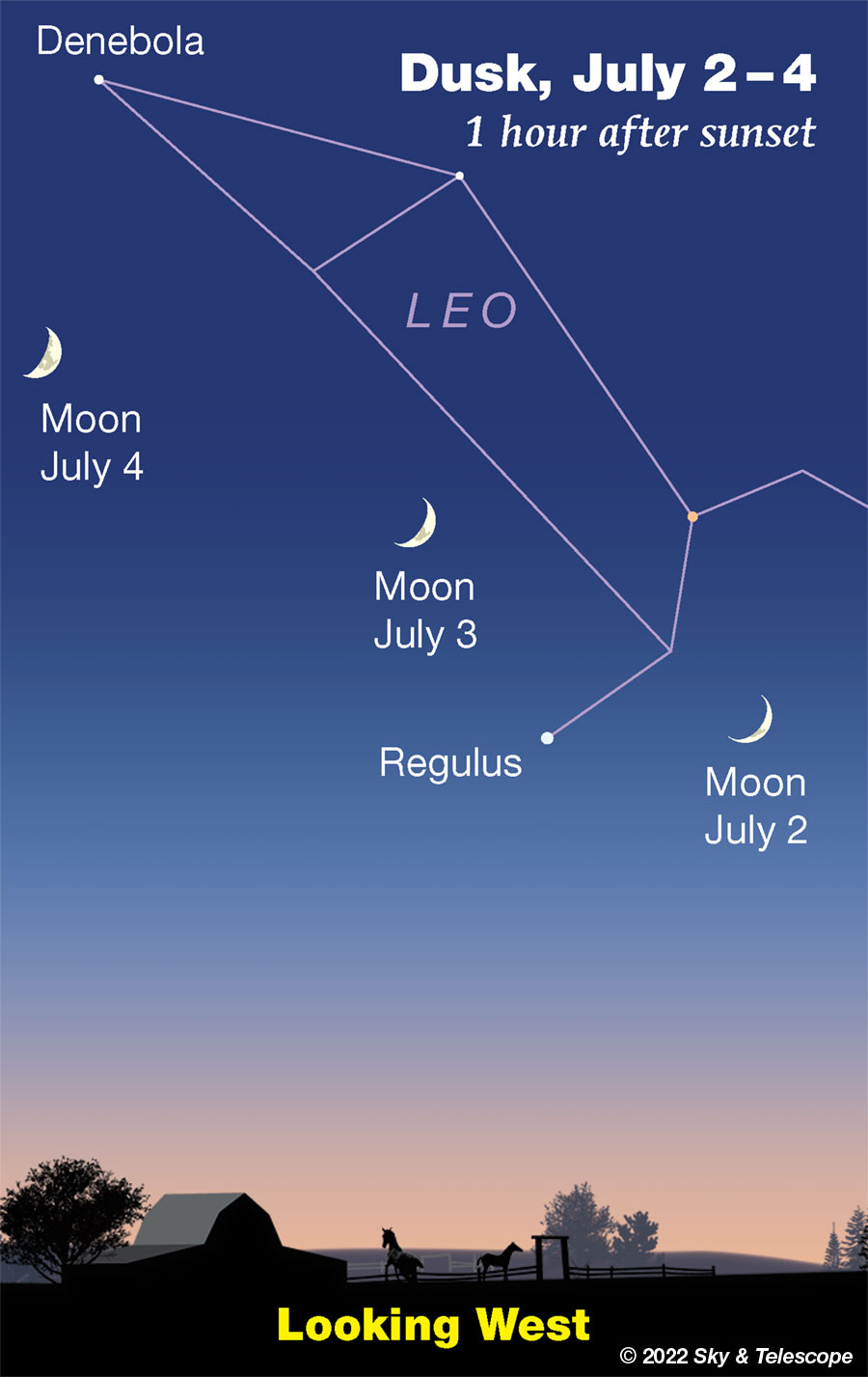
SUNDAY, JULY 3
■ Again the Moon forms an isosceles triangle with Regulus and Algieba, but now it’s on the opposite side of them, as shown above. This time the triangle is also nearly equilateral (in the time zones of the Americas). How close to perfect the equilateral triangle is will depend on your time and place of observation.
MONDAY, JULY 4
■ Low in the northwest or north at the end of these long summer twilights, would you recognize noctilucent clouds if you saw them? They’re the most astronomical of all cloud types, what with their extreme altitude and their formation (in part) on meteoric dust particles. They used to be fairly rare, but in recent years they’ve become more common as Earth’s atmosphere changes. See Bob King’s Nights of Noctilucent Clouds.
■ Earth is at the aphelion of its orbit, its farthest from the Sun for the year: 3% farther than at perihelion in January.
TUESDAY, JULY 5
■ To casual starwatchers or those with an obstructed northern view, Cassiopeia in July might sound as wrong as Christmas in July. But already Cas has passed its lowest evening position of the year and is gradually gaining altitude in preparation for the coming fall and winter. Look for its flattened W shape low in the north-northeast after dark. It’s no longer level.
WEDNESDAY JULY 6
■ First-quarter Moon (exact at 10:14 p.m. EDT). The Moon is in Virgo, with Spica to its left and fainter Gamma Virginis (Porrima) closer to its right or lower right. Brighter Arcturus shines very high above them.
Gamma Vir is a fine close double star for telescopes. Its current separation is 3 arcseconds, and the components are nearly equal in brightness: spectral type F0 V; somewhat larger and hotter than the Sun. They orbit each other in 169 years. The pair is 38 light-years away.
■ Arcturus and Vega are about equally far from straight overhead shortly after dark: Arcturus toward the southwest, Vega toward the east.
Arcturus is pale yellow-orange; Vega is icy bluish white. Star colors are mostly subtle, and different people have an easier or harder time seeing them. To me, the tints of bright stars show a little better in the dark blue of a late-twilight sky than in a fully dark sky.
For instance, compare Vega and Arcturus in twilight and after dark. Do their colors stand out a little better or worse for you one way or the other?
Binoculars, of course, always make star colors much more obvious.
THURSDAY, JULY 7
■ Now Spica shines lower right of the Moon.
■ Look very far left of Spica soon after dark, by 4 or 5 fists at arm’s length, for orange Antares, equally bright. Just before you get to Antares you cross the head (or forehead) of Scorpius: the roughly vertical row of Beta, Delta, and fainter Pi Scorpii.
Delta Sco, the middle one, is the brightest of the three. It’s an irregular variable star, a fast-rotating blue subgiant throwing off luminous gas from its equator. It also has a smaller orbiting companion that now seems to trigger more activity at 10.5-year intervals. Assumed for centuries to be stable, Delta unexpectedly doubled in brightness in July 2000 and has remained nearly that bright, with fluctuations, for many of the years since. Astronomers are waiting to see whether it will have another flareup any time now, as the companion makes its third pass by the primary star since 2000.
Delta Sco is currently about magnitude 1.9, pretty much where it has stayed for the last 11 years.
FRIDAY, JULY 8
■ Titan and its atmosphere to occult a star! David Dunham of the International Occultation Timing Association writes, “Titan, the 8th-magnitude moon of Saturn with a thick atmosphere, will occult a star of the same brightness on Saturday morning, July 9. The occultation will be visible from much of North America: south of the northern limit that crosses central California, the southeast corner of Idaho, and north of Winnipeg, Manitoba. The southern limit crosses northwestern South America. Titan will be 3 arcminutes east of Saturn [about 4 ring-diameters].
“The occultation will last up to 5.5 minutes, shorter especially near the limits. When Titan gets close enough to the star that the two appear to merge, they will appear as a single object of magnitude 7.9. Then, for several seconds, the object will gradually diminish in brightness as the star sinks into Titan’s atmosphere, eventually reaching the magnitude 8.5 of Titan as the star completely disappears. The merged objects will similarly brighten when the star reappears.”
That decline of 0.6 magnitude will difficult to track by eye, “but can be recorded well with a sensitive video or CCD camera.” Such recordings “will be able to measure Titan’s atmosphere at a unique latitude of the moon, possibly recording brightening spikes caused by inversion layers in the atmosphere, as have been recorded during many previous occultations by planets and satellites with atmospheres.
“Of special interest may be the central flash that will occur close to the occultation’s central line, when Titan’s entire atmosphere will focus the star’s light, causing it to brighten briefly well above its un-occulted level at central occultation.”
Maps, timetables for hundreds of locations, and more information are on IOTA’s webpage for this event.
“The next observable occultation of a similarly-bright star by Titan won’t occur until 2048,” writes Dunham, “and that will only be visible from Antarctica, so you are encouraged to make what observations you can of this rare event.”
SATURDAY, JULY 9
■ To the left of the waxing gibbous Moon, look for orange Antares and the rest of the pattern of upper Scorpius.
■ The Big Dipper, high in the northwest after dark, is turning around to “scoop up water” through the evenings of summer and early fall.
PLANET SUMMARY THROUGH JULY 8, 2022:
Mercury is dropping out of sight deep in the glow of sunrise.
Venus (magnitude –3.9) rises just as dawn begins. Look for it above the east-northeast horizon. It’s very far lower left of bright Jupiter, by six or seven fists at arm’s length.
Mars and Jupiter, very different at magnitudes +0.4 and –2.5 respectively, rise after midnight and shine in the east-southeast before and during early dawn. Mars is about two fists to Jupiter’s lower left. They continue to move apart, week by week.
3) Night Sky For July, 2022
To see planet rising times and which ones are present from your location, visit:
https://www.timeanddate.com/astronomy/night/
and
https://www.timeanddate.com/astronomy/
Returning Migrant Birds In July? Yes, Correct:
Visit San Francisco Bay shorelines this month to note the arrival of Arctic and Alaskan populations of Western and Least Sandpiper, northern California’s initial returning migrants that will spend the non-breeding season here or at points farther south. An interesting fact relates to how some tardy northward migrating Western and Least Sandpiper populations in June may actually pass early southward migrating male individuals belonging to the same species. Imagine this phenomenon happening infrequently, but when it does, it’s likely to happen in Washington or British Columbia coastal areas — and not as typical in the San Francisco Bay Area where the initial returning shorebirds/peeps usually return as early as the last week of June and in greater numbers during the initial two weeks of July.
Trailside Nest? It’s Probably A Wood Rat
The Dusky-Footed Wood Rat is a common small mammal that is often overlooked when people walk in woodlands. Active only at night, its presence is easily noticed by its often elaborate and conspicuous conical nest of twigs and branches that can grow two to three feet tall (as more twigs accumulate each year). The wood rat occupying a nest is solitary except for during the breeding season.
Hopping Around: Brush Rabbits
By now, you may see first-year brush rabbits on the landscape. Born from January through August in our area (with greater activity from March through June), young rabbits remain in their nest for two weeks. Females produce 2-4 litters per year, of 1-6 young (average 3-4).
Beating The Heat: California Ground Squirrel
Another common northern California mammal, the California ground squirrel (or Beecheyi’s ground squirrel), is more difficult to spot now because the dry, warm weather reduces vegetation as a food source and therefore induces estivation (“summer slumber”) in some individuals during this time of the year. From now through mid-winter, these 9-11 inch mammals may retire to a burrow until more green growth appears with the first rains and in mid-winter. At higher elevations, these squirrels hibernate from late October through May.
Wood-Warblers Leaving Already?
Do some warblers actually begin dispersing from their breeding areas already? Yes, and this movement includes populations of California-nesting Orange-Crowned Warblers that first disperse to higher altitudes in the foothill and the Sierra Madre Mountains (to the east and northeast of Marin County) where they feed and molt for a period before eventually migrating south in late summer and early autumn.
More Babies? Western Tree Squirrel
Tree squirrels may be having their second “hatch” of babies by now. Using tree cavities as birthing sites, the adults occasionally move the babies from one locale to another in the canopy.
Autumnal Exit: Migrating Birds
Be on the lookout for south migrating shorebirds and sandpipers as they begin their early treks back to wintering grounds from northern breeding areas. Likely first candidates to spot along ocean beaches and in esteros include Western and Least Sandpipers, Greater Yellowlegs, Lesser Yellowlegs (less common than Greater), Willet, Marbled Godwit, Black Turnstone, and, by the end of September, Dunlin. Curiously, it’s actually possible to see both north and southbound migrating birds this month. Go to Limantour Beach at Point Reyes National Seashore, for example, and it would be plausible to see late-migrating northbound Least Sandpipers passing by the first southbound migrating birds of the same species that have already bred to the north.
Hatching Butterflies
The hatching times of butterflies vary throughout the spring and summer. One excellent online resource for the butterfly breeding biology in the McLaughlin Reserve (in Napa and Lake Counties, northwest of Davis by two hours) is accessed at http://nrs.ucop.edu/reserves/mclaughlin/species/butterflypheno.htm. An excellent butterfly field guide that reveals hatching range times is “Butterflies Through Binoculars: A Field Guide to the Butterflies of Western North America,” by Jeffrey Glassberg.
August, 2023
Sky Watch:
This month’s sky is quite eventful as there will be two full moons in August, and both are supermoons. Plus, there’s a meteor shower to look forward to. This year, there will be four supermoons in a row, which is quite rare. The second one in the series, called the “Sturgeon Moon,” will occur on August 1
Night Sky for August 2023: Planets, Stars, and the Moon
(courtesty of almanac.com)

1) Moon & Planet Rise & Set Times (courtesy of almanac.com)
&
2) Planet Highlights:
See planet rise and set times for your location by clicking here.
Or visiting:
https://www.timeanddate.com/astronomy/night/
See planet rise and set times for your location.
Perseid Meteor Shower
The Perseid Meteor Shower lasts most of the month. With the peak (August 11 to 13) washed out by a full Moon, look for the meteors outside of the peak dates and/or focus on dark areas of the sky without the full moon in sight. See Moonrise and set times.
The most active time for shooting stars is when it’s darkest (just after midnight through dawn).
Get viewing tips for this year in our 2023 Perseid Meteor Shower Guide.
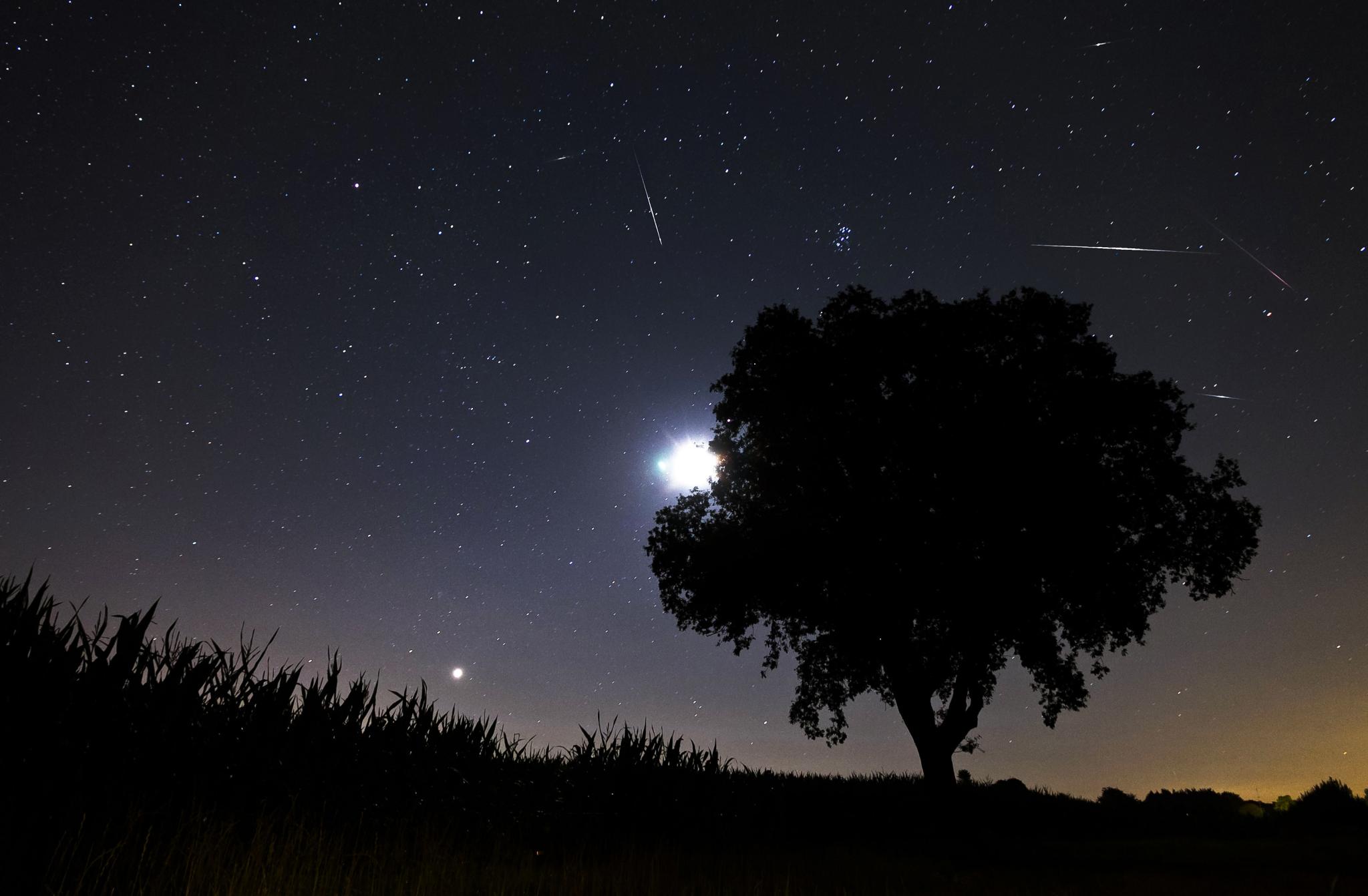
Image: Perseid meteor shower, 2012. Credit: Dennis van de Water/Shutterstock.
Summer Stargazing
 Image: The Summer Triangle is bright even in many city skies. Credit: NASA.
Image: The Summer Triangle is bright even in many city skies. Credit: NASA.
Perseid Meteor Shower
The Perseid Meteor Shower lasts most of the month. With the peak (August 11 to 13) washed out by a full Moon, look for the meteors outside of the peak dates and/or focus on dark areas of the sky without the full moon in sight. See Moonrise and set times.
The most active time for shooting stars is when it’s darkest (just after midnight through dawn).
Get viewing tips for this year in our 202 Perseid Meteor Shower Guide.

Image: Perseid meteor shower, 2012. Credit: Dennis van de Water/Shutterstock.
Summer Stargazing
 Image: The Summer Triangle is bright even in many city skies. Credit: NASA.
Image: The Summer Triangle is bright even in many city skies. Credit: NASA.
Woodpecker Residents
How many resident species of woodpeckers can you typically see in northern California? Five commons ones (Acorn, Nuttall’s, Downy, Hairy, Northern Flicker) are year-round residents, while the Pileated is a less common resident. Red-breasted Sapsuckers arrive in greater numbers during the fall and winter, but they are still never a common sight in Marin County and in most of the Bay Area except for the northwestern portion of Sonoma County where they nest.
Where Can You Find Black-tailed Jackrabbit?
One of the best places to see Black-tailed Jackrabbits (hares) (Lepus californicus) is along San Francisco Bay area recreational lands where trails wind through grasses, forbs and shrubs. April and May are the most common months for Bay Area hares to give birth, with four litters per year consisting of three to four hares the typical reproduction rate for one female. Hares are also common throughout the state, except at the highest elevations.
Long Distance Frequent Flyer: Blackpoll Warbler Migration
Most long-distance avian songbird migrants fly at night. Feeding during the day replenishes their energy. Traveling for long distances over unsuitable habitats and water is not uncommon. Perhaps the most Herculean southerly migration flight is performed by the Blackpoll Warbler whose eastern populations, in part, are known to travel nonstop some 2,200 miles over the Atlantic ocean from New England and eastern Canada to their non-breeding grounds in northern South America. This trip may take the warblers 72-90 hours in flight time, during which they burn .08 grams per hour. If one portion of a Blackpoll’s autumn migration takes 36 hours before they arrive to temporarily rest on the island of Bermuda, then researchers have calculated it would log some 720,000 miles to the gallon if it burned gasoline instead of its own fat (Timothy and Janet Williams, “An Oceanic Mass Migration of Land Birds.” Scientific American (239) (1978): 166-76.)
Birders Guide To Northern California
Vacationers in California occasionally ask me about places that are good for birding. One excellent resource is the book “Birder’s Guide to Northern California,” by LoLo and Jim Westich (Gulf Publishing, 1991). It lists and describes hundreds of birding spots throughout seven regions in northern California and also provides addresses for obtaining more than 25 regional and local bird checklists.
Feathered Jewels: Hummingbirds In The Bay Area
Which species of hummingbirds are you most likely to see in northern California along the coast (e.g., Marin County)? Six species have been observed in Marin County just north of San Francisco: Anna’s are year-round residents, while Allen’s are present as breeders from mid-March through mid-July. Rufous Hummingbirds may also be seen during spring and autumn migration times, while less frequently observed are Black-chinned, Costa’s and Calliope Hummingbirds.
September, 2022
Sky Watch: (courtesy of treehugger.com)
Dust off that sweatshirt, grab a blanket, and enjoy the waning weeks of summer while you’re looking up into the evening sky. Below are just some of the beautiful celestial highlights to look forward to in September 2022.
Catch a View of the Harvest Moon (Sept. 9)
September’s full moon, nicknamed the “Harvest Moon”, reaches peak fullness on September 9 at 5:58 a.m. EDT, but will remain a spectacle in the days just before and after that date.
As its name implies, this full moon is so-called due to its timing (rising for several days just after sunset) in providing crucial light to farmers harvesting their crops. Unlike other full moons, the naming of this one is tied specifically to the fall equinox. As such, the Harvest Moon can sometimes occur in early October (as it did in 2020). When that happens, September’s full moon is appropriately called the “Corn Moon.”
Neptune at Its Closest (And Brightest) to Earth (Sept. 16)
Neptune, the eighth and farthest known planet in our solar system (sorry, Pluto!), will reach its annual opposition—when the Earth passes between it and the sun—on September 16. Despite having a mass 17 times that of Earth, this gas giant is so far away (it takes light four hours to travel between Neptune and Earth during opposition) that it appears very dim even at its closest. To view it, Earth-Sky recommends consulting this chart from TheSkyLive and investing in a tripod-mounted pair of binoculars or a telescope.
Fun fact: Neptune’s winds can reach speeds up to 1,500 miles per hour—the fastest yet detected in our solar system.1 It’s also our coldest planet, dipping down to temperatures of -373 degrees Fahrenheit.2Have your stargazing guests ponder that while you attempt to locate this blue-tinged wonder.
Wave Goodbye to Summer and Greet the Fall Equinox (Sept. 22)
The first day of autumn in the Northern Hemisphere will officially arrive on this day, and for our friends in the Southern Hemisphere, it’s the first day of spring. At 9:03 p.m. EDT, we’ll say goodbye to the lazy days of summer and welcome the start of fall with the autumnal equinox. According to Time and Date, this event marks “the moment the sun crosses the celestial equator—the imaginary line in the sky above the Earth’s equator—from north to south and vice versa in March.”
In anticipation of the colder months ahead, the fall equinox offers an important reminder to start thinking about firewood, pumpkins, and dusting off your warmer clothing. According to the Farmers’ Almanac’s long-range forecast—which, like any long-range weather forecast, should be taken with a grain of salt—the coming winter could have “the coldest outbreaks of arctic air we have seen in several years.”
September’s Late New Moon Gives Way to Dark Skies (Sept. 25)
:max_bytes(150000):strip_icc()/HelixNebula-eeffd194c53745ac83a0cd4e114db92b.jpeg)
September’s new moon will arrive on September 25, with the lunar surface illuminated by the sun facing away from Earth. This phenomenon will give way to exceptionally dark skies devoid of moonlight and perfect for observing galaxies, planets, and other celestial wonders.
Need a target? This month, we’re recommending the Helix Nebula (NGC 7293) or, as it’s more widely known, the “Eye of God.” Located roughly 650 light-years from Earth, it’s one of the closest planetary nebulae and easy to spot through binoculars or small telescopes. It’s believed to have formed about 10,600 years ago when a dying star exploded and shed its outer layers into space. To spot it, the site Cosmic Pursuits recommends looking “10ºNW of the bright star Fomalhaut.” Check their star chart here and good luck!
Watch NASA Crash a Spacecraft Into an Asteroid (Sept. 26)
In an effort to better understand the methods that could one day help us deflect a celestial body on a collision course with Earth, NASA on September 26 will fly its Double Asteroid Redirection Test (DART) spacecraft directly into the path of an asteroid named Dimorphos. This half-mile-wide asteroid, about 6.7 million miles from Earth, orbits a much larger asteroid named Didymos. NASA is eager to discover how the impact changes orbital relations between the two—valuable data that could one day help us design larger asteroid-deflecting spacecraft.
Coverage of the event will begin live at 6 p.m. EDT on September 26, 2022, on NASA’s website. DART is expected to make its violent encounter with Dimorphos at approximately 7:15 p.m. EDT.
Jupiter Makes Its Closest Approach in 70 Years (Sept. 26)
On September 26, Jupiter will be at its closest and brightest in nearly a century. Called opposition, this annual celestial phenomenon occurs when Earth’s faster orbit places it directly between a planet and the sun. At “only” a little over 367 million miles from Earth, this will be the closest Jupiter has come in 70 years and the best we’ll get for the rest of the 21st century. Get out those telescopes and binoculars!
To spot the great gas giant, its colorful atmosphere, and even some of its 79 moons, look to the east just after sunset. It will be 18 times brighter than its close neighbor Saturn. And if you miss it on the 26th, no worries—Jupiter will be just as close and bright nearly all of September and into October.
Welcome Back the Haunting Zodiacal Light (late Sept.)
This celestial object (aka the Zodiacal light) also signals the start of fall for the Northern Hemisphere. It’s described as a “cone-shaped glow,” similar to the Milky Way’s dusty look, but made out of comet and asteroid dust. It’s estimated that for this phenomenon to remain a steady presence in our skies, some three billion tons of matter must be injected into it each year by comets. For best viewing, look up your local sunrise time and subtract an hour—and make plenty of coffee to keep you awake as this “false dawn” appears.
1) Moon & Planet Rise & Set Times
For your area’s moon & planet rise & set times, go to: https://www.timeanddate.com/astronomy/night/
Type in your location’s city and state. Then note the results (below in the table) similar to the ones for my location at latitude: 38:03:38 N, longitude: 122:32:27 W, which is Novato, CA, 20 miles north of San Francisco, CA in Marin County.
2) September Night Sky
Jupiter is at its best all month, reaching opposition in late September. Saturn puts on a great evening show, along with a brief view of elusive Mercury soon after sunset. For early risers, the morning sky carries a growing Mars as its main planetary focus, while early in the month you can catch Venus in the bright morning twilight.
Mercury hugs the western horizon during the first two weeks of September, poorly placed for Northern Hemisphere observers. It is also fading, shining at magnitude 0.4 on Sept. 1 and setting 50 minutes after the Sun. Try to spot the planet 3° high at 8 P.M. local time. If your sky is clear and transparent enough to see Arcturus shining through twilight 40° above the horizon, drop straight down to find the approximate location of Mercury. By Sept. 5, Mercury’s brightness dims to 0.6 and it drops to 3° altitude within 20 minutes of sunset. Southern Hemisphere observers have a better time following the planet this time around.
The early evening is dominated by Saturn’s appearance in the southeastern sky as darkness falls. It’s now a month past opposition. On Sept. 7 and 8, a gibbous Moon stands near the ringed planet. Saturn is 20° high by 9 P.M. local time in early September. It glows at magnitude 0.3 in western Capricornus the Sea Goat, outshining 1st-magnitude Fomalhaut 24° to its southeast.
Follow Saturn all evening as it climbs higher; it shows off best when it is 35° high in the southern sky, around local midnight. Telescopic views reveal the magnificent ring system, visible even in the smallest scope. The apparent tilt of the rings increases to 15° by Sept. 30, slightly better than the 12° tilt over the summer. Overall, this angle is declining as Saturn moves along its orbit; such variations are the result of the way Saturn’s orbit is tilted with respect to Earth’s by 2.5°.
Saturn’s disk remains near its peak diameter of 18″ across the equator, with a polar diameter of 16.5″. The rings span 42″ across the major axis and only 10″ across the minor axis. By 2025, they will appear edge-on.
Titan, Saturn’s largest moon, is magnitude 8.5, an easy target for small telescopes. You’ll find it north of Saturn early on Sept. 6 and 22, and due south Sept. 14 and 30. It lies due east of the planet on Sept. 25. Inside Titan’s orbit are many more moons, all fainter. Tethys, Dione, and Rhea shine at 10th magnitude and orbit every two to five days.
Iapetus passed superior conjunction in late August and now heads to a Sept. 15 eastern elongation, when it appears faintest — about 12th magnitude — nearly 9′ due east of Saturn.
Neptune reaches opposition Sept. 16 and is consequently visible all night. Shining at magnitude 7.7 in northeastern Aquarius, it’s within easy reach of binoculars. Find it 5° due south of Lambda (λ) Piscium, the southeasternmost star in the Circlet of Pisces asterism. With Jupiter coming to opposition 10 days later, it is not far away, 11° east of Neptune.
Wait until late evening, once Neptune has reached a decent altitude, then scan the region with binoculars. Look for a zigzagging line of four stars 5° south of Lambda, each slightly fainter than its western neighbor (magnitudes 6.3 to 7.2). The group looks like a miniature Cassiopeia, with one star missing in the northwest. Follow that line east to a bright magnitude 5.5 star — Neptune is roughly midway between this and the zigzag’s easternmost star. A telescope will reveal the distant planet’s dim bluish disk, spanning a mere 2″.
Jupiter reaches opposition on the 26th in southern Pisces. It rises soon after 8:30 P.M. local time on Sept. 1 and by sunset at the end of the month. It shines all month at magnitude –2.9, the brightest object in the night sky after the Moon. The planet is best viewed when it’s highest above the southern horizon, which occurs in the few hours on either side of local midnight.
Jupiter’s apparent diameter reaches a stunning 50″ by late September, and any telescope will reveal magnificent features in its turbulent and dynamic atmosphere. Try observing the brown-tinted equatorial belts and the salmony-red hue of the Great Red Spot. Colors can be enhanced by using quality eyepieces and modest magnification. High magnification tends to blur features because you also magnify Earth’s atmospheric turbulence.
It’s the best time to capture high-speed video frames as well — you will need long focal lengths. Adding a 2x Barlow helps. Check your collimation each night for the best results.
Jupiter’s atmospheric features move quickly with its roughly 10-hour rotation period. Also keep watching the ever-changing positions of its four Galilean moons. They orbit with periods ranging from two to 16 days.
As opposition nears, transits of moons and their shadows occur almost at the same time. Prior to opposition, the shadow comes first, while after opposition, the shadow trails the moon. You can see this effect particularly with Io, which transits Sept. 16 and 23. On the 16th, the transit is underway when Jupiter rises in the Midwest; note the separation between Io and its shadow. They leave the disk 15 minutes apart, starting at 10:13 P.M. EDT. On the 23rd, the event starts just before 10 P.M. EDT, with the shadow leading the way and Io following, now only five minutes later. The moon and shadow almost overlap — we are three days from opposition. Can you separate them visually?
Europa and its shadow transit Sept. 6. You can spy the shadow starting at 9:46 P.M. EDT, followed by the moon just over an hour later. Catch Ganymede and its large shadow transiting the evening of Sept. 20 — the event is again underway for Midwestern observers as Jupiter rises. The shadow leaves the disk over a period of about 10 minutes starting around 10:55 P.M. EDT. Ganymede itself leaves the disk about 30 minutes later.
The four moons typically reside east or west of Jupiter in a line. But the tilt of its orbital plane is such that Callisto, the moon farthest from Jupiter, misses a transit when at inferior conjunction. Instead, spot Callisto due south of Jupiter overnight on Sept. 4/5.
Uranus resides in Aries the Ram all month and shines at magnitude 5.7. It is approaching opposition in November. This is a good time to spot the distant planet, which is a fine challenge for binoculars, since it lies in a sparse region of the sky. Second-magnitude Menkar in Cetus is a good guide. Uranus stands 13° due north of this star, slightly less than two fields of view in 7×50 binoculars. Find three 6th-magnitude stars forming a triangle (one is 53 Arietis); Uranus, somewhat brighter, is in the middle.
The next three months are a great time to check out Uranus with a telescope. Its tiny, aqua-hued 4″-wide disk is a sight to behold, more than 1.7 billion miles from Earth. Use higher magnifications on nights of good seeing for the best views.
Mars joins Aldebaran in Taurus the Bull, changing the appearance of this familiar constellation. At magnitude –0.2, the Red Planet outshines the 1st-magnitude star; Mars brightens to magnitude –0.6 by Sept. 30. Watch the pair rise together in the east in early September just before local midnight, separated by about 5°. Mars passes 4° due north of Aldebaran Sept. 8.
The Red Planet rises around 10 P.M. local time at the end of the month. Throughout September, Mars moves east through Taurus. Late in the month, Mars, Aldebaran, and Betelgeuse form a lovely triangle of brilliant red-hued objects.
The best time to view Mars through a telescope is the hour or two before dawn, when it stands more than 60° high. It’s been a long time since the Red Planet was this high in the sky for Northern Hemisphere observers. Mars is now a fine object spanning 10″, growing to 12″ through the month. Its distinctive phase of 85 percent also grows, ending September at 88 percent. This offers observers great opportunities to spot its polar cap and many dark features.
In the hours soon after midnight, the following features lie on the Earth-facing hemisphere: Sept. 1: Tharsis ridge, Sept. 8: Valles Marineris, Sept. 14: Hellas basin with Syrtis Major rotating off, Sept. 22: Mare Cimmerium with Syrtis Major rotating on, Sept. 30: Mare Sirenum. Enjoy becoming familiar with these features as Mars approaches its early December opposition. Practice imaging now so your workflow is well developed by then.
Venus shines as a brilliant morning star at magnitude –3.9 in the predawn twilight in early to mid-September. Its elongation from the Sun is diminishing and the planet is only 9° from our star on the 18th. Venus spends most of the month in Leo the Lion, sliding north of 1st-magnitude Regulus from Sept. 4 to 5. A lovely crescent Moon stands 9° above Venus the morning of Sept. 24. Look for them about 25 minutes before sunrise. Venus shows off a full disk (99 percent lit) in a telescope.
AUTUMNAL EQUINOX
September brings transition from summer to fall! Officially, autumn begins at the moment of the equinox— 9:03 p.m. EDT on September 22. Learn more about the first day of fall in the Northern Hemisphere!
FULL HARVEST MOON
Per above: September’s full moon, nicknamed the “Harvest Moon”, reaches peak fullness on September 9 at 5:58 a.m. EDT, but will remain a spectacle in the days just before and after that date.
. . .And The First Hibernating Mammal Is?:
You were correct if you said Yellowbelly Marmot (Marmota flaviventris), an inhabitant of high altitudes that turn cool early in southeastern, eastern, and northeastern California. Some individuals of this species may begin hibernation in August, prior to which they begin estivation as early as June (!). A mammal that begins hibernation in September is the Western Jumping Mouse (Zapus princeps), which has a breeding range that extends from New Mexico north to Alaska and the Northwest Territories. The northernmost populations probably enter hibernation prior to southern individuals, with northern California populations possibly entering their winter “sleep” phase in mid- to late-October.
Given this mammal’s breeding range does not include Marin County, it’s likely that our only hibernating mammals could be the Little Brown Bat (Myotis lucifugus) and some localized populations of California Ground Squirrel (Spermophilus beecheyi). Least Chipmunks (Eutamias minimus) in far eastern and northeastern California also hibernate, as do some Whitetail Antelope Squirrel (Ammospermophilus leucurus) populations in northeastern California.
Secret Code: Fireflies In California? Elsewhere?
Does California host fireflies like much of the rest of the USA? Yes, but our species do not have the ability to create bioluminescent light patterns. Elsewhere in the USA (especially in the Midwest/East), watch for the pulsing light show of fireflies in meadows, fields and forest borders. The aerial flights of flashing light are made by male fireflies only. Females may respond in kind from their perches on the ground. Males checkout the light pattern emitted from females by flying closer, then mating if the flashing pattern is acceptable. If you see a different pattern of flashing light from a firefly, it may be another species. You can attempt to distinguish species from one another by noticing the number, duration and time lapse between flashes.
Bats: Lucky 13 In The Bay Area
How many species of different bats can be found in California? Twenty-one, according to a checklist compiled by Daniel F. Williams (Dept. of Biological Sciences, California State University, Stanislaus, Turlock, CA 95382; see http://arnica.csustan.edu/esrpp/calilist.htm). Approximately 13 of these species can be seen in the San Francisco Bay Area. At least 40 species of bats occur in N. America, some of which are threatened or endangered.
Migrating Butterflies I Have Known
Besides monarchs, who are the other migrating butterflies? Two of them are the painted lady and red admiral. High ridges are especially good vantage points to spot monarchs moving south. Butterfly watchers in the East and Midwest will see monarchs on their trips south to where they will remain throughout the winter in the Transvolcanic Mountain range of central Mexico. Western populations of migrating monarchs often congregate together in huge colonies along the central California coast (e.g., Pacific Grove near Monterey, CA).
We’re Outta Here: En Masse Exit
Now is the time to notice “staging” behavior of some birds. Swallows and nighthawks, for example, congregate in large groups on telephone lines and in trees before migrating south together en masse. Unlike most passerine birds, many swallows and nighthawks migrate during the day — as do Lesser, Lawrence’s, and American Goldfinch, in addition American Robin and Northern Flicker.
Introducing The Names Of Introduced Mammals
Thirteen species of mammals living in California are introduced non-natives, including the Virginia opossum, eastern gray tree squirrel, fox squirrel, wild burro, wild horse, axis deer, fallow deer, nutria (probable), feral goat, and Himalayan tahr (a kind of bovid).
Are Hummingbirds Around During Winter?
Where do hummingbirds go for the winter? Most species depart from the United States, though some populations of the Anna’s hummingbirds appear to remain in California throughout the winter. During many years, this species may begin courtship in December (before Winter begins!) in some parts of its range. Ruby-throated hummingbirds east of the Mississippi River begin migrating south around now through October. Many spend the winter in southern Mexico, though a few live on Florida Key islands and in Cuba (95 miles from Key West).
A curious phenomenon in recent years is the increasing diversity of hummingbirds appearing during the winter in the eastern USA. Rufous Hummingbirds appear to be the most common “newly-discovered” hummingbird species seen in the southeast, while two Calliope Hummingbirds spent much of the 2001-2002 winter at feeders near New York City. Some researchers and bird banders believe the Rufous may either be more commonly noticed in the East because it has recently changed its migration/dispersal behavior (due to global warming?) and/or it is more accurately observed now because of recently-increased banding and monitoring.
Rare Bird Sightings
One of the best West Coast places to spot vagrant songbirds is in western Marin Co. in Point Reyes National Seashore. At the point near the lighthouse and amidst nearby groves of Monterey Cypress trees, diverse species of wayward eastern wood-warblers are best spotted in September and October. If you go, don’t be surprised to see American
Redstart, Blackpolls, Blackburnian, Black-and-White, and Prairie Warblers. Note: American Redstart and Black-and-White are not considered vagrant species in California by some theorists because the state sometimes hosts nesting individuals annually or irregularly. Other songbirds that may make cameo appearances here include Rose-breasted Grosbeak and Baltimore Oriole.
October, 2023
Sky Watch: (courtesy of almanac.com)
With the autumnal equinox, the seasons have turned and we’ll enjoy darker night skies ahead—great for seeing some really bright planets and meteor showers! Here are Bob Berman’s highlights of the monthly
At nightfall, planets Saturn, Jupiter, and Mars are now worthy targets for backyard telescopes.
- On the 5th, that bright planet above the Moon is Saturn.
- Then on the 8th, find the Moon and look below for Jupiter.
- And on the 14th, find the Moon and spot Mars nearby. The Red Planet (Mars), which actually appears orange, reaches a brilliant magnitude –0.86 and rises at 10 p.m. in Taurus.
Mercury, which reaches a very bright magnitude –1.0, rises for its best 2022 appearance as a morning star, especially after the 12th.
Venus has its superior conjunction on the 22nd.
Moon & Planet Rise & Set Times For October, 2023
For your area’s moon & planet rise & set times, go to: https://www.timeanddate.com/astronomy/night/
Type in your location’s city and state. Then note the results (below in the table) similar to the ones for my location at latitude: 38:03:38 N, longitude: 122:32:27 W, which is Novato, CA, 20 miles north of San Francisco, CA in Marin County.
For example, where I live, here’s the current information:
Visible night of Oct 9 – Oct 10, 2023
| Mercury: | From Tue 6:37 am |
|---|---|
| Venus: | From Tue 3:32 am |
| Mars: | Until Mon 7:11 pm |
| Jupiter: | From Mon 7:52 pm |
| Saturn: | Until Tue 3:31 am |
| Uranus: | From Mon 8:14 pm |
| Neptune: | Until Tue 5:34 am |
This Week’s Sky: (courtesy of skyandtelescope.com)
FRIDAY, OCTOBER 6
■ Arcturus shines in the west as twilight fades away. Capella, equally bright, is rising in the north-northeast (depending on your latitude; the farther north you live the higher it will be.) They’re both magnitude 0.
Later in the evening around 8 or 9, Arcturus and Capella shine at the same height. When will this happen? That depends on both your latitude and longitude.
When it does, turn around and look low in the south-southeast. There’s 1st-magnitude Fomalhaut at about the same height — exactly so if you’re at latitude 43° north (Boston, Buffalo, Milwaukee, Boise, Eugene). Seen from south of that latitude, Fomalhaut will appear higher than Capella and Arcturus are. Seen from north of there, it will be lower.
That bright light more than a third of the way from Capella to Fomalhaut is Jupiter.
Higher above Fomalhaut glows Saturn, pale yellow and steady.
■ Up really late tonight? The Moon, just past last quarter, rises around midnight (depending on your location). Once it’s well up in the early morning hours of the 7th, you’ll see that it’s keeping company with Castor and Pollux, the heads of the Gemini twins, as shown below.

As always, the Moon here is exactly placed for an observer near the middle of North America. From where you are, the Moon’s position against the stars may differ slightly.
SATURDAY, OCTOBER 7
■ The Great Square of Pegasus balances on its corner high in the east at nightfall. For your location, when will it be exactly balanced? That is, when will the Square’s top corner be exactly above its bottom corner? This will be sometime in the evening depending on your latitude and longitude. Try lining up the stars with the vertical edge of a building as a measuring tool. The tilt of the line changes very slowly.
SUNDAY, OCTOBER 8
■ Cygnus the Swan, with Deneb as its tail, floats straight overhead after nightfall. Its brightest stars form the big Northern Cross. When you face southwest and crane your head up, the cross appears to stand upright. It’s about two fists at arm’s length tall, with Deneb as its top. Or to put it another way, when you face that direction the Swan appears to be diving straight down.
MONDAY, OCTOBER 9
■ Set your alarm for about 1¼ or 1½ hours before your sunrise time on Tuesday morning the 10th, and you can catch Venus, the “Morning Star,” hanging with the Moon. They’re the two brightest celestial objects after the Sun. Much fainter is Regulus between them, as shown below.
The Moon and Venus will be 5° apart, meaning the trio will fit into the field of view of most binoculars.

TUESDAY, OCTOBER 10
■ After dark, Vega is the brightest star very high west of the zenith after dark. Face west and look up at it. To Vega’s lower right by 14° (nearly a fist and a half at arm’s length) is Eltanin, the nose of Draco the Dragon. The rest of Draco’s fainter, lozenge-shaped head is a little farther behind. Draco always eyes Vega as they wheel around the sky.
The main stars of Vega’s own constellation, Lyra — also pretty faint — extend 7° from Vega on the side opposite Draco’s head.
Farther on in the same direction, you’ll see that Lyra’s pattern points to Altair.
■ In early dawn Wednesday morning, the waning Moon shines lower left of Venus and Regulus as shown above.
WEDNESDAY, OCTOBER 11
■ This is the time of year when, after nightfall, W-shaped Cassiopeia stands on end halfway up the northeastern sky — and when, off to its left in the north, the dim Little Dipper extends left from Polaris.
THURSDAY, OCTOBER 12
■ After dark, spot the W of Cassiopeia high in the northeast. It’s standing almost on end. The third segment of the W, counting down from the top, points down. Extend that segment twice as far down as its own length, and you’re at the Double Cluster in Perseus. This combined pair of little gray glows is dimly apparent to the unaided eye in a dark sky (use averted vision), and it’s visible from almost anywhere with binoculars. It’s two lovely star-spangles in a telescope.
FRIDAY, OCTOBER 13
■ Vega is the brightest star high in the west these evenings. Less high in the southwest is Altair, not quite as bright. Just upper right of Altair, by a finger-width at arm’s length, is little orange Tarazed. Down from Tarazed runs the stick-figure backbone of the constellation Aquila, the Eagle, along the Milky Way.
SATURDAY, OCTOBER 14
■ Annular eclipse of the Sun today. The path of annularity crosses Oregon, northern Nevada, Utah, New Mexico, west-central and southern Texas, Central America, Colombia, and Brazil.

Meanwhile, a partial solar eclipse will be seen over a much wider area: practically all of North, Central, and South America and the Caribbean.
Maps. Timetable for places in the path of annularity. Timetable for the partial eclipse elsewhere in US. Timetable for Canada. More about this event is in the October Sky & Telescope starting on page 34. Plan your eclipse-sequence photography starting on page 60.
Online are Fred Espenak with Observing October’s Annular Eclipse and Jay Anderson on chasing clear skies as the final days count down: DIY Weather Forecast for the October 14th Eclipse.
■ New Moon — because, of course, it’s solar eclipse day! The exact time of new Moon is listed in almanacs as 1:55 p.m. EDT. This time refers (as always) to a hypothetical observer at the center of the Earth.
SUNDAY, OCTOBER 15
■ Now that it’s mid-October, Deneb has replaced Vega as the zenith star after nightfall (for skywatchers at mid-northern latitudes). Accordingly, Capricornus has replaced Sagittarius as the zodiacal constellation low in the south.
Waterfowl Invasion
The San Francisco Bay and northern California bodies of water host an amazingly large population of ducks that spend the non-breeding season in our area. Survey results indicate half the entire population of Northern Shoveler spend the non-breeding season in northern California, as do an almost equally massive percentage of both Lesser and Greater Scaup populations. By now, you may also spot other returning winter resident waterfowl in open waters, including Canvasback, Redhead (less common), American Wigeon, Green-winged Teal, Ring-necked Duck, Northern Pintail, Red-breasted Merganser, Gadwall, Mallard, Common Merganser, Northern Pintail, and Ruddy Duck — with the latter five species as residents in Marin County that are joined by newly-arriving populations from the north.
Feeder Philosophy With Hummingbirds
When should you stop feeding hummingbirds sugar water nectar? In northern California/Bay Area, you can serve nectar year-round because the Anna’s Hummingbird is a resident. In the Midwest and the East, the answer is less clear. One group of birders believe feeders left stocked in the autumn may imperil hummingbirds because this food source allows foraging to occur later than would be accommodated with a normal bloom of wildflowers. Awakening to an early freeze may be difficult for remaining hummingbirds to survive, argue these experts. Others believe it is okay for nectar feeders to remain well into autumn. Hummingbirds are uninfluenced by food source availability and migrate when prompted by an “inner clock,” according to these people. This viewpoint is in concert with researchers who have studied migration. These experts point out that many species of migrating birds are undistracted by food sources that would normally attract their interest.
Night Aversion: Arctic Tern
It’s well known that the arctic tern makes the longest migration (22,000-25,000 miles roundtrip) of any bird along with the Bristled Curlew that migrates in autumn from the Arctic to the South Pacific. In northern California, you won’t often see them along the coast, while your chances of observation during their migration improve if you take a pelagic boat trip onto the open ocean.
Less publicized is how far our familiar barn swallow travels. Look for them now moving south in groups during the day as they proceed on the southern portion of their roundtrip migration that may amount to as high as 7,000 miles. Some researchers speculate that Arctic Tern populations never see darkness, given their range encompasses living in northern and southern latitudes where 20 or more hours of daylight are normal during summer before the birds again migrate toward an opposite pole as days become shorter in one of the two hemispheres they inhabit.
Prime Time Viewing: Migrating Raptors
Although hawks and eagles begin migration through Mid-Atlantic states before this week, now is an ideal period to see them if you visit a prominent ridge or mountain top to view. Two of the best vistas on separate coasts are both called Hawk Hill. At the West Coast’s Hawk Hill (operated by the Golden Gate Raptor Observatory; for directions,
See: http://www.ggro.org
This raptor monitoring area (for which directions are provided at the above web site) is near Sausalito, California just north of San Francisco overlooking San Francisco Bay and the Pacific Ocean), as many as 19 species of raptors are seen each autumn. Hawk Hill Mountain in central Pennsylvania is another popular vista to observe more than a dozen migrating raptors, the most common raptorial passersby being American kestrels, red-tailed, sharp-shinned and Cooper’s hawks.
Autumn and Winter Residents
Typical winter resident woodland birds you can now (or soon) see in the Bay Area include Golden-crowned Sparrow, Varied Thrush and Ruby-crowned Kinglet. The Golden-crowns are interesting simply because many sing throughout much of the winter even though they do not breed here. More typically, winter residents merely emit simpler call notes, and only begin singing when on breeding grounds. (i.e., The answer as to why this species sings in the winter is not totally clear, but one reason may allude to first-year Golden-crowns practicing their songs before they become truly defined and articulate (crystallization) singers at the age of 11 to 12 months.). At least one subspecies of the White-Crowned Sparrow also visits the Bay Area before migrating north in the spring.
Common Croaker: Sierran Tree Frog
Often unidentifiable and puzzling to listeners, the muffled call of the Sierran tree frog (Pseudacris sierra) (formerly called the Pacific Tree Frog) is more common to hear than many people might believe. Hike through a variety of northern California upland habitats and the quick, low, gruff note of this frog is often present beyond the breeding season. After leaving their watery breeding sites, these frogs seek cover in moist niches in buildings, wells, rotting logs or burrows. Breeding occurs between January and July throughout much of California. In even small bodies of water that are only temporary during these times, look for egg clusters that are deposited on submerged or emergent vegetation.
There Goes The Neighborhood: Coyotes Are Coming
More common in urban and suburban areas than ever, be on the lookout for coyotes in the Bay Area. They are now a permanent resident throughout California, living in almost all habitats and successional stages. Coyotes frequent open brush, scrub, shrub, and herbaceous habitats, and may be associated opportunistically with croplands. They’re also found in younger stands of deciduous and conifer forest and woodland with low to intermediate canopy, and shrub and grass understory. Complaints from people regarding the increased presence of the adaptable coyote are plausible. Then again, many of the complainers have invaded previously natural habitat that was the domain of wild animals for eons before people arrived.
Arboreal Fantasia: Autumn’s Flaming Colors
The intensity of the tree’s fall colors are in part affected by the amount of moisture that fell during the past summer. A dry summer with below normal rainfall tends to mute the golden and red colors so that the leaves on many trees are more uniformly brown. In the West, few deciduous trees exhibit a stunning array of fall colors, though the Big-leaf Maple and the Quaking Aspen wear stunning golden sheens. Elsewhere, my own experience while living in the mid-Atlantic suggests the Black Gum (Nyssa silvatica) is the prettiest in displaying bright rainbow colors, as are Sugar Maples that grow in more northerly and higher elevations locales.
November, 2023
Sky Watch:
Moon & Planet Rise & Set Times For November, 2023
For your area’s moon & planet rise & set times, go to: https://www.timeanddate.com/astronomy/night/
Type in your location’s city and state. Then note the results (below in the table) similar to the ones for my location at latitude: 38:03:38 N, longitude: 122:32:27 W, which is Novato, CA, 20 miles north of San Francisco, CA in Marin County.
For example, here’s rise and sent times for the San Francisco area this month:
|
|||||||||||||||||||||||||||||||||||||||||||||||||
|---|---|---|---|---|---|---|---|---|---|---|---|---|---|---|---|---|---|---|---|---|---|---|---|---|---|---|---|---|---|---|---|---|---|---|---|---|---|---|---|---|---|---|---|---|---|---|---|---|---|
1) Planet Highlights: (courtesy of earthandsky.com)Visible planets and night sky for November
November 8 and 9 mornings: Moon near Venus
On the mornings of November 8 and 9, 2023, the waning crescent moon will float near the dazzlingly bright planet Venus. The pair will be especially close on the morning of November 9, making a captivating pair. They’ll be about 1 degree apart in darkness – the width of 2 full moons side-by-side – and a daytime occultation is visible from north Canada, most of Greenland, Iceland, Svalbard, west Russia, most of Europe, parts of north Africa, and most of the Middle East. It’ll also be a good day to try and find Venus in the daytime.
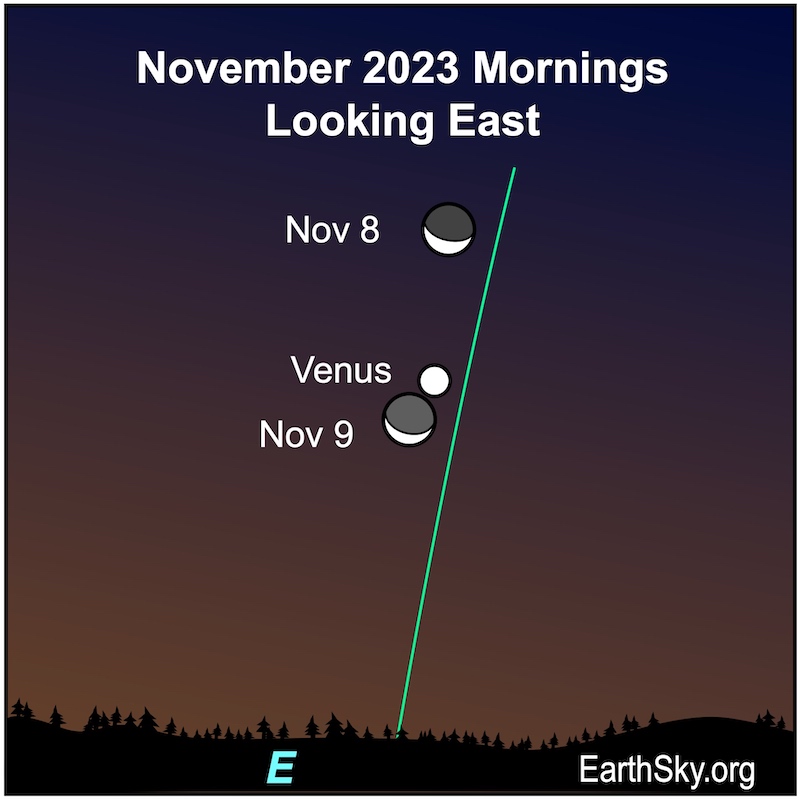
The 2024 lunar calendars are here! Best Christmas gifts in the universe! Check ’em out here.
EarthSky Minute for November 6 – 12
See highlights for the week in a one-minute video.
Second week of November: Taurid meteor showers
The South and North Taurid meteor showers ramble along from late October through early November, but they will both peak around the second week of November. Their meteors tend to be slow, and some of them are fireballs.
November 10 and 11 mornings: Moon near Venus and Spica
On the mornings of November 10 and 11, 2023, the thin waning crescent moon will be ascending toward the horizon in the eastern morning twilight before sunrise. Brilliant Venus and the bright star Spica will be nearby. On both mornings, the unlit portion of the moon will exhibit the lovely glow of earthshine, which is reflected light from Earth.
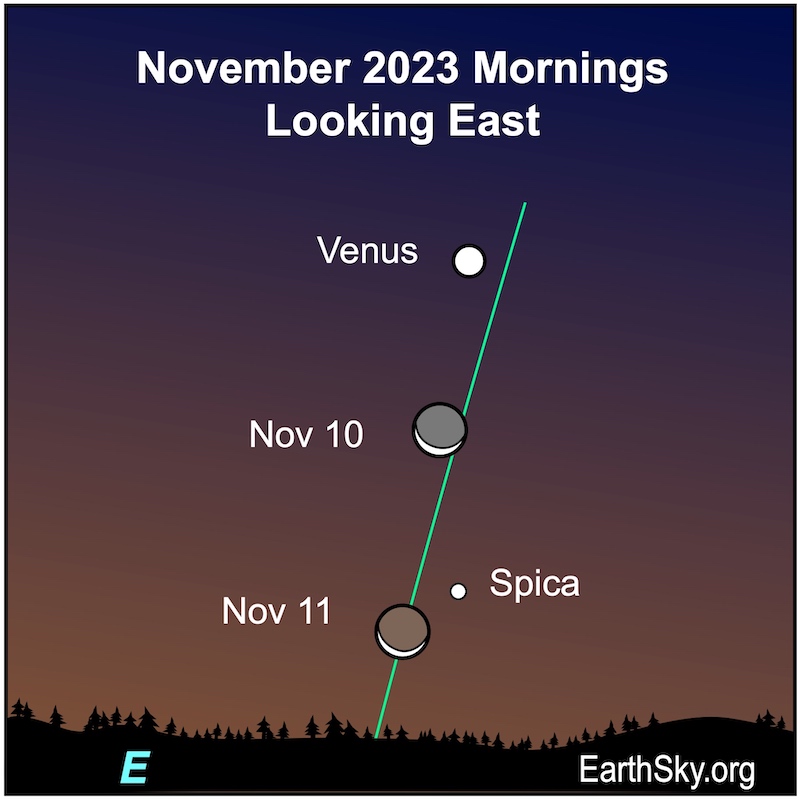
November 13: Uranus reaches opposition
Our planet Earth will swing between the sun and Uranus on November 13, 2023, placing us squarely in the middle of the best time of year to see this outer planet. Why? Because in November 2023, Uranus is opposite the sun in our sky. It will rise in the east as the sun sets in the west.
November 13: New moon
The instant of new moon will fall at 9:27 UTC (3:27 a.m. CST) on November 13, 2023. It’s a perfect time for stargazing under dark skies.
November 14 and 15 evenings: Moon near Mercury
On the evenings of November 14 and 15, 2023, the thin waxing crescent moon will emerge in the evening sky and will float low in the sunset direction in the midst of bright twilight. Look shortly after sunset. Binoculars will help spot tiny Mercury close to the moon on November 14. Mercury will have its greatest evening elongation on December 4, 2023.
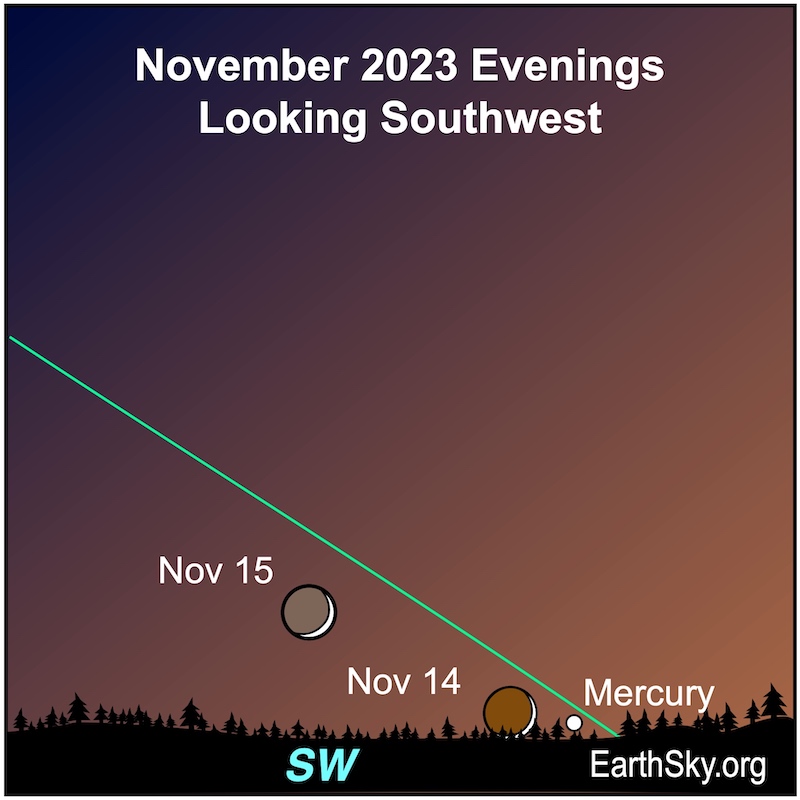
November 16, 17 and 18 evenings: Moon near Teapot
The thickening waxing crescent moon will pass the Teapot – an asterism – of Sagittarius the Archer on the evenings of November 16, 17 and 18, 2023. On the first evening, the moon will float in front of the Teapot. Also, look for the delicate glow of earthshine on the unlit portion of the moon, that is reflected light from Earth.
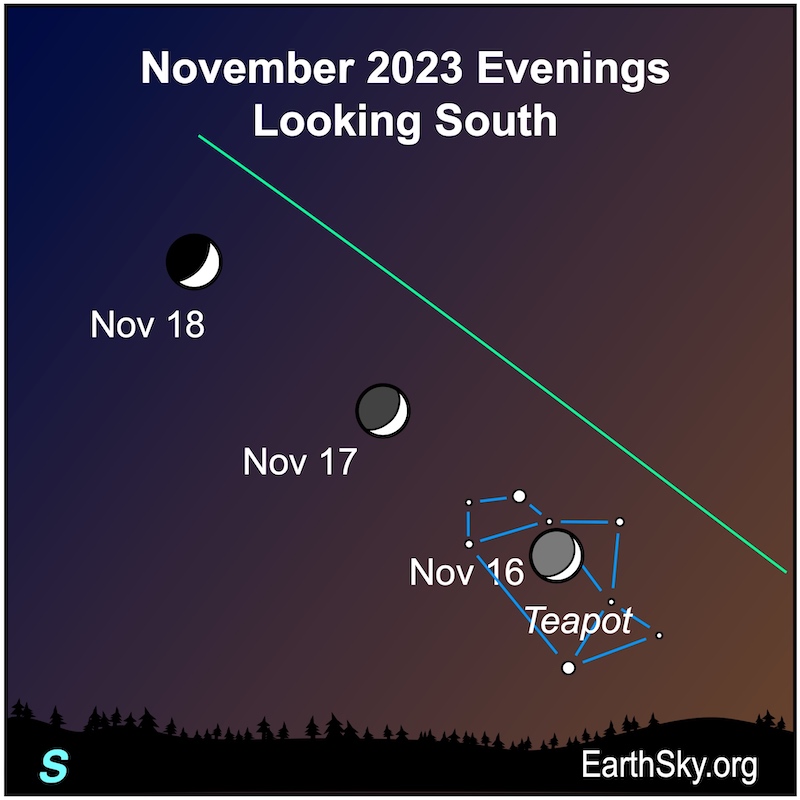
November 17-18 overnight: Leonid meteor shower
The predicted peak of the Orionid meteor shower is late on the night of November 17 until dawn on November 18. The morning of November 17 might be worthwhile to watch for meteors, too.
November 18: Mars in conjunction with the sun
Mars will reach solar conjunction and will be behind the sun on November 18, 2023. Therefore, it can’t be seen. Mars lies 234 million miles (377 million kilometers) from Earth.
November 19 and 20 evenings: Moon near Saturn
The waxing crescent moon will pass the steady light of golden Saturn on the evening of November 19, 2023. And on the evening of November 20, the 1st quarter moon will float near Saturn. You’ll be able to watch Saturn and the moon until around midnight.
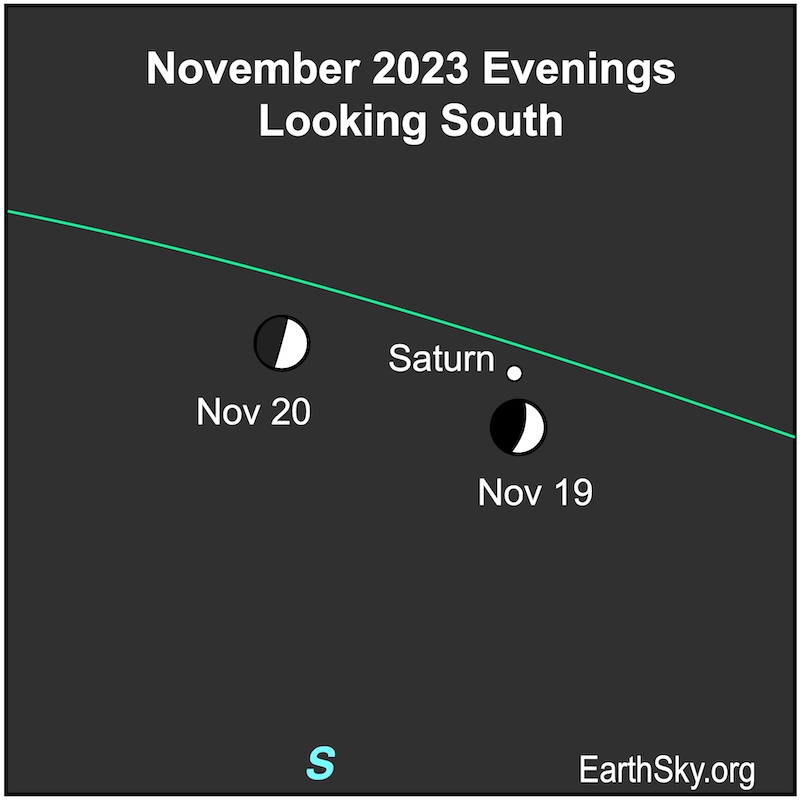
November 20 evening: 1st quarter moon
The instant of 1st quarter moon will fall at 10:50 UTC (4:50 a.m. CST), on November 20, 2023.
November 21: Moon reaches perigee
The moon will reach perigee – its closest point in its elliptical orbit around Earth – at 21 UTC (3 p.m. CST) on November 21, 2023, when it’s 229,794 miles (369,818 km) away.
November 21 and 22 evenings: Moon near the Circlet
The bright waxing gibbous moon will pass the faint but fascinating “Circlet” asterism in Pisces the Fish on the evenings of November 21 and 22, 2023. The moon and the Circlet will be visible as darkness falls and will set around midnight.
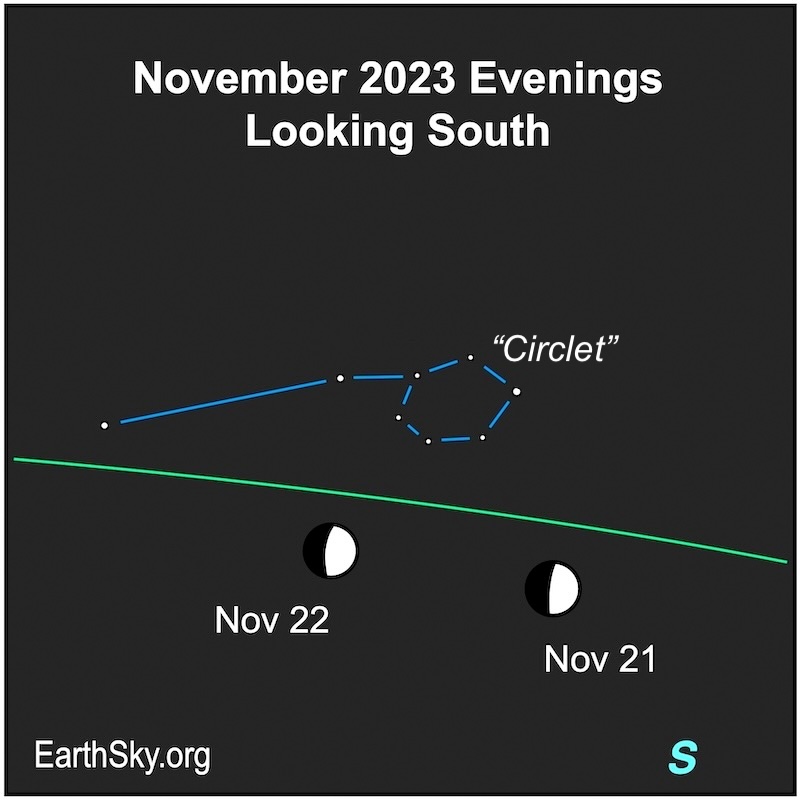
November 23 and 24 evenings: Moon near Jupiter
In the late evenings of November 23 and 24, 2023, the waxing gibbous moon will glow near the bright planet Jupiter. The moon and Jupiter will set several hours after midnight.
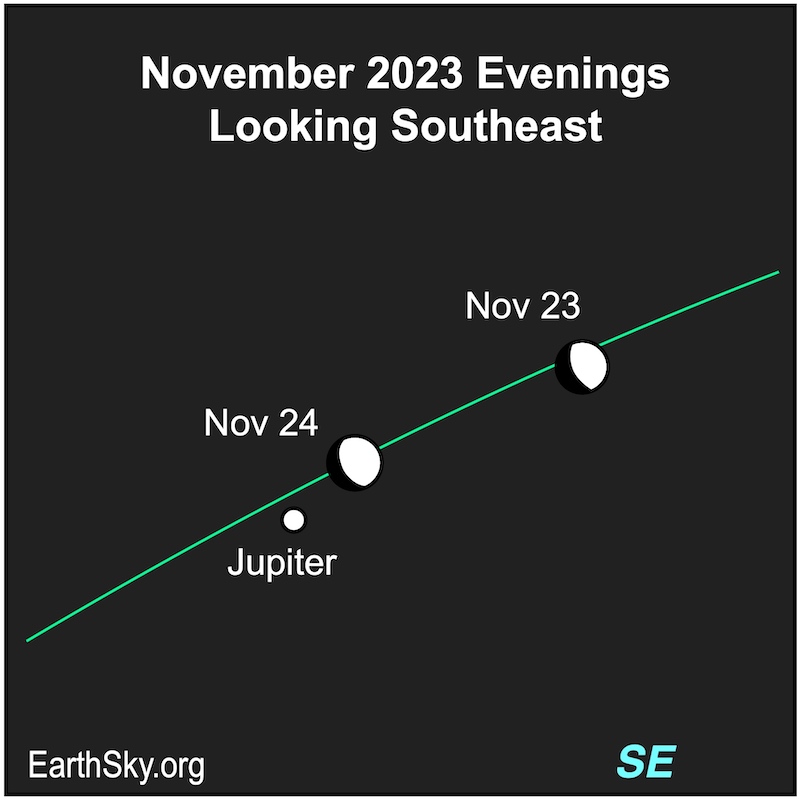
November 25 and 26 evenings: Moon near Jupiter and the Pleiades
After having visited Jupiter the night before, the bright waxing gibbous moon will pass between Jupiter and the Pleiades star cluster on the evenings of November 25 and 26, 2023. The Pleiades is also known as the Seven Sisters or Messier 45 and appears as a glittering, bluish cluster of stars in the constellation of Taurus the Bull. The pair will be especially close on the evening of November 25, when the moon will pass about 1 degree – or 2 full moon widths – from the Pleiades. It’ll be a great photo op for astrophotographers. The moon and Pleiades will cross the sky together until around sunrise.
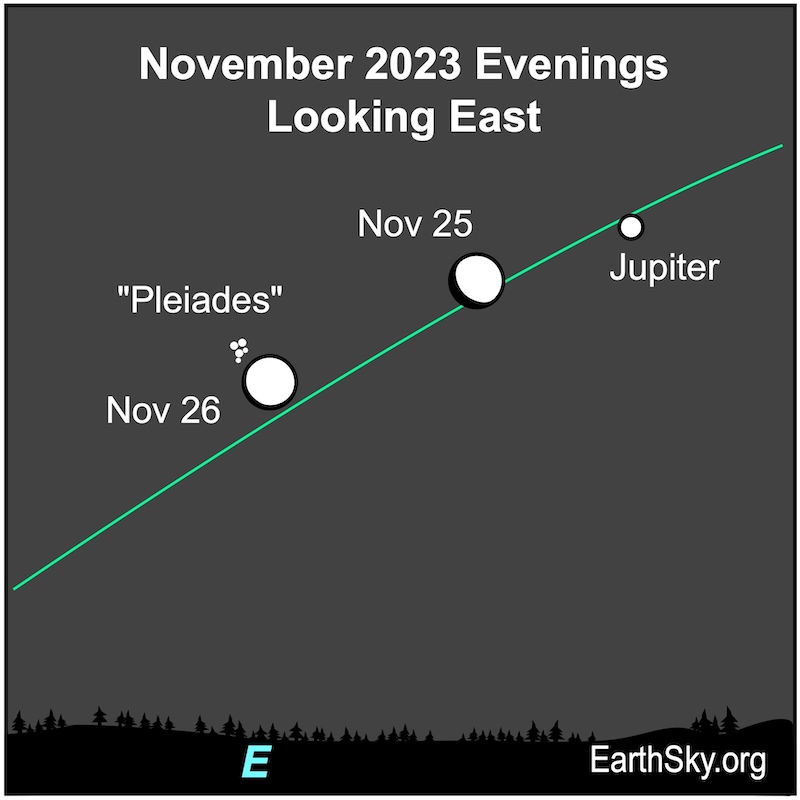
November 27, all night: Full Moon
The instant of full moon falls at 9:16 UTC (3:16 a.m. CST) on November 27, 2023.
November 27 and 28 all night: Moon near Capella, Aldebaran and Betelgeuse
November 27 and 28, 2023, the bright waning gibbous moon will lie near a trio of bright stars. It’ll be near the fiery orange star Aldebaran of Taurus the Bull and Orion’s mighty red supergiant star Betelgeuse. The bright golden star is Capella of the constellation Auriga the Charioteer. You can follow them until sunrise.
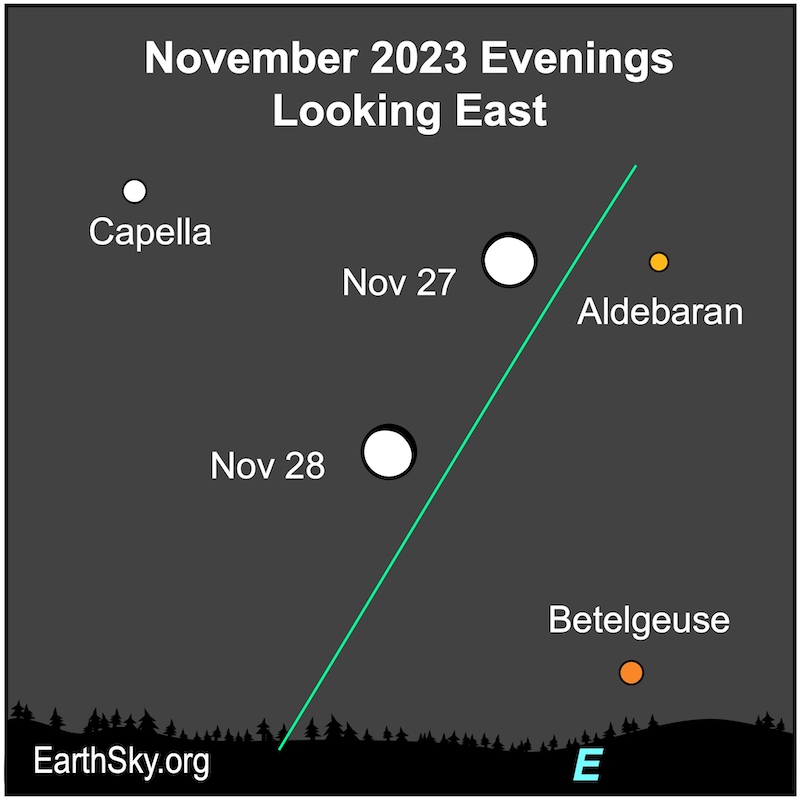
November 29 and 30 evenings: Moon near Castor and Pollux
On the evenings of November 29 and 30, 2023, the waning gibbous moon will pass Castor and Pollux, the twin stars of Gemini. They’ll rise a few hours after sunset and be visible traveling across the sky all night.
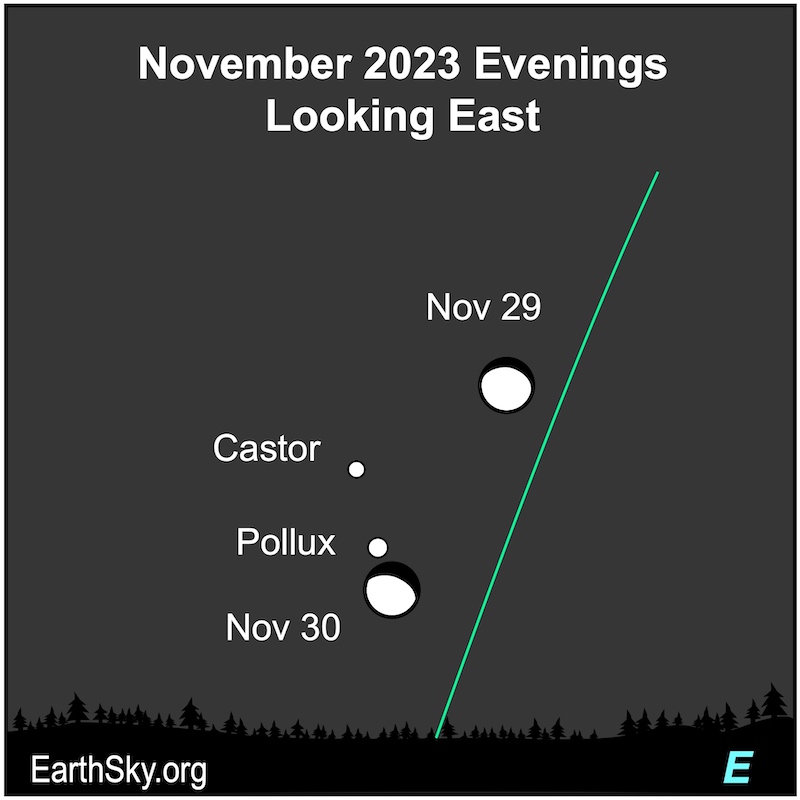
November 30 morning: Venus and Spica conjunction
On the final morning of the month, November 30, 2023, Venus will reach its closest approach – or will have a close conjunction – to the star Spica. Spica is the brightest star in Virgo the Maiden. They’ll be a little over 4 degrees apart on the sky’s dome, or roughly the width of 8 full moons lined up side-by-side.
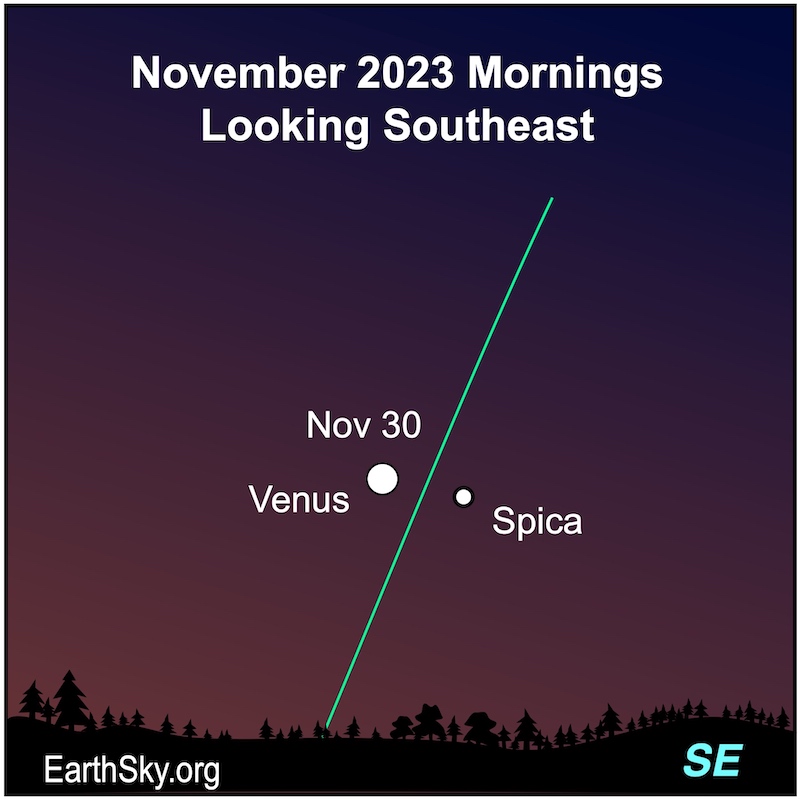
Planets in November 2023
November mornings: Venus
Brilliant Venus will continue to dominate the morning sky, but it will sink lower each morning after it reached its greatest elongation from the sun on October 23, 2023. Luckily, it will rise early enough to see it in dark skies. Venus will begin the month at -4.4 magnitude. A lovely waning crescent moon will join Venus and on the morning of November 9, 2023, when they appear about 1 degrees apart. In fact, a daytime lunar occultation is visible from north Canada, most of Greenland, Iceland, Svalbard, west Russia, most of Europe, parts of north Africa, and most of the Middle East. Also, it will appear closer to the star Spica each morning. Venus begins the month in the constellation of Leo and Lion and will move into Virgo the Maiden by mid-month.
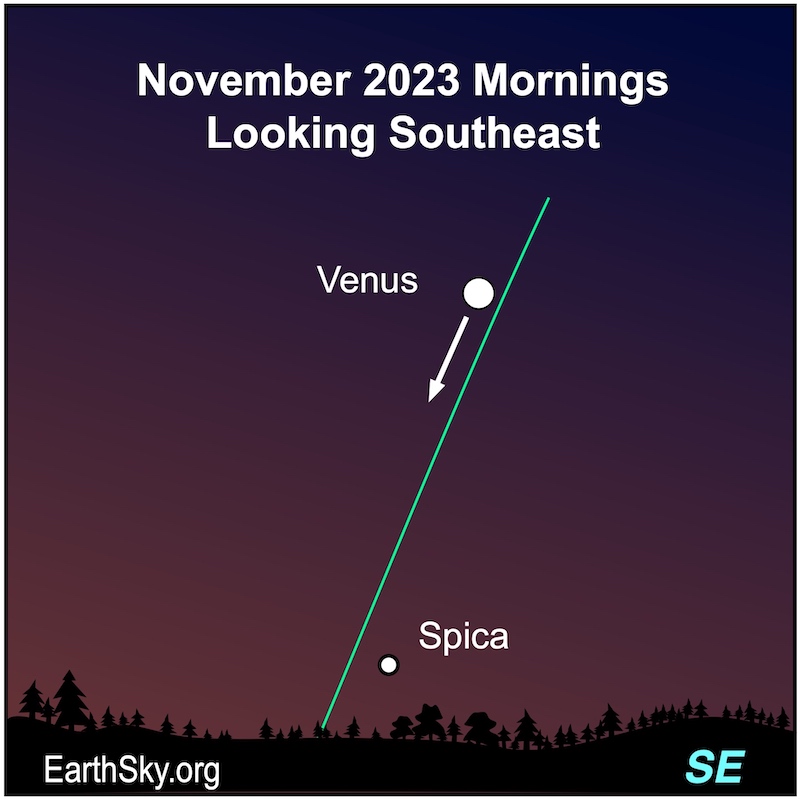
November evenings, all night: Jupiter
Jupiter will rise in the east at sunset and will be visible until dawn. It will shine near the pretty Pleiades star cluster in the constellation of Taurus the Bull. On November 1-2, 2023, it’ll reach perihelion – or closest point to the Earth – when the distance between the Earth and Jupiter will be 370 million miles (595 million kilometers). And the distance between the sun and Jupiter will be 462 million miles (744 million kilometers). Then, it will reach opposition overnight on November 2-3, 2023, when we fly between it and the sun. Jupiter lies in the dim constellation of Aries the Ram. It shines at -2.9 magnitude in November. The waxing gibbous moon will float by Jupiter on November 25, 2023.
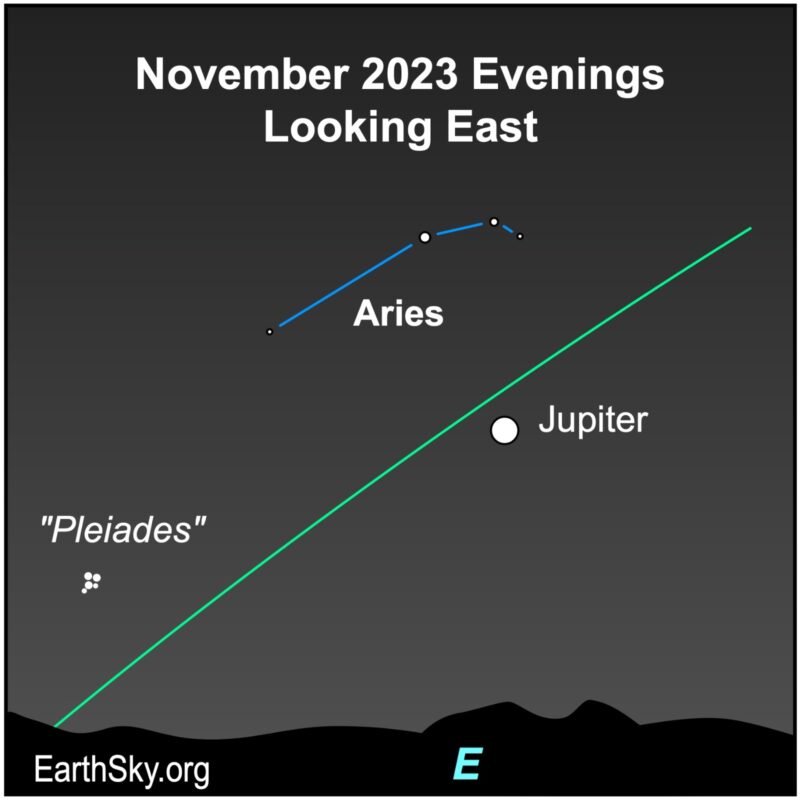
November evenings: Saturn
Golden Saturn will shine in the south after sunset during November. It will be near the dim Water Jar asterism of the constellation of Aquarius the Water Bearer. Our solar system’s beautiful ringed planet will be well placed for observation this month and will shine at 0.7 magnitude for most of the month. The waxing gibbous moon will visit Saturn on the evenings of November 20, 2023. Saturn will set after midnight at the beginning of the month and before midnight at month’s end.
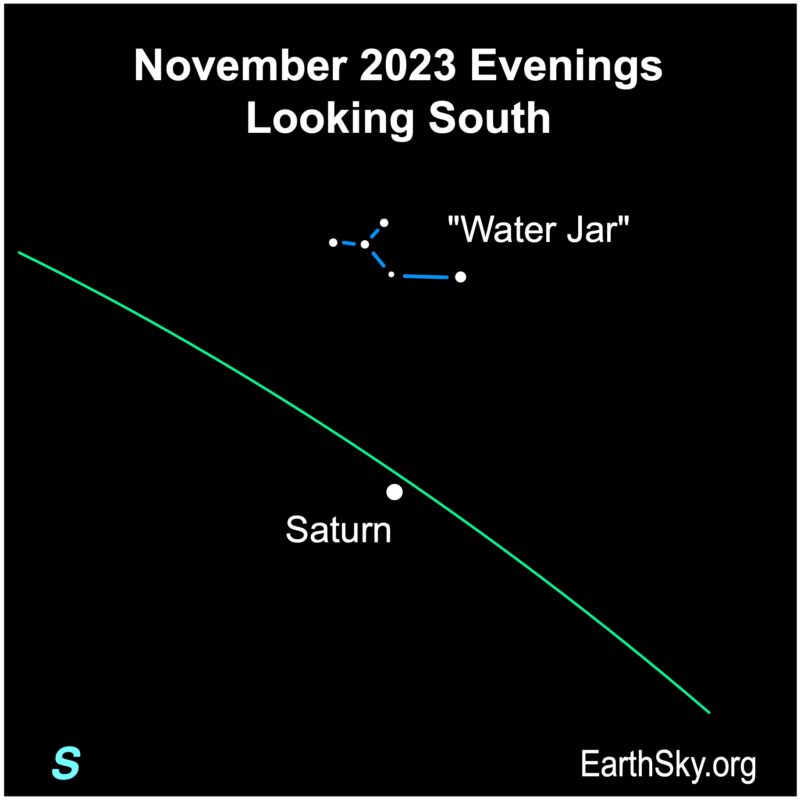
Late November evenings: Mercury
For viewers in the Northern Hemisphere, Mercury lies just above the horizon in the bright twilight shortly after sunset in the second half of November. It’ll reach its greatest evening elongation on December 4, 2023. At best, Mercury reaches 20 degrees from the sun in late November, so it will be challenging to find in bright twilight from the Northern Hemisphere. The Southern Hemisphere will have a better view, but it’s still not its best apparition for the year.
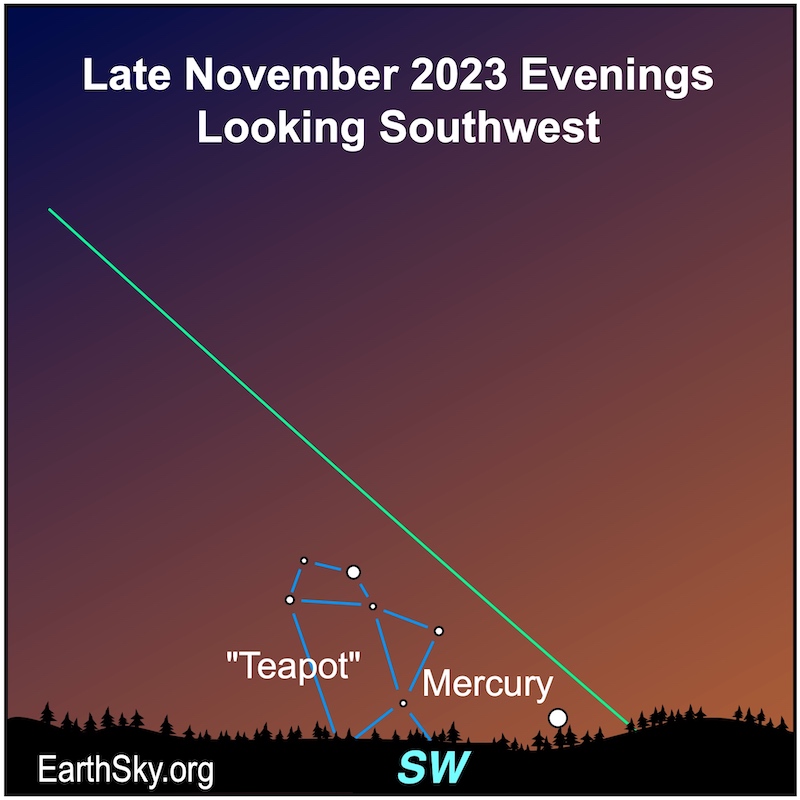
Where’s Mars?
It’s too close to the sun to be visible for the rest of 2023. It’ll be back next year.
Thank you to all who submit images to EarthSky Community Photos! View community photos here. We love you all. Submit your photo here.
Looking for a dark sky? Check out EarthSky’s Best Places to Stargaze.
Sky dome maps for visible planets and night sky
The sky dome maps come from master astronomy chart-maker Guy Ottewell. You’ll find charts like these for every month of 2023 in his Astronomical Calendar.
Guy Ottewell explains sky dome maps
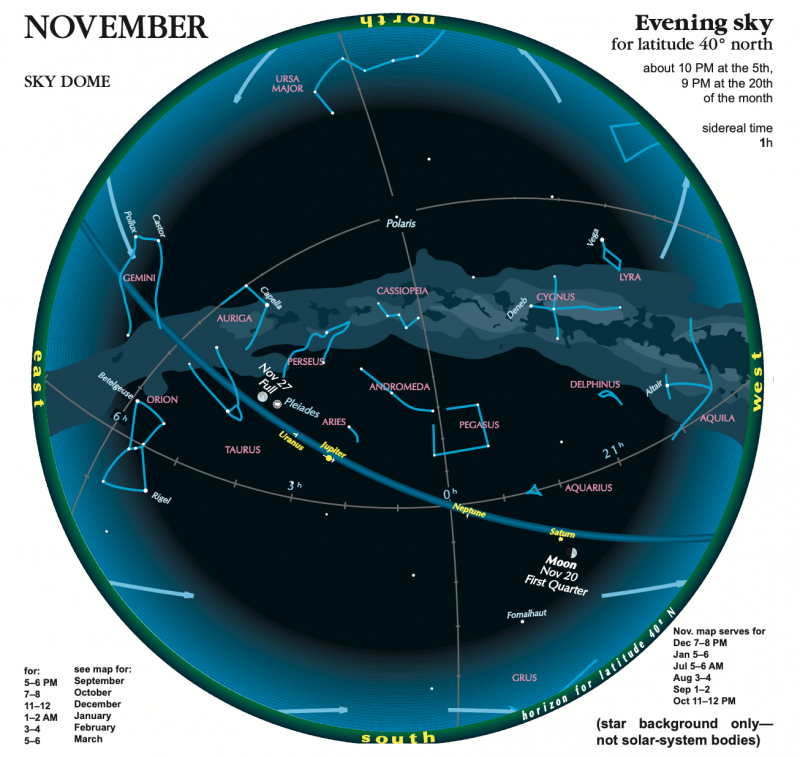
Heliocentric solar system planets
The sun-centered charts come from Guy Ottewell. You’ll find charts like these for every month of 2023 in his Astronomical Calendar.
Guy Ottewell explains heliocentric charts.
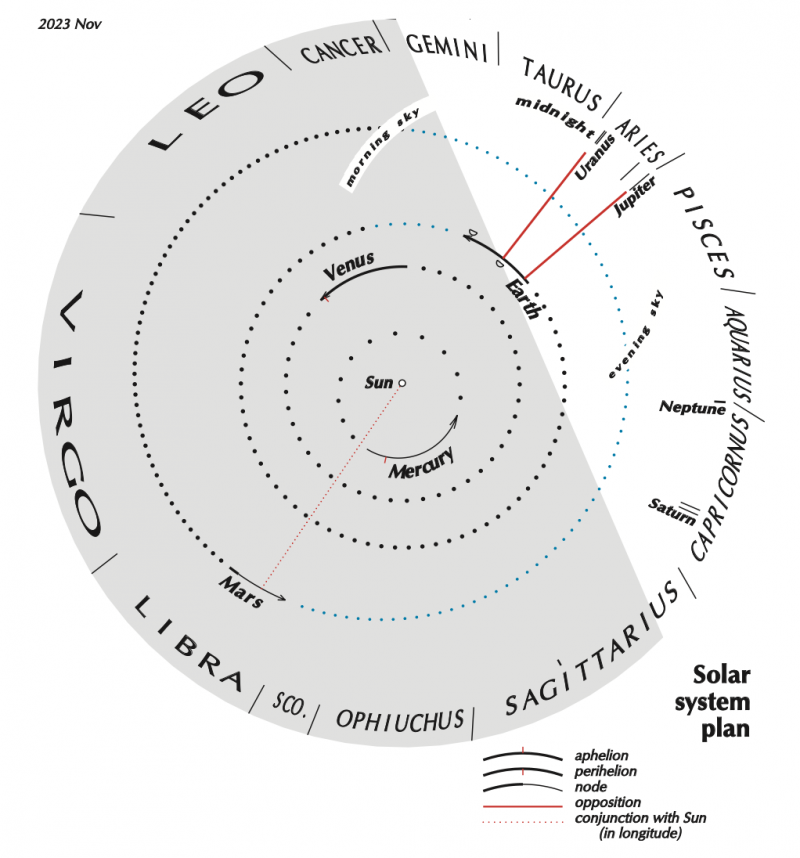
REMINDER: DAYLIGHT SAVING TIME ENDS
When does Daylight Saving Time end? Answer: We “fall back” to Standard time on Sunday morning, November 6, at 2 AM PDT.
Wild Turkeys: Band On The Run
If you’re like most drivers in northern California, you’ve hit the brake to avoid bands of Wild Turkeys crossing the street. Why are they so common? Like many non-natives in northern California, Wild Turkey populations have an easy time in suburban and semi-rural areas where successful predation by Gray Fox, Bobcat, and Mountain Lion remains below this gallinaceous bird’s prodigious breeding rate that usually consists of 10-12 eggs per brood (and multiple broods for some females each breeding season).
In addition, Wild Turkey benefit from joining together in bands of six or more this time of year so that at least one individual is likely to sense any imminent predation attempt and, subsequently, alert other turkeys in a group that quickly flees from harm’s way. Plentiful harvests of acorns are another major factor in supporting large Wild Turkey populations, with native oak species (including Coast Live Oak, Quercus agrifolia) providing ample supplies of these birds’ favorite food. In years when the crop of acorns is low from Coast Live Oak, other native oak species (Black Oak, Quercus kelloggii and Blue Oak, Quercus douglasi) may make up the difference by yielding high acorn numbers. A final reason relates to how mild winter temperatures in our area limit mortality of populations whose odds of perishing increase in more frigid locales within this bird’s range that includes portions of New England and the upper Midwest.
Autumn Chores: Western Gray Tree Squirrel
What are western gray tree squirrels doing now? Many are preparing for winter when they’ll make brood nests in tree and snag cavities, often enlarging an abandoned woodpecker cavity. They are also known to construct nests on branches of oak, fir, or pine trees. If you see a nest, look for it to contain shredded bark, grass, moss, and lichen.
Aquatic Insects Are (Almost) Everywhere
Seeing an abundance of aquatic insects might seem odd at this time of year when the days are getting progressively colder, correct? Not entirely. Many kinds of aquatic insects are actually abundant in many freshwater streams throughout the late autumn and into winter, with some (such as stoneflies) even changing into terrestrial adults and flying into autumn and winter’s landscape. Finding aquatic insects may be easier than you think. Pick up small rocks within shallow creeks and look on their backsides. You may see the diverse homes of caddisfly larva, with a variety materials used by each species in a shelter bound together from a caddisfly’s own secretions.
A Chorus of Crickets?
Are you still hearing crickets? — even though the first frost may have invaded your area. Crickets survive well into autumn because their body fluids contain an “anti-freeze” agent called glycogen. Its composition as an animal starch includes glucose molecules that retard the inevitable freezing of a cricket’s body fluids until more severe and consecutive nights of frigid weather arrive.
Snakes In Winter
Where do snakes hang out now and during the winter? Many retreat to underground dens where they coil en masse together to remain warm. In northern areas, rattlesnakes are particularly known for congregating into large groups (of up to 250 or more). Most live in dens on slopes protected from northern winds that have orientations toward the low winter sun in the south. Sometimes you can see rattlesnakes lie near their den entrances on the last warm days of autumn or on the initial warm days of spring.
Coaxing Deer Into Your View
Coax deer into view throughout the upcoming winter by placing a salt lick block at the edge of woods. However, you may wish to deter deer from eating your property’s plants with a variety of strategies that are too numerous to mention here (See literature distributed free by Sloat Garden Store in the Bay Area.) To limit deer accidents with windows/patio doors, prudent property owners place decals at a deer’s eye level so it will recognize an approaching barrier.
Winter Resident Wood-Warblers
Some brave warblers survive hang out throughout the winter in regions you might not expect. Unlike warblers that have vacated North America for points farther south, Yellow-Rumped Warbler (four subspecies constitute the entire species, including Aububon’s, Myrtle, Guatemalan Goldman’s, and Northwest Mexican Black-fronted*) are able to survive inclement winter weather while living in mid-Atlantic states (Myrtle subspecies) because they are able to digest wax myrtle, juniper and, even, poison ivy berries. These same areas may also host small populations of Pine and Palm warblers throughout the winter in the mid-Atlantic, in addition to occasional yellow-breasted chats and common yellowthroat warblers.
On the West Coast during winter, both Audubon and Myrtle Yellow-Rumped Warbler subspecies may be seen in northern California, with the former more common. In total, we see two of the four subspecies for the Yellow-Rumped Warbler species.
(* = http://www.aou.org/committees/nacc/proposals/pending.php
The above link allows you to access current and past AOS proposals related to potential bird taxonomy changes.
December, 2023
Sky Watch: (courtesy of almanac.com)
1) Moon & Planet Rise & Set Times
……..For your location’s moon & planet rise & set times, see: https://www.timeanddate.com/astronomy/night/usa/tehachapi
or type in at:
https://www.timeanddate.com/astronomy/night/
Then type in your city and/or zip code location to review the results for your rising times.
For example, my location’s information for the 1st of this month (at Latitude: 38:03:38 N, Longitude: 122:32:27 W, which is Novato, CA, 94949 20 miles north of San Francisco, CA in Marin County):
| Planetrise/Planetset, Thu, Dec 1, 2023 | ||||
|---|---|---|---|---|
| Planet | Rise | Set | Meridian | Comment |
| Mercury | Wed 8:13 am | Wed 5:28 pm | Wed 12:51 pm | Difficult to see |
| Venus | Wed 7:55 am | Wed 5:25 pm | Wed 12:40 pm | Slightly difficult to see |
| Mars | Wed 5:12 pm | Thu 8:07 am | Thu 12:39 am | Perfect visibility |
| Jupiter | Wed 1:32 pm | Thu 1:25 am | Wed 7:28 pm | Perfect visibility |
| Saturn | Wed 11:51 am | Wed 10:11 pm | Wed 5:01 pm | Average visibility |
| Uranus | Wed 3:29 pm | Thu 5:19 am | Wed 10:24 pm | Average visibility |
| Neptune | Wed 1:16 pm | Thu 12:54 am | Wed 7:05 pm | Difficult to see |
2) Visible planets in December 2022 (courtesy of EarthSky.org)
Visible planets and night sky for December
December 10 and 11 mornings: Moon near Venus and Zubenelgenubi
The thin waning crescent moon will move away from dazzling Venus and will pass the moderately bright star Zubenelgenubi in Libra the Scales on the morning of December 10. An even thinner crescent moon will hang near the horizon shortly before sunrise on the morning of December 11. Can you see a delicate glow on the unlit portion of the crescent moon? That’s earthshine! It’s reflected light from the Earth.
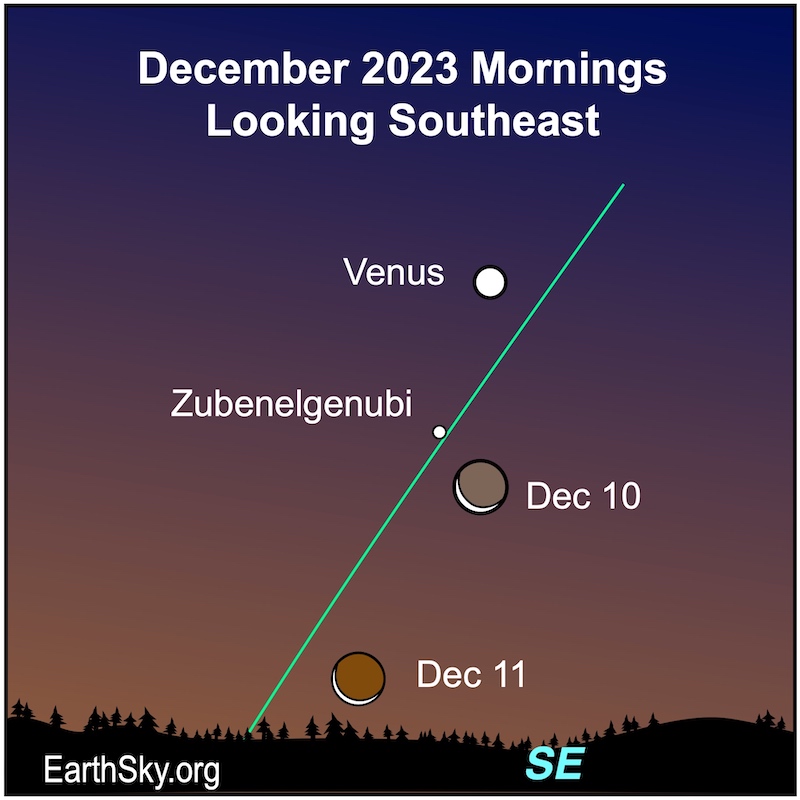
Our charts are mostly set for the northern half of Earth. To see a precise view – and time – from your location, try Stellarium Online.
December 12: New moon
The instant of new moon will fall at 23:32 UTC (5:32 p.m. CST) on December 12, 2023. It’s a perfect time for stargazing – especially watching for Geminid meteors – under dark skies. The new moon rises and sets with the sun.
December 13 and 14 all night: Geminid meteor shower
The predicted peak of the Geminid meteor shower is around the moon-free nights of December 13 and 14, 2023.
December 14 and 15 evenings: Moon near Mercury
On the evenings of December 14 and 15, 2023, the thin waxing crescent moon will float low in the sunset direction in the midst of bright twilight. Look shortly after sunset. Binoculars will help spot tiny Mercury close to the moon on December 14. Also, look for earthshine, a glow on the unlit side of the moon. It’s reflected light from the Earth. Mercury had its greatest evening elongation – when it was farthest from the sun in our evening sky – on December 4, 2023.
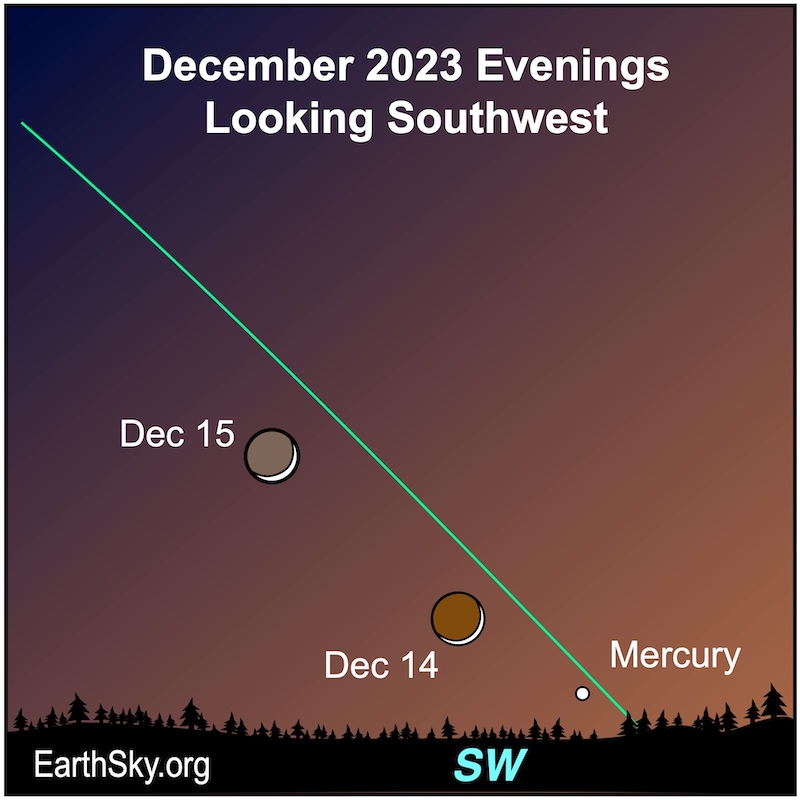
December 16: Moon reaches perigee
The moon will reach perigee – its closest point in its elliptical orbit around Earth – at 19 UTC (1 p.m. CST) on December 16, 2023, when it’s 228,603 miles (367,901 kilometers) away.
Our charts are mostly set for the northern half of Earth. To see a precise view – and time – from your location, try Stellarium Online.
December 16 and 17 evenings: Moon near Saturn
The waxing crescent moon will pass the steady light of golden Saturn on the evenings of December 16 and 17, 2023. You’ll be able to watch Saturn and the moon until a few hours before midnight.

December 17 morning: Venus will pair up with Zubenelgenubi
During the middle of December, brilliant Venus will slide by a moderately bright star with a name that’s fun to say: Zubenelgenubi. Zubenelgenubi means “Southern Claw” in Arabic. Many people used to consider this star as part of Scorpius the Scorpion. But today it’s part of Libra the Scales. Venus and Zubenelgenubi will be at their closest to each other on December 17.
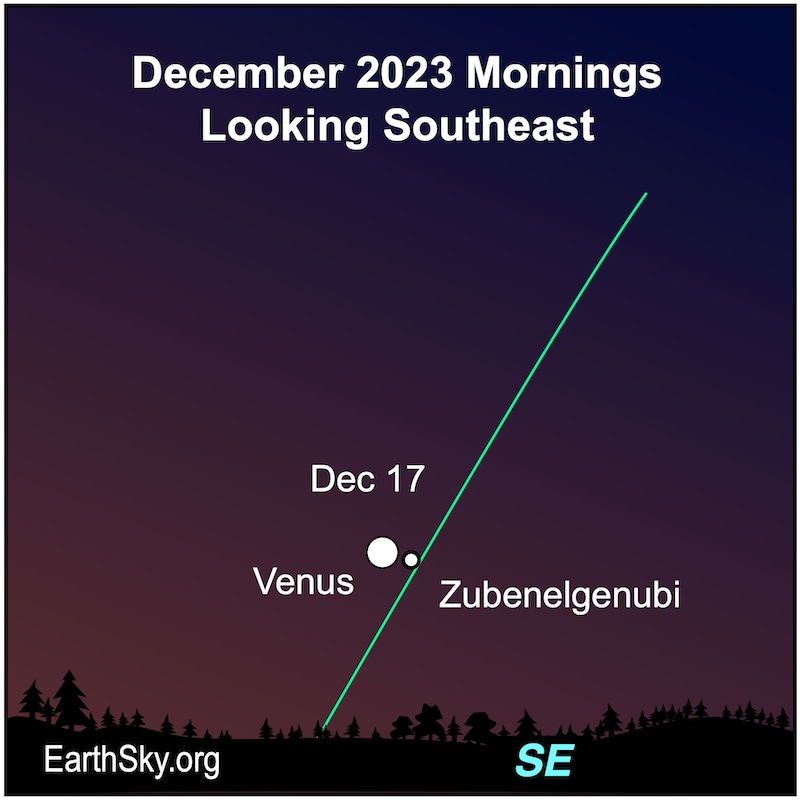
December 19: 1st quarter moon
The instant of 1st quarter moon will fall at 18:39 UTC (12:39 p.m. CST), on December 19, 2023. The 1st quarter moon rises around noon your local time and sets around midnight.
December 19 and 20 evenings: Moon near the Circlet
The bright waxing gibbous moon will pass the faint but distinct Circlet asterism in Pisces the Fish on the evenings of December 19 and 20, 2023. The moon and the Circlet will be visible as darkness falls and will set after midnight.

December 21 and 22 evenings: Moon near Jupiter
On the evenings of December 21 and 22, 2023, the waxing gibbous moon will glow near the bright planet Jupiter. The moon and Jupiter will set several hours after midnight.
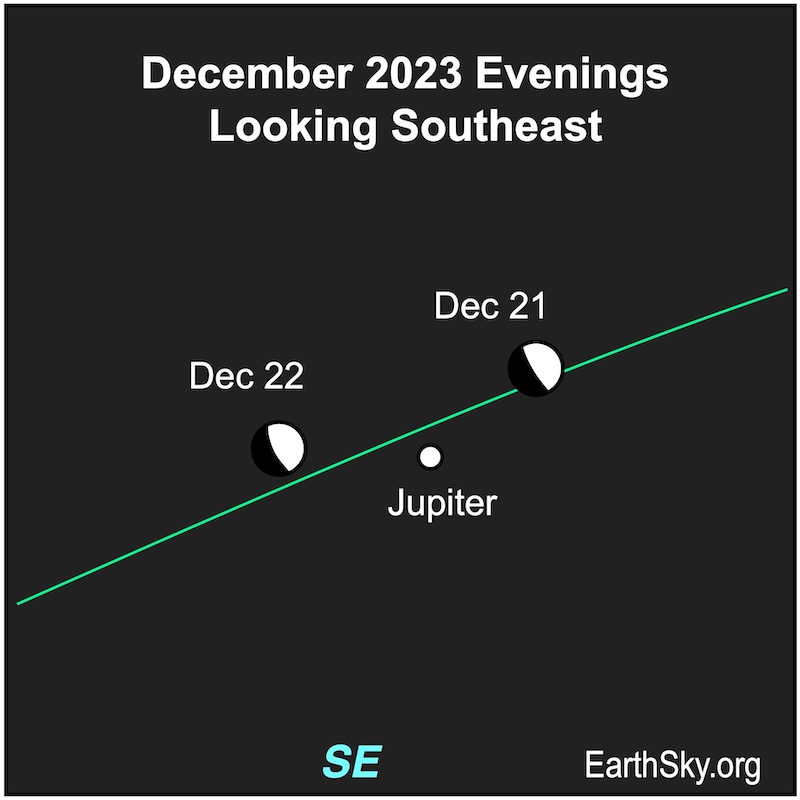
December solstice: December 21-22
The December solstice is at 3:27 UTC on December 22, 2023 (9:27 p.m. December 21 CST). Winter arrives in the Northern Hemisphere and summer arrives in the Southern Hemisphere.
December 22: Mercury will pass between Earth and the sun
Mercury will reach the point in its orbit known as inferior conjunction – when it passes between Earth and the sun – at 19 UTC on December 22.
Our charts are mostly set for the northern half of Earth. To see a precise view – and time – from your location, try Stellarium Online.
December 22-23 mornings: Ursid meteor shower
The predicted peak of the Ursid meteor shower is on the early mornings of December 22 and 23, 2023. The best time to watch is before dawn and after the waxing gibbous moon has slipped below the horizon.
December 23 and 24 evenings: Moon near the Pleiades
The bright waxing gibbous moon will pass the Pleiades star cluster on the evenings of December 23 and 24, 2023. The Pleiades is also known as the Seven Sisters or Messier 45 and appears as a glittering, bluish cluster of stars in the constellation Taurus the Bull. The moon and Pleiades will cross the sky together until about an hour before sunrise.
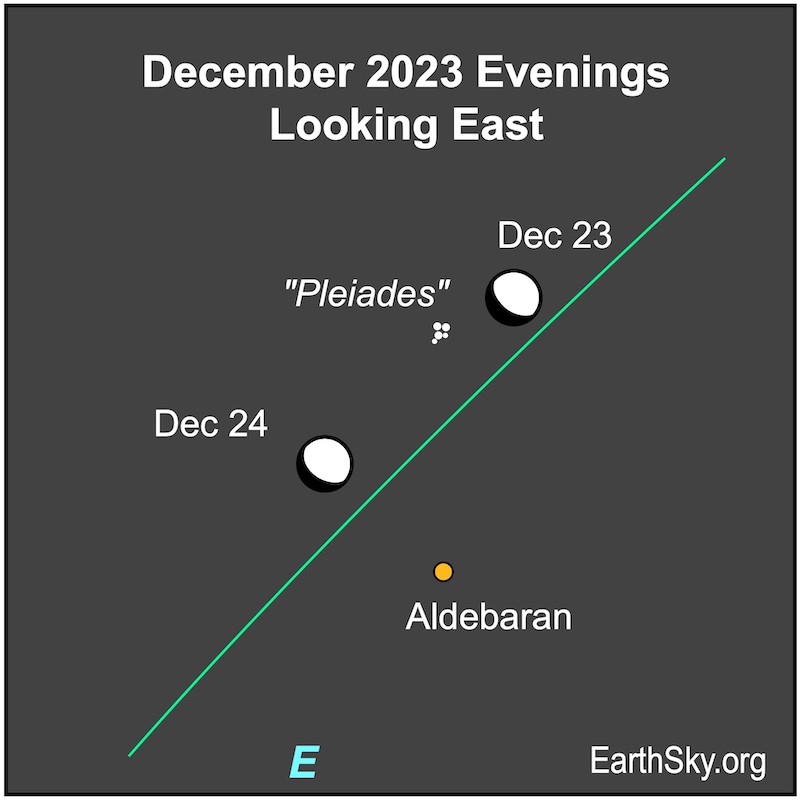
December 25 all night: Moon near Capella, Aldebaran and Betelgeuse
December 25, 2023, the bright waxing gibbous moon will lie near a trio of bright stars. It’ll be near the fiery orange star Aldebaran of Taurus the Bull and Orion’s mighty red supergiant star Betelgeuse. The bright golden star is Capella of the constellation Auriga the Charioteer. If you catch Capella low on the horizon, it may be flashing like a small disco ball. You can follow them all night until sunrise.

December 26-27, all night: Full Moon
The instant of full moon will fall at 0:33 UTC on December 27, 2023 (6:33 p.m. CST December 26).
Our charts are mostly set for the northern half of Earth. To see a precise view – and time – from your location, try Stellarium Online.
December 26 and 27 evenings: Moon near Castor and Pollux
On the evening of December 26, 2023, the full moon will pass Castor and Pollux, the twin stars of Gemini. Then on the evening of December 27, the waning gibbous moon will be closer to the Twin Stars of Gemini. They’ll rise a few hours after sunset and be visible traveling across the sky all night.
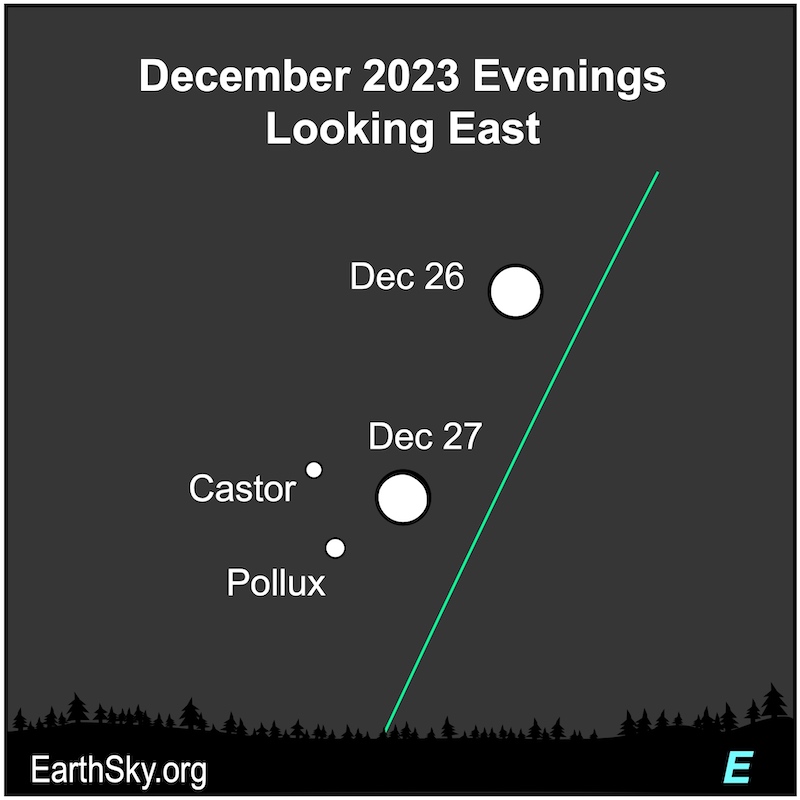
December 29 morning: Moon near the Beehive
For the second time this month, the moon will slide by the famous – but faint – Beehive star cluster. This time it will be a waning gibbous moon on the morning of December 29, 2023. You will need binoculars to spot the dozens of stars in the busy Beehive star cluster. Also nearby will be the twin stars, Castor and Pollux, in the constellation Gemini. They’ll rise late the night before and be high in the morning sky.
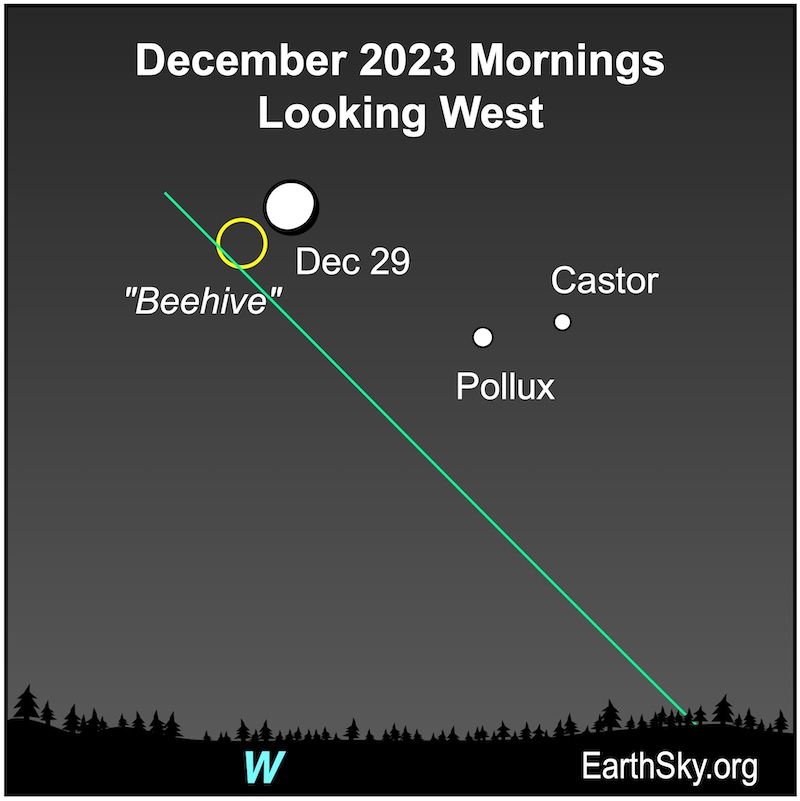
December 30 and 31 mornings: Moon near the Sickle
On the mornings of December 30 and 31, 2023, the waning gibbous moon will float near Regulus, marking the bottom of the backward question mark asterism called the Sickle. Regulus is the brightest star in Leo the Lion. And the moon will lie close to Regulus on the final morning of 2023. They’ll rise late in the evening the night before and be high in the morning sky.
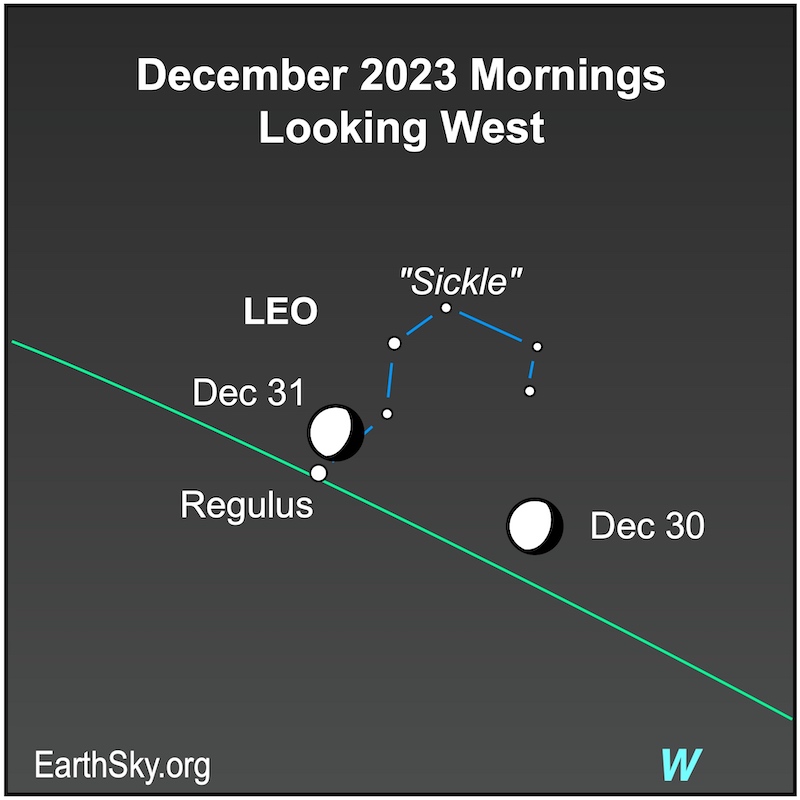
Our charts are mostly set for the northern half of Earth. To see a precise view – and time – from your location, try Stellarium Online.
Planets in December 2023
December mornings: Venus
The blazing light of Venus will continue to dominate the morning sky through the end of the year. However, it will be sinking lower each morning after it reached its greatest elongation from the sun in October. Luckily, it will rise early enough to see it in dark skies. Venus will begin the month at -4.2 magnitude and will dim slightly as it recedes from Earth, ending the month at -4.1 magnitude. A lovely waning crescent moon will join Venus on the morning of December 9, 2023, when they appear about 4 degrees apart. Also, Venus will appear close to the star Spica at the beginning of the month, and then they drift apart more each morning. Venus begins the month in the constellation Virgo the Maiden and will move into Libra the Scales by mid-month. Then by month’s end, it will be in the constellation Scorpius the Scorpion.
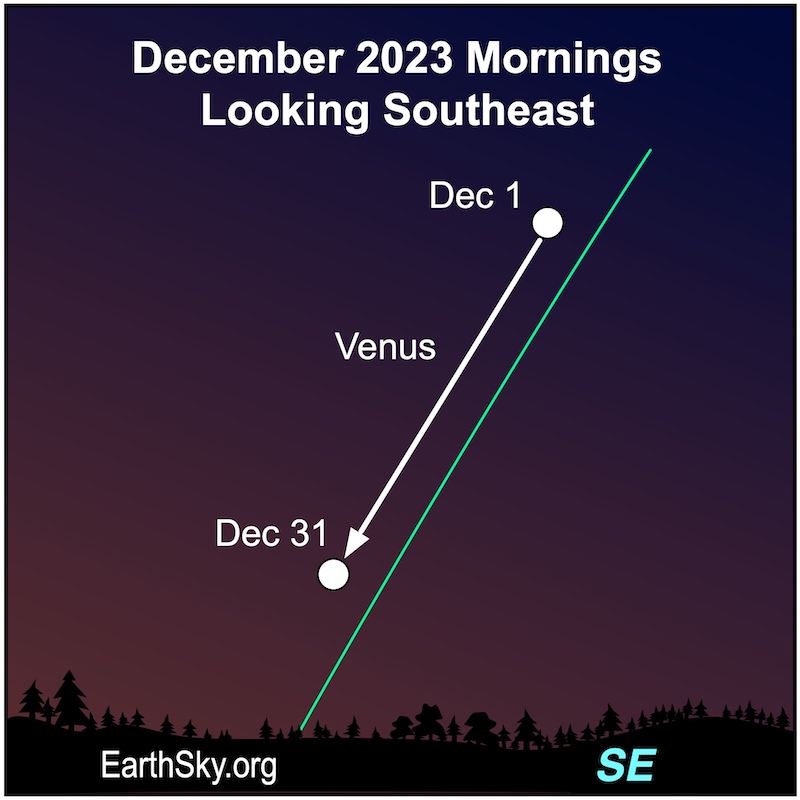
December most of the night: Jupiter
Bright Jupiter will draw your attention most of the night. It will be very obvious in the east at sunset and will be visible until a few hours before dawn. It will shine near the pretty Pleiades star cluster in the constellation Taurus the Bull. Jupiter reached its closest point to the Earth in early November. And it reached opposition overnight on November 2-3, 2023, when we flew between it and the sun. So, as Jupiter recedes from Earth, it’ll fade a bit in our sky. It will lie in the dim constellation Aries the Ram. It will shine at -2.7 magnitude by month’s end. The waxing gibbous moon will float by Jupiter on December 22, 2023.
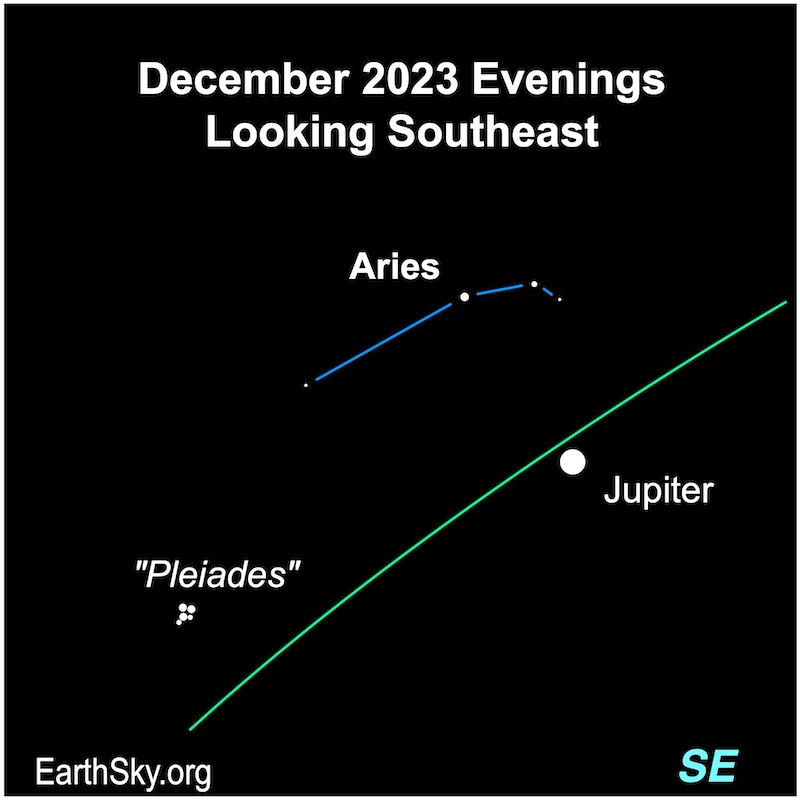
December evenings: Saturn
Golden Saturn will shine in the southwest after sunset during December. It will be in the dim constellation Aquarius the Water Bearer. Our solar system’s beautiful ringed planet will be fading a bit this month as it recedes from Earth and will shine at +0.9 magnitude for most of the month. Saturn will be a little brighter than the nearby lonely star, Fomalhaut, which shines around 1st magnitude. The waxing gibbous moon will visit Saturn on the evenings of December 17, 2023. Saturn will set by mid-evening your local time this month.
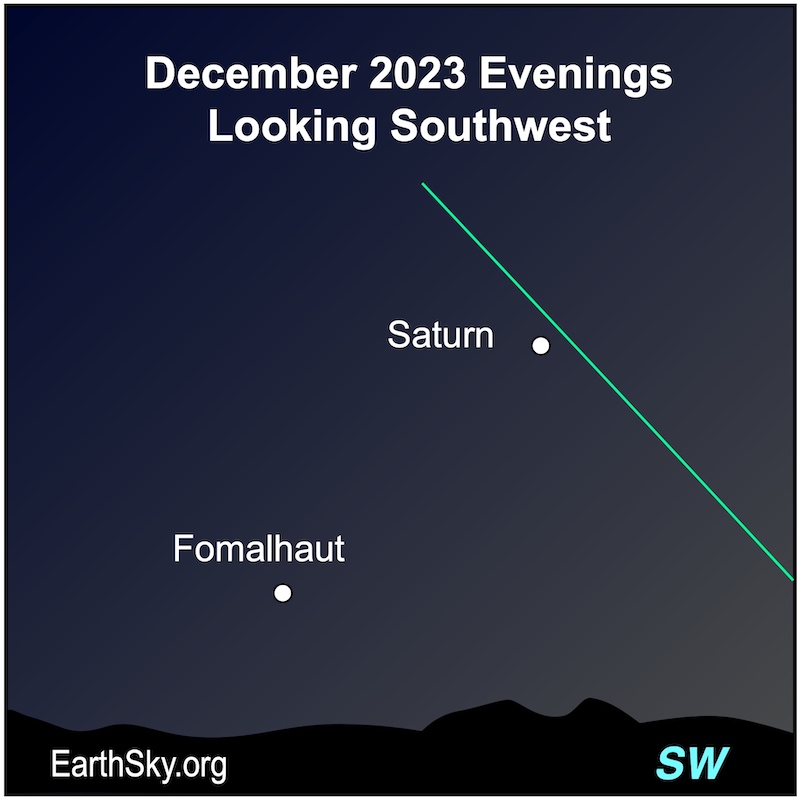
December evenings: Mercury
For viewers in the Northern Hemisphere, Mercury lies just above the horizon in the bright twilight shortly after sunset in the first part of December. It’ll reach its greatest evening elongation – farthest from the sun in our evening sky – on December 4, 2023. At best, Mercury reaches 21 degrees from the sun on that day, so it will be challenging to find in bright twilight from the Northern Hemisphere. The Southern Hemisphere will have a better view. It’ll also be emerging low in the morning sky the last few days of the year on its way to its first greatest morning elongation of 2024.
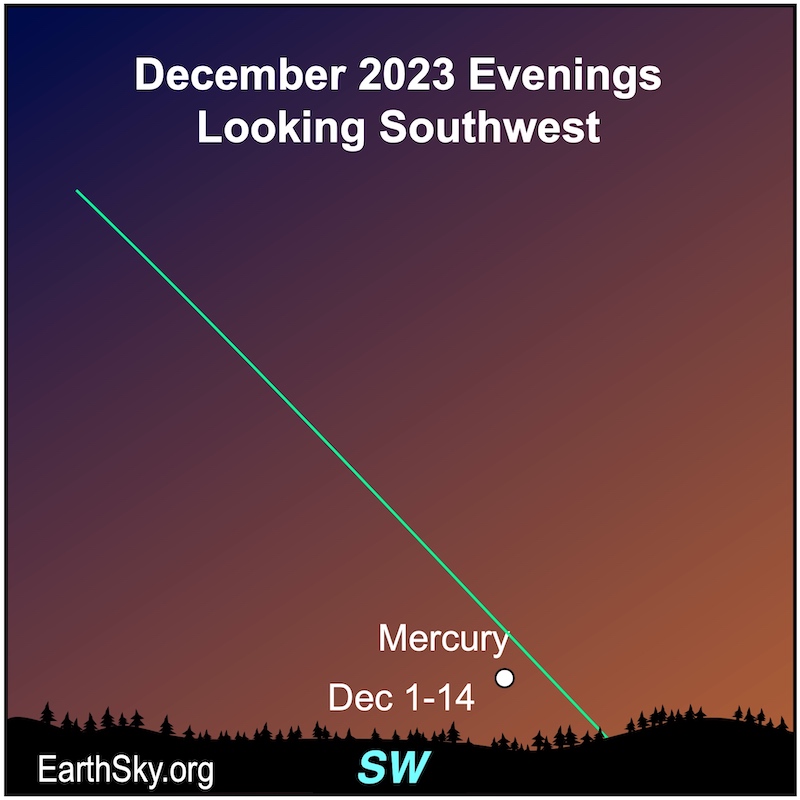
Where’s Mars?
It’s too close to the sun in the morning sky to be visible for the rest of 2023. It’ll be back next year.
Thank you to all who submit images to EarthSky Community Photos! View community photos here. We love you all. Submit your photo here.
Looking for a dark sky? Check out EarthSky’s Best Places to Stargaze.
Sky dome maps for visible planets and night sky
The sky dome maps come from master astronomy chart-maker Guy Ottewell. You’ll find charts like these for every month of 2023 in his Astronomical Calendar.
Guy Ottewell explains sky dome maps

Heliocentric solar system planets
The sun-centered charts come from Guy Ottewell. You’ll find charts like these for every month of 2023 in his Astronomical Calendar.
Guy Ottewell explains heliocentric charts.
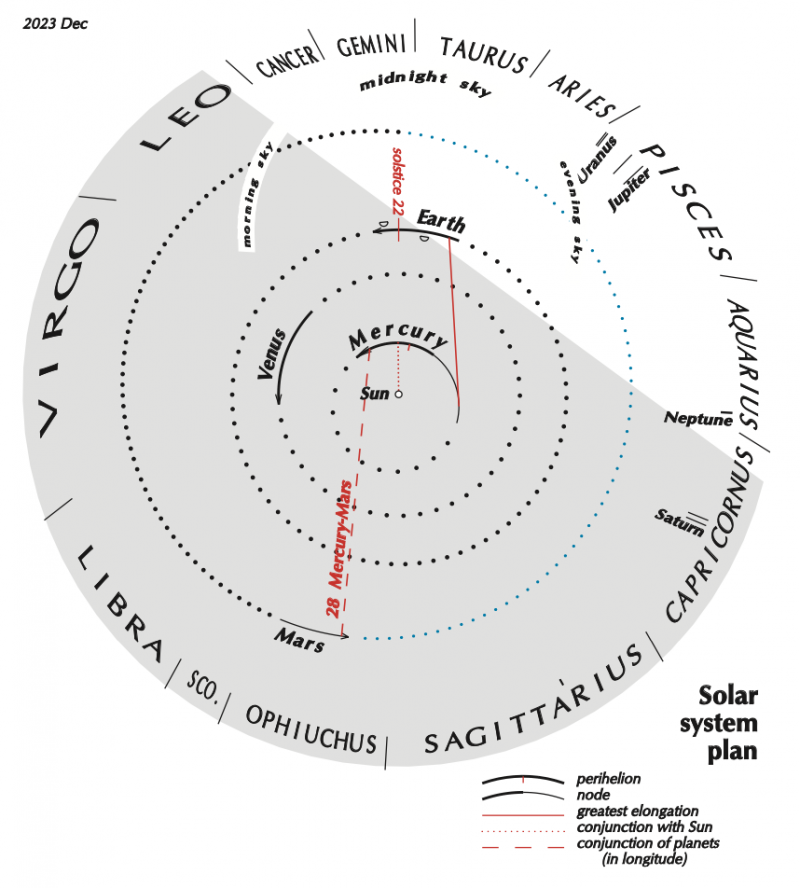
Some resources to enjoy:
For more videos of great night sky events, visit EarthSky’s YouTube page.
Watch EarthSky’s video about Two Great Solar Eclipses Coming Up
Don’t miss anything. Subscribe to daily emails from EarthSky. It’s free!
Visit EarthSky’s Best Places to Stargaze to find a dark-sky location near you.
Post your own night sky photos at EarthSky Community Photos.
Translate Universal Time (UTC) to your time.
See the indispensable Observer’s Handbook, from the Royal Astronomical Society of Canada.
Visit Stellarium-Web.org for precise views from your location.
Almanac: Bright Planets (rise and set times for your location).
Visit TheSkyLive for precise views from your location.
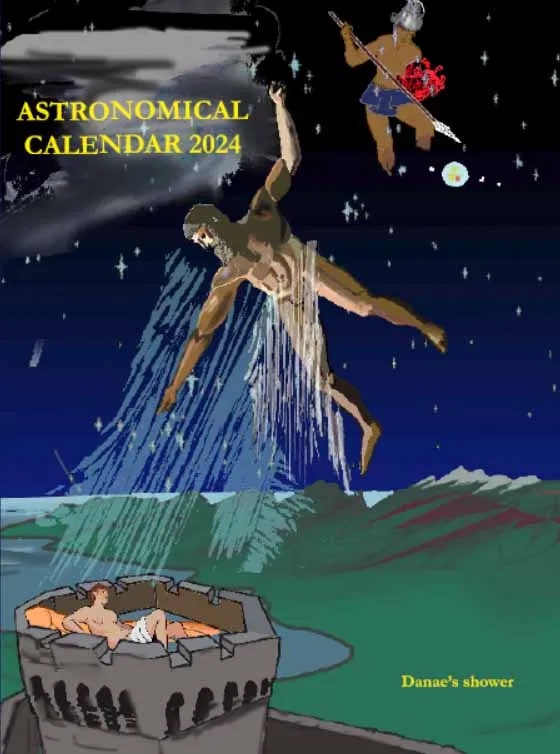
Bottom line: Visible planets: Venus dominates the morning sky. Jupiter is visible most of the night, Saturn sets late evenings and Mercury is low on the western horizon. Visible planets and night sky, here!
Like what you read?
Subscribe and receive daily news delivered to your inbox visiting EarthSky.or
22nd: Winter Solstice (Winter begins at 7:27 P.M. PST)
Snake Look-Alike: Pacific Slender Salamanders (common in urban, suburban, and rural areas) Present in a Neighborhood Near You
Pacific slender salamanders are active underground from April or May until November or December when California’s initial “winter” season rains sometimes begin. After the first rains occur, when moisture and temperature conditions are favorable, they increase surface activities. Normally, they are active at night, and return to cover during daylight. If exposed to periods of extended rainfall, they may remain on the surface during the day to feed. Surface activity is limited by extremes of temperature and unfavorable moisture conditions.
Feeding Winter Birds
In some potentially inclement northern California locations (especially inland), now’s the time to make sure you have a waterproof, shock-proof heater to place in a backyard water pan or birdbath so that when overnight temperatures dip below freezing the birds still have a water source for drinking and bathing. Look for them at Wild Bird Center outlets (a national chain of stores).
Basking Garter Snakes
On warm days, look for the common and widespread Western Terrestrial Garter Snake. Sometimes you’ll see them basking in the sun at the entrances of hibernacula where snakes gather together during the winter to preserve and conserve their body temperatures as temperatures plummet. Likely places to see them extend from the Oregon border south throughout northern California and south to southern Santa Barbara Co., in addition to various locales in the Sierra Nevada mountains south to southern Tulare County. Courtship begins in spring soon after their emergence. Seven to 30 young are born in July and August.
Four Thrush Species Occur Here in Winter?
Which thrush family members are you likely to see during the winter in northern California? In the Bay Area, for example, look for Hermit Thrush, Varied Thrush, American Robin, and Western Bluebird. The initial two on the list are especially breathtaking to view, as their abrupt entrance onto the landscape is punctuated with their subtle hues of rust and orange. The eerie, shrill, one-note song of the Varied Thrush adds additional intrigue to the damp forests they inhabit while only temporarily visiting our area during the winter.
Strangely, though the Hermit Thrush is seen throughout the year in Marin County, it’s probable that the individuals we see during the non-breeding season arrived here from where they breed farther to the north as far as Alaska. During the summer (after migration), Hermit Thrush in Marin County are uncommon and found only at higher altitudes where they breed sporadically throughout the county.
How Many Salamanders Can You Find?
From now through late winter, look for seven species of salamanders that live in the San Francisco Bay area. Perhaps the most common to see is the California slender salamander, which looks like a large worm with tiny legs. Look for them in damp places, especially under logs and in leaf litter. The six other species to find are the arboreal, yellow-eyed, Pacific giant salamander and three newts: California, rough-skinned and red-bellied. The California newt is the most common one to see nearby and within Marin County riparian/creekside areas (while rough-skinned is the next most common species that I see; red-bellied is much less common and is restricted to portions of the coastal areas of Marin County.)
Backyard Feeder Advice
Simplifying the best and most efficient ways to feed backyard birds throughout the winter is not easy. However, if you were forced to choose two of the best foods to feed birds, the best choices are black sunflower seeds and niger thistle. Both have been proven over the years to attract a more diverse group of winter avian visitors than other food options, such as millet, cracked corn and striped sunflower seeds. Suet (either chicken or beef) feeders are also usually successful in attracting chickadees, nuthatches and various woodpeckers.
Irruptive Birds Erupt On The Landscape
Non-seasonal movements of birds, or “irruptions,” may begin occurring around now through the rest of winter, depending on the supply of food in a bird’s normal range. Without adequate mast crops of spruce and pine cones, some finch family members (Red and White-winged Crossbills, Pine Grosbeaks, Evening Grosbeaks, Pine Siskins, Common Redpolls, Hoary Redpolls) may appear farther south in the East, Midwest and Mid-Atlantic than in years when normal tree seed harvests are present. “Short-stopping” is another term applied to these bird species that roam farther south during some winter seasons in search of resources, “(short) stopping” when they find food, often at backyard feeders that remain a loitering spot for extended periods. Evening Grosbeak fits the bill (bada bum; sorry! ) as a “short-stop” species, with occasional to frequent localized sightings of it in the Midwest and West in 2010-11 illustrative of their nomadic tendency during the non-breeding season.
Detecting these “irruptive” movements to the south is sometimes easier if your feeders are filled with niger thistle seed, a favorite substitute feed source for many of these wayward winter species. As a word, “irruptive,” is appropriate because it means “bursting in” or “surprise,” in the way these irruptive species catch us off guard when they make their cameo appearances. In Marin County where I live, irruptions are not necessarily the appropriate term to apply to the red crossbill and pine siskins appearing on the landscape, given these birds nest in the state. Detecting them remains rare to occasional only because they are nomadic in their behavior while searching vast areas for abundant food resources.
Offering niger thistle as a backyard feeder food in the Bay Area is an excellent way to see pine siskin during the winter. I’ve never seen Red Crossbill at my feeders nor heard of other folks attracting them to California feeders.
Courting Owls
Courting Great Horned owls soon begin laying their eggs, with babies hatching by January (or February) throughout much of this bird’s vast North American range. Be careful while attempting to hear their vocalizations by mimicking their calls. All birds, including owls, are known to feel stress when provoked to investigate an incoming airwave encounter they did not expect. In addition, using a recording of a Northern Pygmy or Western Screech Owl, for example, may also create similar anxiety among owls. As a result, owl calling should be limited to rare occasions and only for a few minutes at an area you visit.








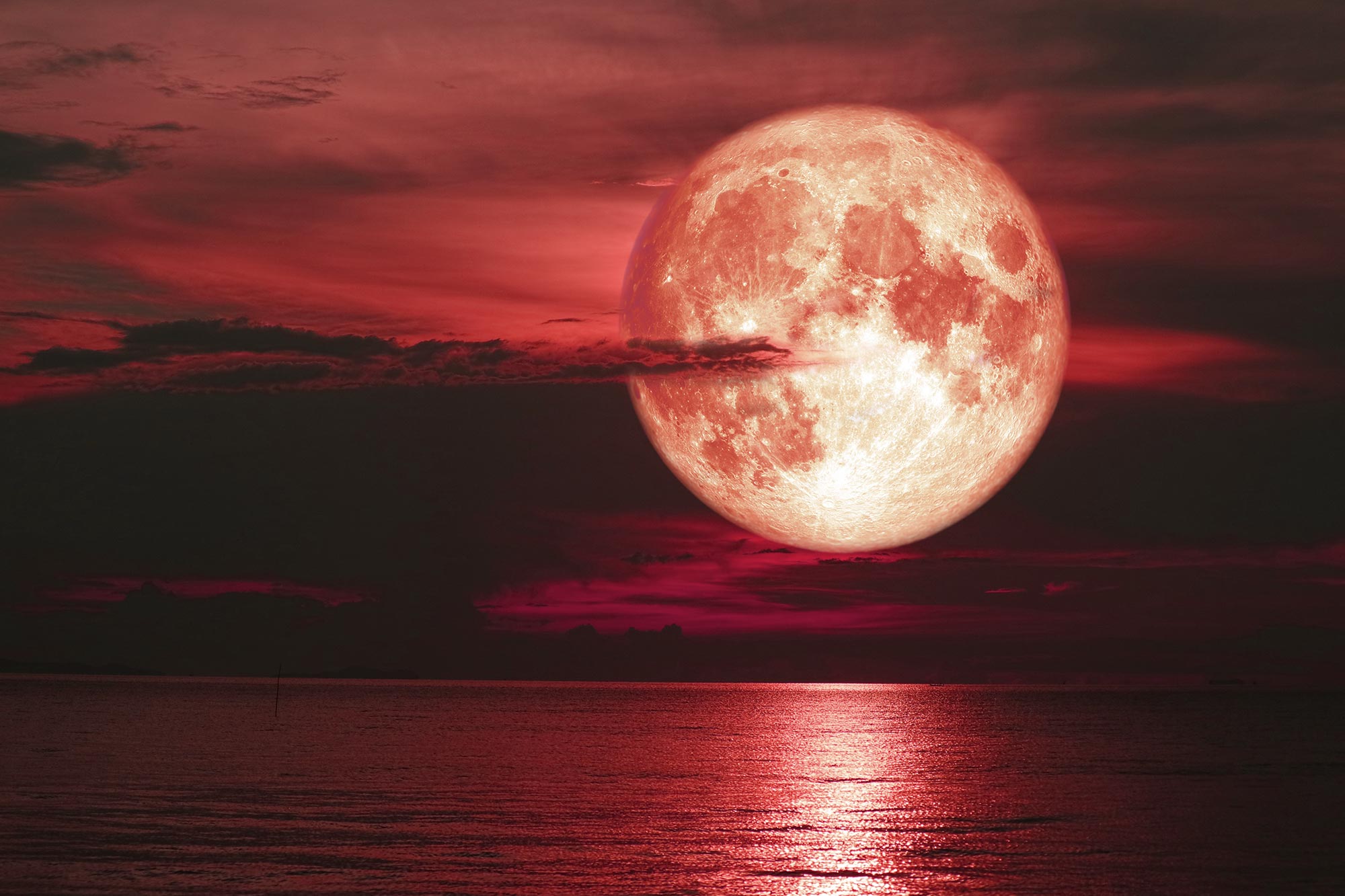
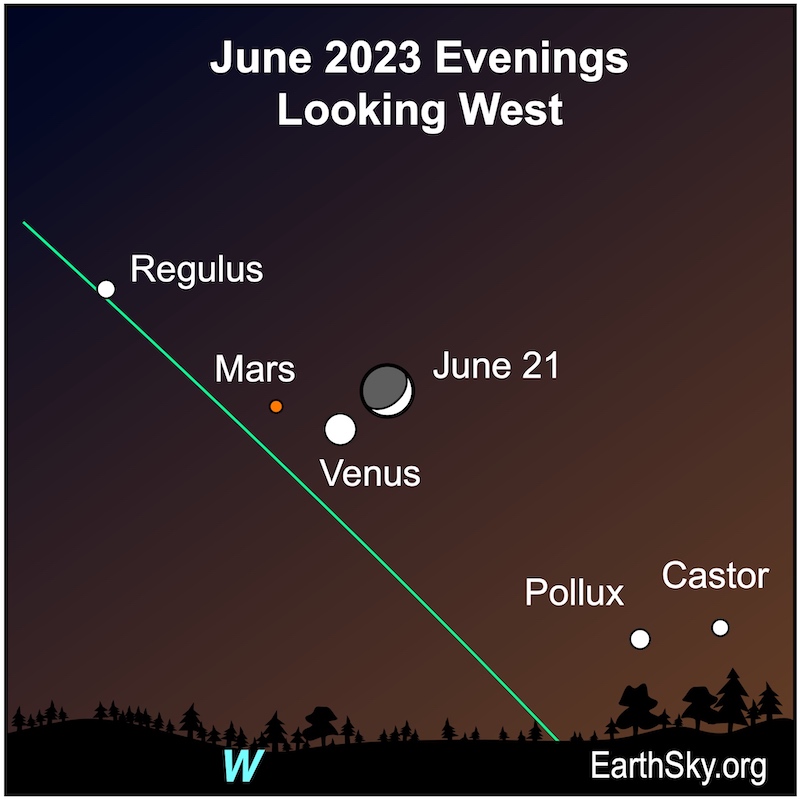
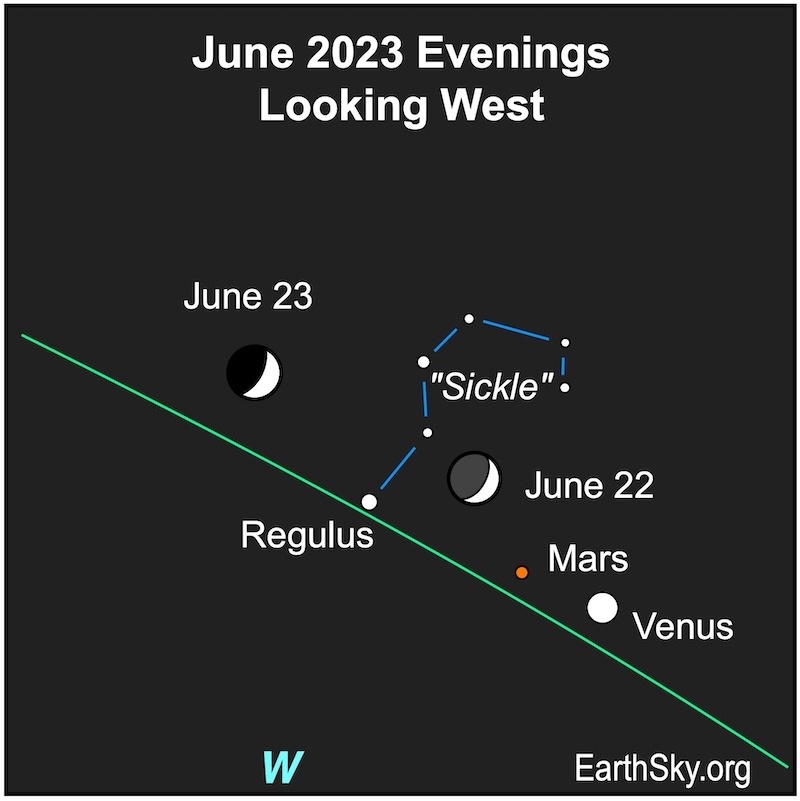




You must be logged in to post a comment.